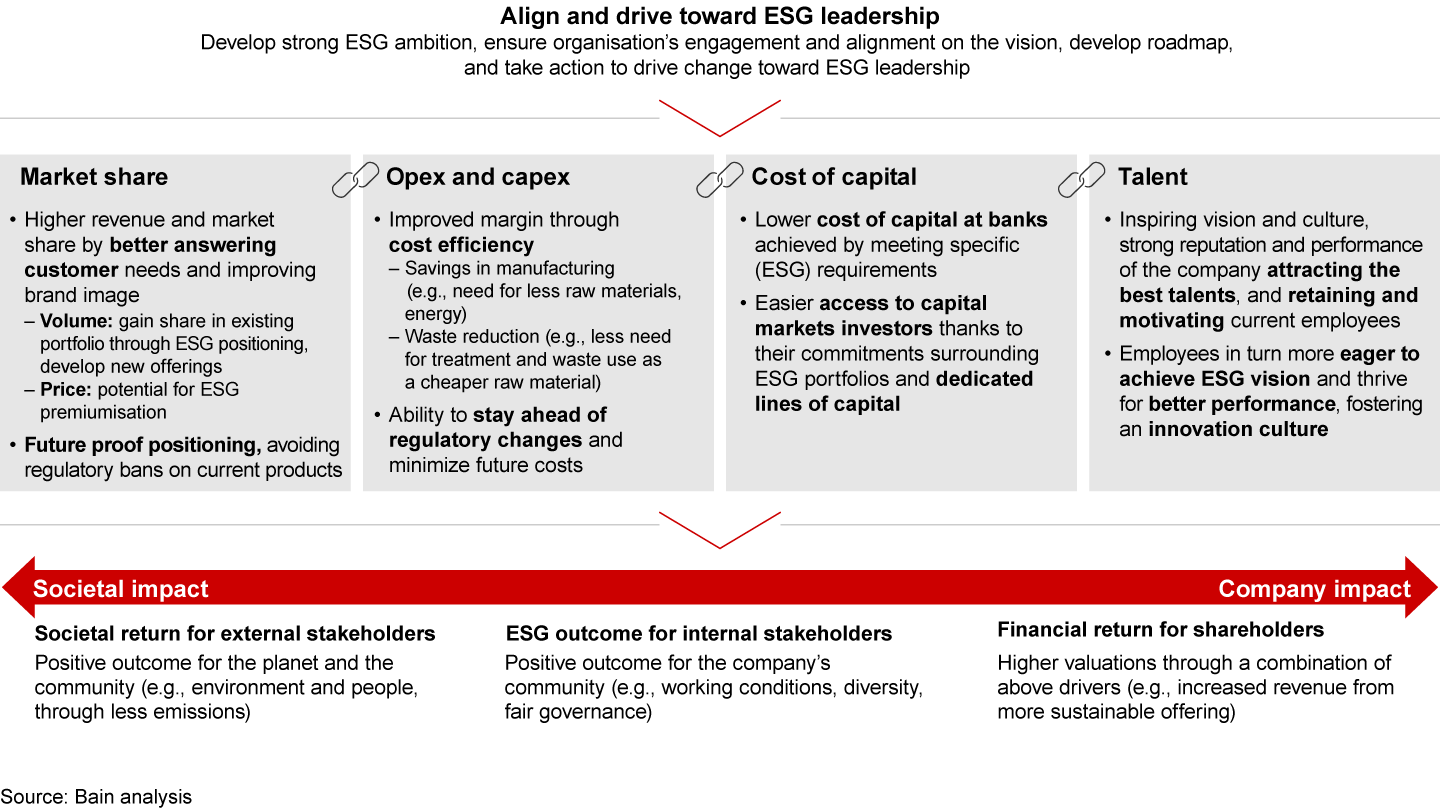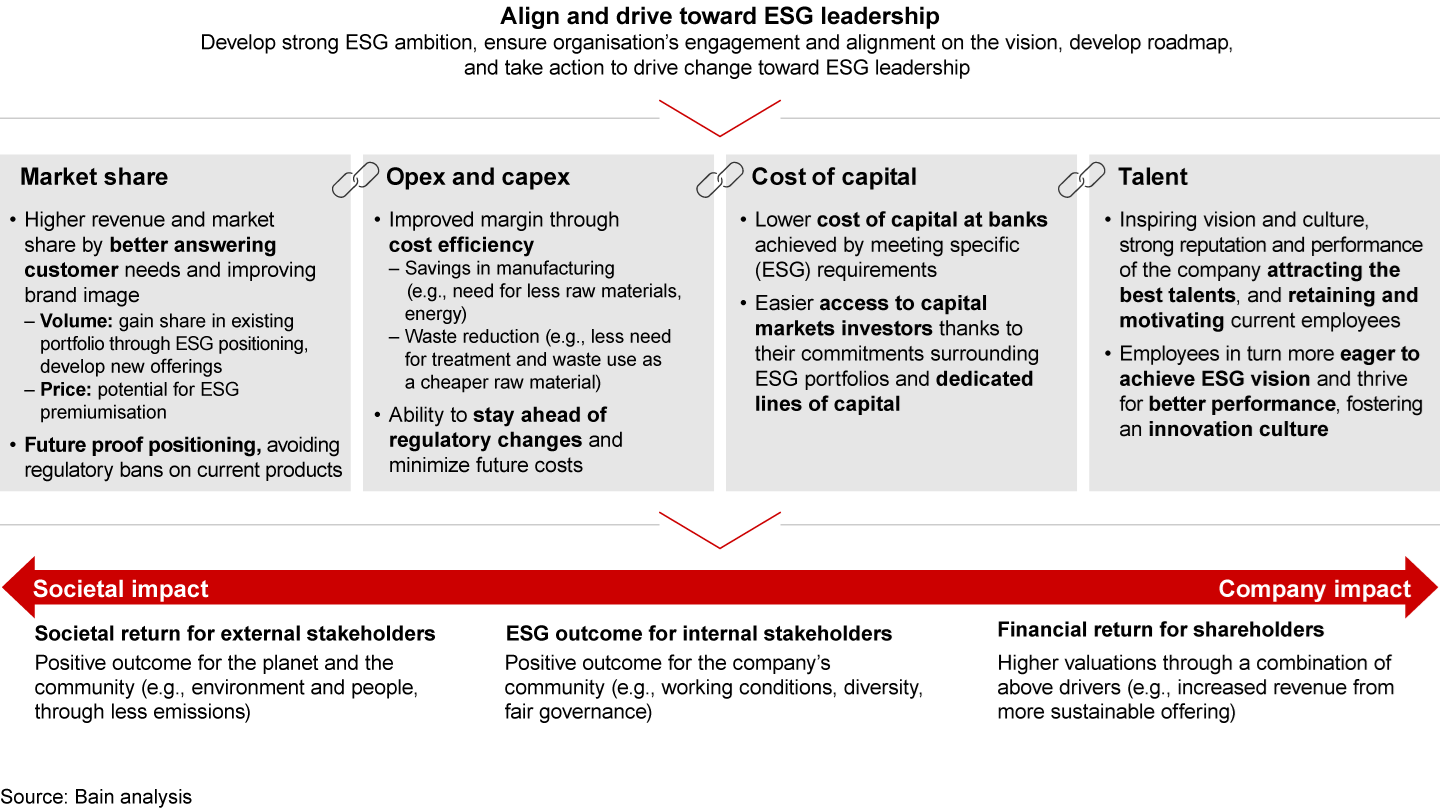Report

2021 has been a banner year that saw India private equity (PE) and venture capital (VC) bounce back from a pandemic-induced slowdown with fury. Reaching approximately $70 billion in investments, the PE-VC market was buzzing with frenetic deal activity and a complementary acceleration in exit momentum. While the first half of the year stuttered as India faced a devastating second wave of Covid-19 and experienced lockdowns and various uncertainties, the economy shifted back into gear in the second half in a quick rebound as a rapid vaccination rollout was undertaken.
Written in collaboration with
Written in collaboration with
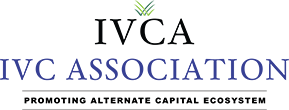
Indian investments grew faster in 2021 than most major economies, including China, with 96% growth over 2020 (excluding the mega deals of Jio Platforms and Reliance Retail). Coupled with the flight of capital away from China due to political uncertainties, the growth helped India increase its share of the overall Asia-Pacific (APAC) market—a signal of a trend expected to continue. India looks to consolidate its position as the market of choice for investors in what can be seen as a phase transition for the market. The country has demonstrated political and economic stability, coupled with a confluence of various factors enabling depth in the investment ecosystem—a maturing investments landscape with diversity of fund sizes and types, improving asset quality and governance, an abundance of ready capital, and a vibrant market for exits. 2021 was a milestone year for India, and a slight moderation should be anticipated as the market looks to consolidate the year’s wins and step into a new phase, with higher deal values and wider exit opportunities supported by a larger pool of quality assets.
Many records were set and milestones were reached in 2021 for the Indian PE-VC market, with:
- Record velocity of deals, with over 2,000 deals closed compared to almost 1,100 each in the two years prior;
- A quadrupling of exit momentum to $36 billion, with huge exits across sectors as valuations inflated further;
- A massive increase in venture capital (VC) and growth equity expanding to $38.5 billion, in almost a 4x jump from 2020, that took its share of overall investments to greater than 50%;
- An expansion in buyouts deal value by 5x to over $16 billion as the average value of deals tripled since 2016, reaching more than 50% of the share of PE investments; and
- A host of new-age businesses listing on public exchanges this year (Zomato, Nykaa, etc.), complemented by the appetite shown by Indian retail investors for new-age business models as these IPOs got oversubscribed.
2021 saw many themes from the previous years continue. The strong deal flow from previous years continued and accelerated even further, with an 87% increase over last year’s volumes. The number of large cheque size investments also witnessed a significant increase. 11 investments of more than $1 billion were seen in 2021, compared to 6 in 2020. Much of 2021’s deal activity was in consumer tech and IT/ITES, an indication of the expanding share of growth captured by the tech and internet sectors. The two sectors combined represented more than 60% of the year’s deal value at nearly $44 billion, and represent the sector’s resilience and attractiveness through uncertainties as business models in these sectors adapted faster than traditional models in other sectors. Further, VC and growth equity surpassed all growth estimates, soaring to $38.5 billion from approximately $10 billion in 2020.
In parallel, the momentum in exits and the shift away from China were new trends that unfolded. Secondary sales, public market exits, and strategic sales all picked up, and the average size of exits across these routes have seen a significant expansion since 2019. 2021 also saw a massive increase in valuations, as a seller-friendly market emerged with huge multiples for heightened growth, especially in the tech and internet sectors. Another important trend was the attention to environmental, social, and governance (ESG) criteria in investing, as assets under management (AUM) for ESG funds scaled up. This trend is expected to accelerate in the coming years as ESG becomes the norm rather than the exception. A survey amongst Indian funds revealed that they expect ESG considerations over their PE AUM to grow to 90% in five years from now, up from 39% five years ago.
Led by Carlyle’s $3 billion deal into Hexaware and Blackstone’s $2.8 billion Mphasis deal, IT/ITES witnessed a significant expansion in 2021. Larger deals were unlocked in 2021, and valuations were higher by 25%–30% over past averages. Five deals of more than $1 billion were also seen for the first time in a single year in the sector. The IT/BPO subsector saw significant traction within verticalised business niches and benefited from the convergence of tailwinds enabled by pandemic-induced business transformation agendas. Market opportunities in digital IT services are expected to grow at 18%–20% and will invite larger investments into the sector.
Healthcare witnessed increased traction in 2021. Healthcare provider activity picked up from 2020’s lull as Covid-induced operational stresses reduced, while pharma managed to maintain the deal values unlocked last year. The provider space, including hospitals, single speciality formats and diagnostics grew 2x over 2020’s invested value, with the Manipal-NIIF and Apollo-Sands Capital deals driving a significant chunk of the deal value. The sector is driven by five discernible themes such as scale through consolidation, niche speciality play, out-of-hospital (or daycare) formats, high-end speciality diagnostics & AI, and platform play for operational efficiencies.
In the most celebrated milestone for 2021, exits worth more than $36 billion were unlocked. Strategic sales constituted 50% of the exit volumes, while the share of value was almost equally split across secondary sales, public market exits, and strategic sales. Strategic sales were anchored by a few marquee deals, such as BillDesk acquisition by PayU at $4.5 billion and Tata’s acquisition of Bigbasket at $1.3 billion. However, initial public offering (IPO)-led exits stole the show in 2021. In a significant milestone, the Securities and Exchange Board of India relaxed norms for loss-making firms to list on the public bourses, paving the way for future public market exits and clearing a significant roadblock that had existed for years. In a vindication of the importance of this move, public market exits worth $11 billion took place, expanding by $7 billion over 2020’s value. This is further emboldened by the 95% year-over-year (YoY) growth seen in average value of exits via the public market route. Exit multiples continued to increase with the average reported multiples growing by 20% to 5.6. Key exits in consumer tech, IT, and BFSI, such as TPG-Nykaa, Baring-Hexaware, and Carlyle-SBI Cards significantly surpassed the average. Furthering the moderation of public markets due to inflation and global uncertainties, exit momentum is expected to temper in the near term, especially with the portfolio age for major funds declining post-2021’s activity. The depth witnessed in the exits market across all routes in 2021 is expected to provide buoyant exits in the longer term, after a temporary slowdown.
The competitive landscape within PE is undergoing some important shifts as the Indian market becomes more mature and the number of active funds increases. The competition within funds and increased participation of limited partners (LPs) are driving up valuations and making deal sourcing and faster execution increasingly critical. Funds are shifting their strategy to adapt to these changes by expanding cheque sizes, investing in deeper target relationships, and increasing value-creation capabilities, especially by setting up portfolio teams. Traditional funds are increasingly seeking
buyout opportunities, with Blackstone, Baring, Carlyle, Advent, GIC, and KKR each investing more than $1 billion each in buyouts over the last three years, with an increasing outlay over years. Buyouts are attractive as they give funds more control over value creation for high-value deals—enabled through operational turnarounds and deep sectoral focus. We expect to see more such differentiated fund strategies as India’s market attracts more investors.
As India-focused funds look toward the next phase of the Indian investments ecosystem, they are looking to embrace ESG toward meeting net zero and responsible investing goals. Leading funds are expected to pave the way for other funds to follow toward improved shareholder return while maintaining or improving the resilience of immediate stakeholders and society. The path forward will see funds generating differentiated value from their ESG interventions as they pivot from a risk mitigation view of ESG to a value-creation view of the same, and we expect ESG leadership to emerge as a key priority for funds going forward.
After an exuberant year for both deal activity and exits in 2021, the outlook for 2022 is expected to be sobering. The global economy entered 2022 coping with macro stresses of runaway inflation, global political uncertainties and escalating tensions, supply chain disruptions, and calls for urgent climate action. The market sentiment has been further dampened by the crash in blue chip tech stocks in the public markets which has eroded the optimism around tech & internet businesses that saw them at extremely high valuations in Q4 2021. Domestically as well, funds in India are anticipating corrections from last year’s high valuations and frenetic activity across deals and exits. We anticipate a significant tempering of pace as these macro and micro trends converge, but see this as an opportunity for the consolidation of last year’s gains which should make India see annual PE-VC deal values of around $50+ billion more frequently.
Already in 2022, even as the bullish sentiment has waned, more than $24 billion of PE-VC investments in ~630 deals were recorded by May (vs. 775 for ~$19 billion in value by May 2021), riding on last year’s momentum. However, VC and growth equity have slowed significantly, with 20% lesser deals this year compared to last year’s run rate of 130 deals every month. Average VC cheque sizes have also declined from $25 million to $20 million. On the other hand, private equity continues to demonstrate strength with deal count per month growing by around 27% over an annualised base of 165 deals. The average realised cheque size of $168 million this year keeps PE deals within the range of $150–$200 million seen over last five years. An important reversal of trend that is expected to last is the dampening of the vigorous exit activity of 2021 which saw exits grow 4x to $36 billion. This year has seen exit activity of $5.9 billion so far, in a 56% decline over the last year’s activity over a similar duration—and the exit activity is expected to weaken further. The bearish sentiment in public markets coupled with the younger portfolios of top funds could see exits dip to pre-2021 stages again. Even though the pace of deals is slowing down, large funds like Baring, TPG, ChrysCapital, ADIA and Warburg Pincus continue to keep pace with their activity over last year, vindicating confidence in the fundamentals of the Indian market.
How did 2021 unfold?
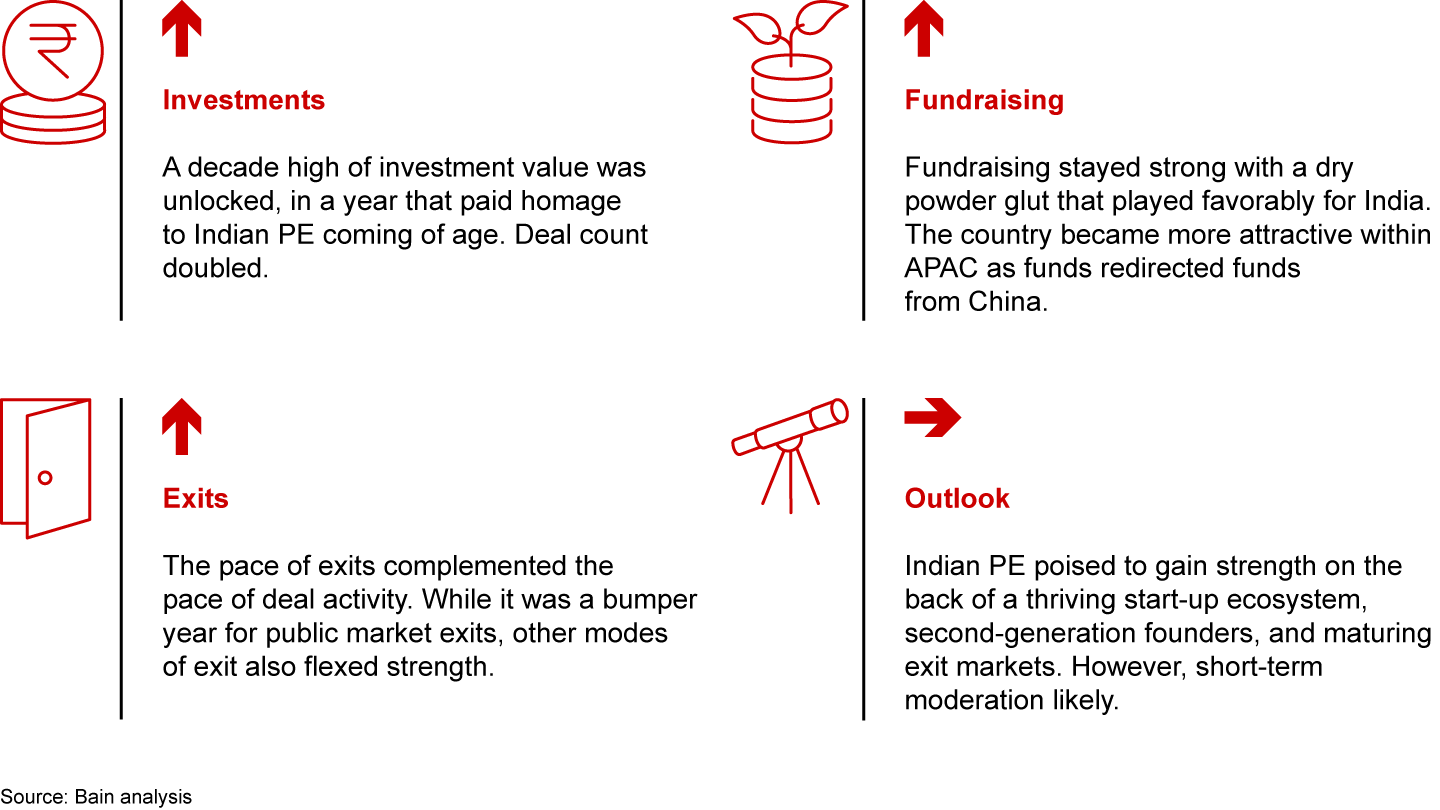
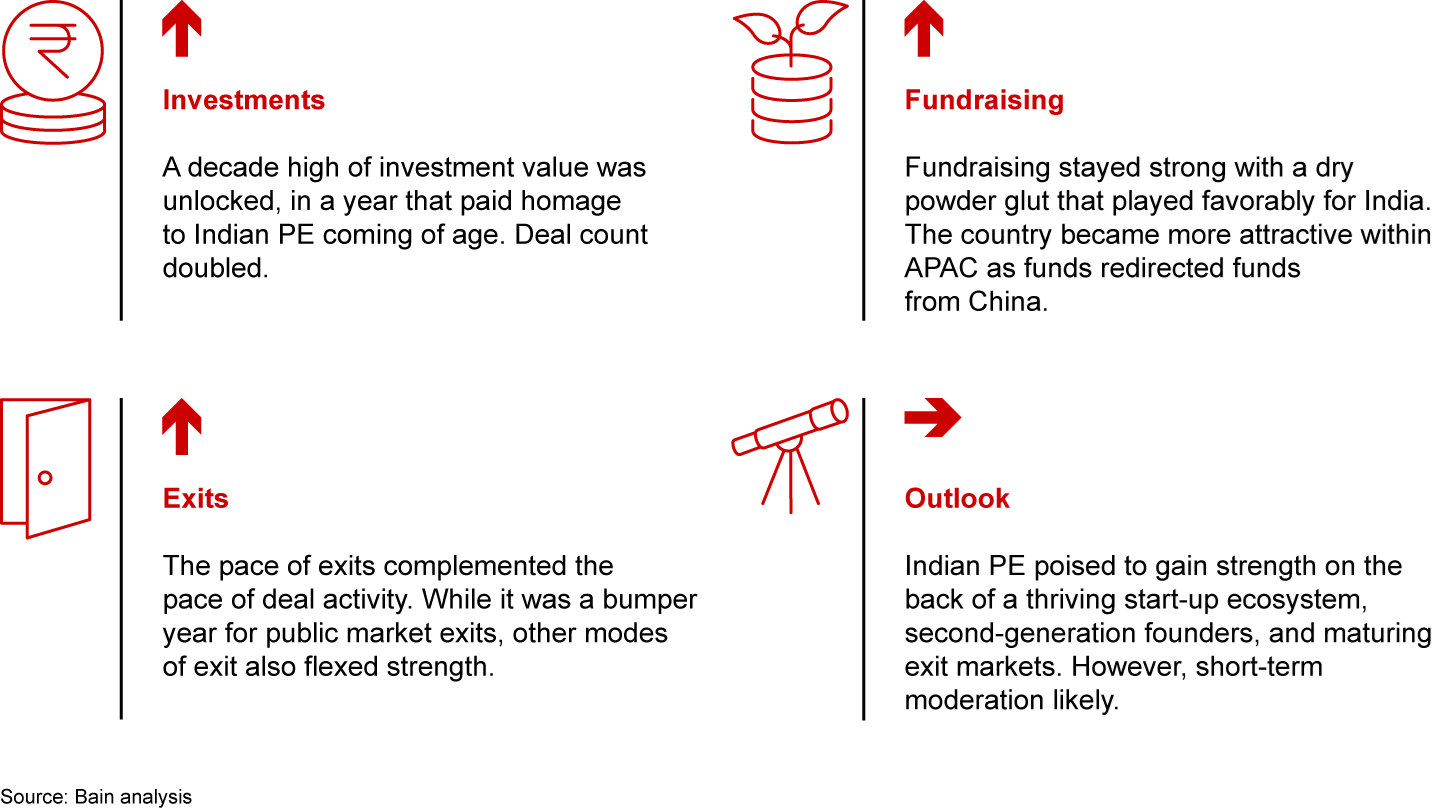
Indian deal activity surpassed growth witnessed by global peers in 2021
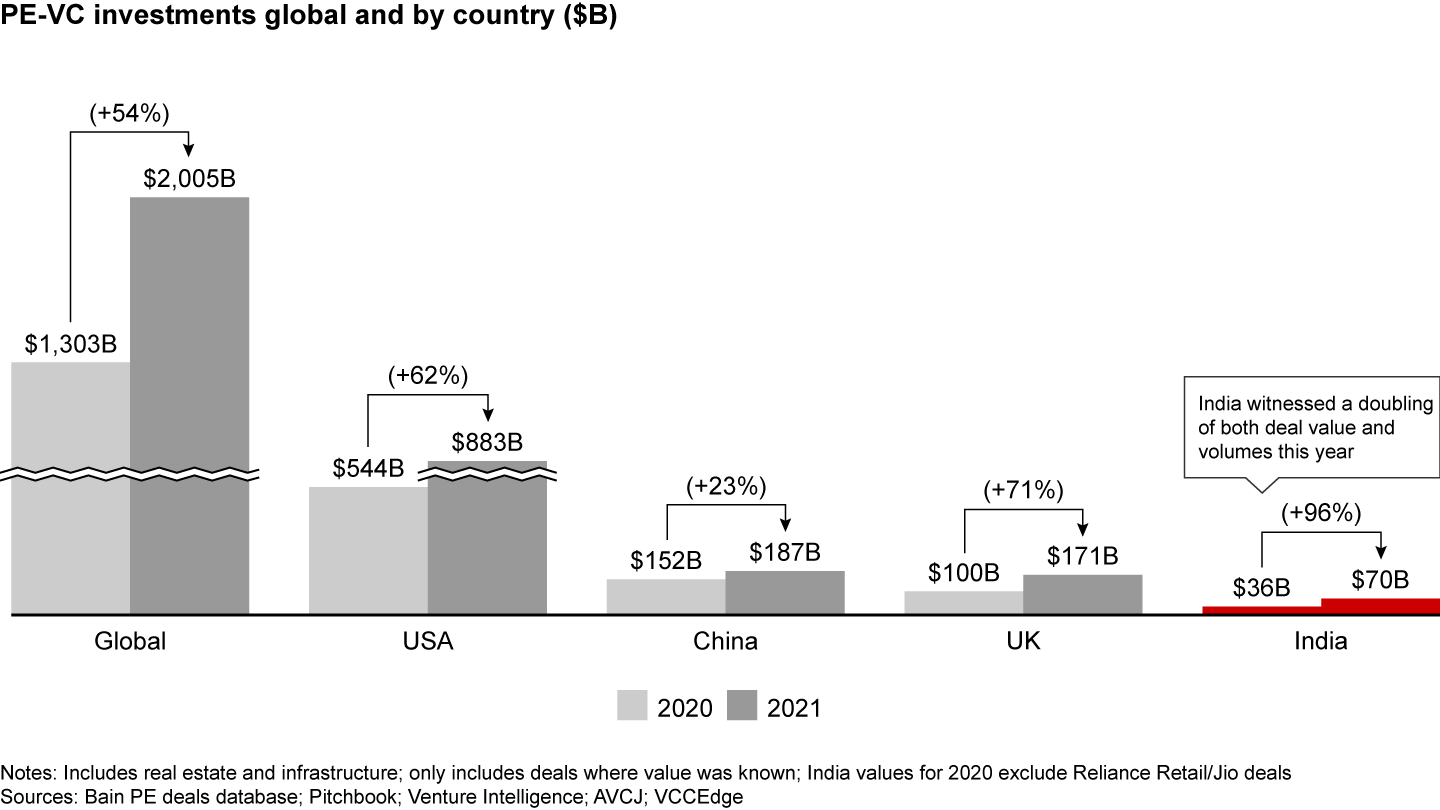
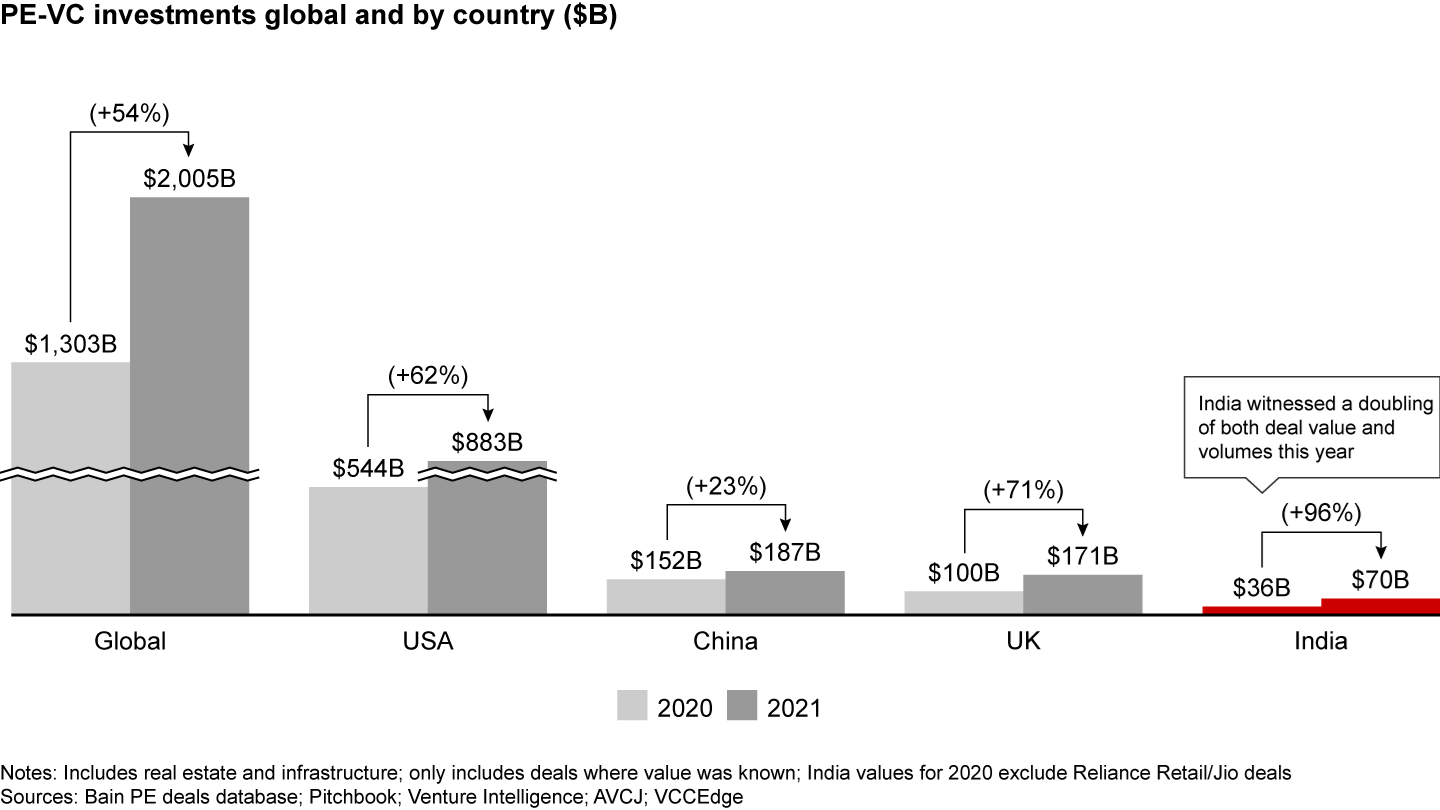
PE-VC investments in India reached ~$70 billion, in a resounding bounce back from Covid-driven restraint
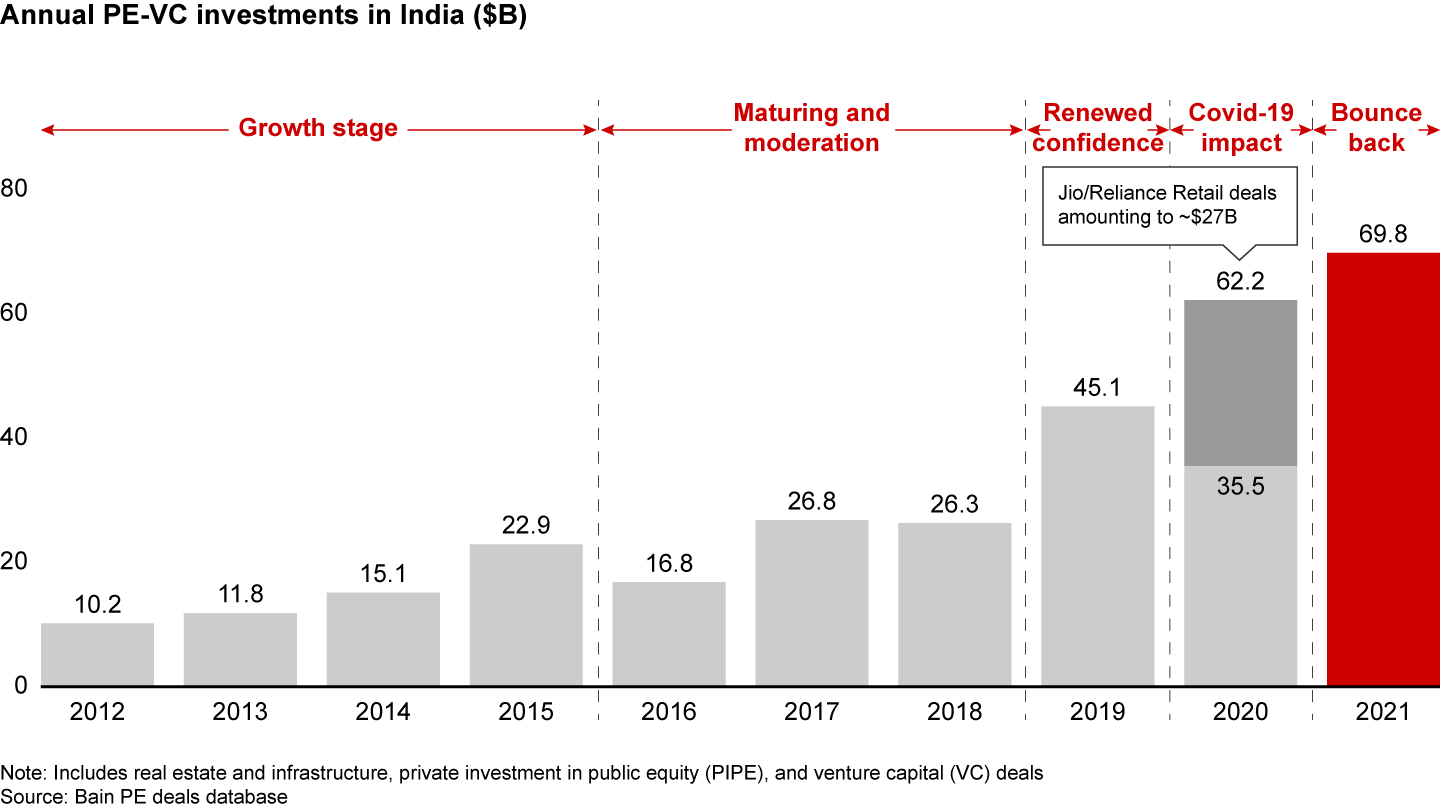
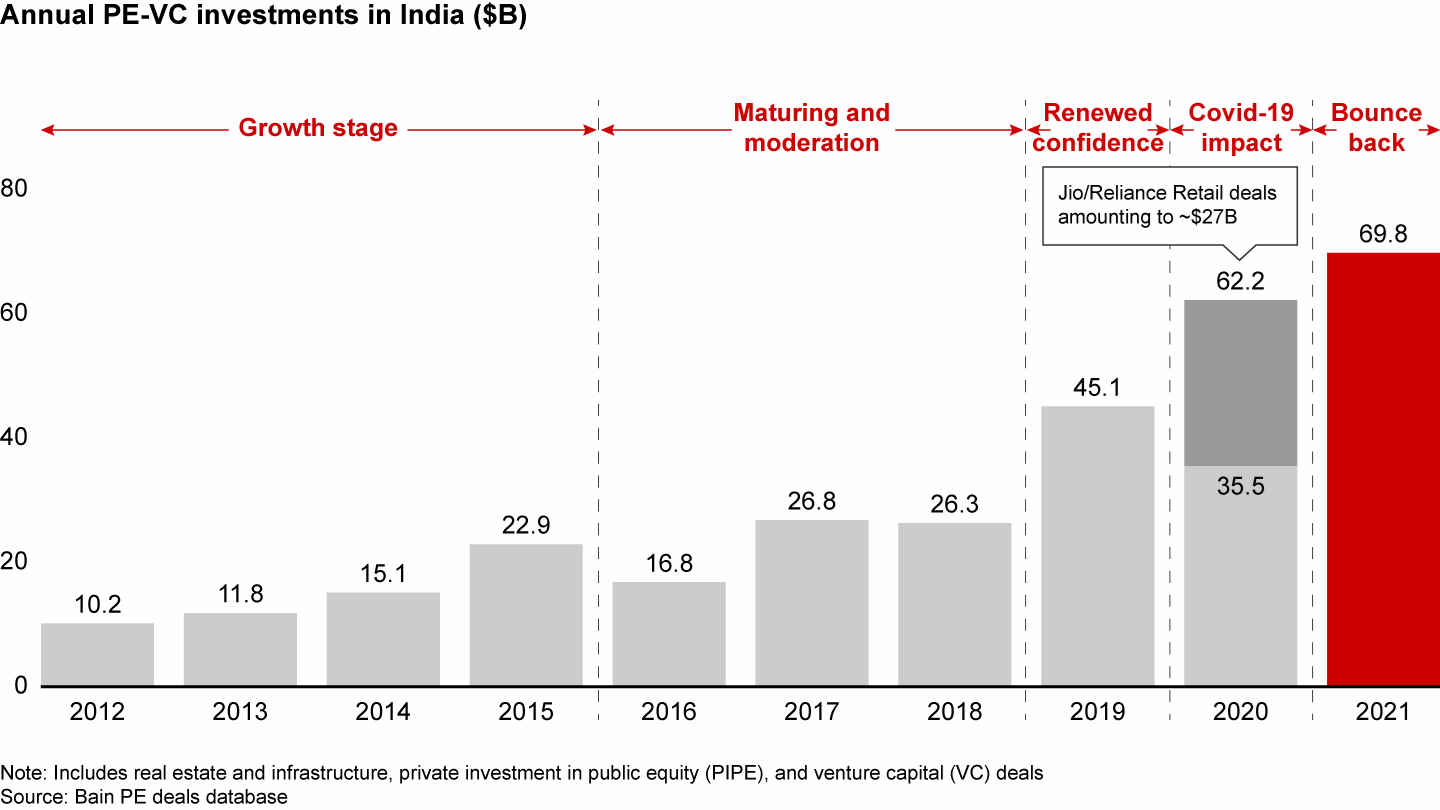
What stayed the same—Trends that continued to hold true
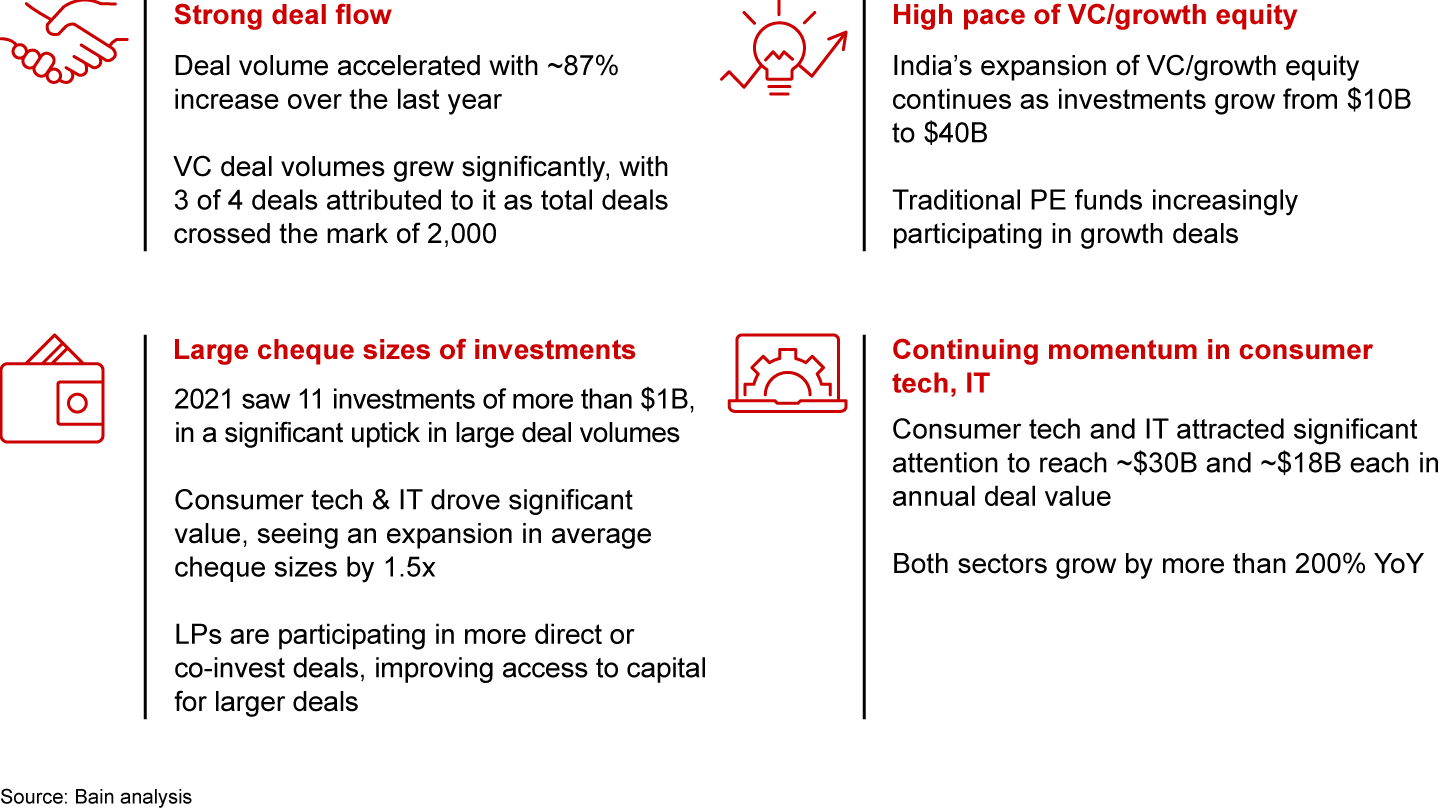
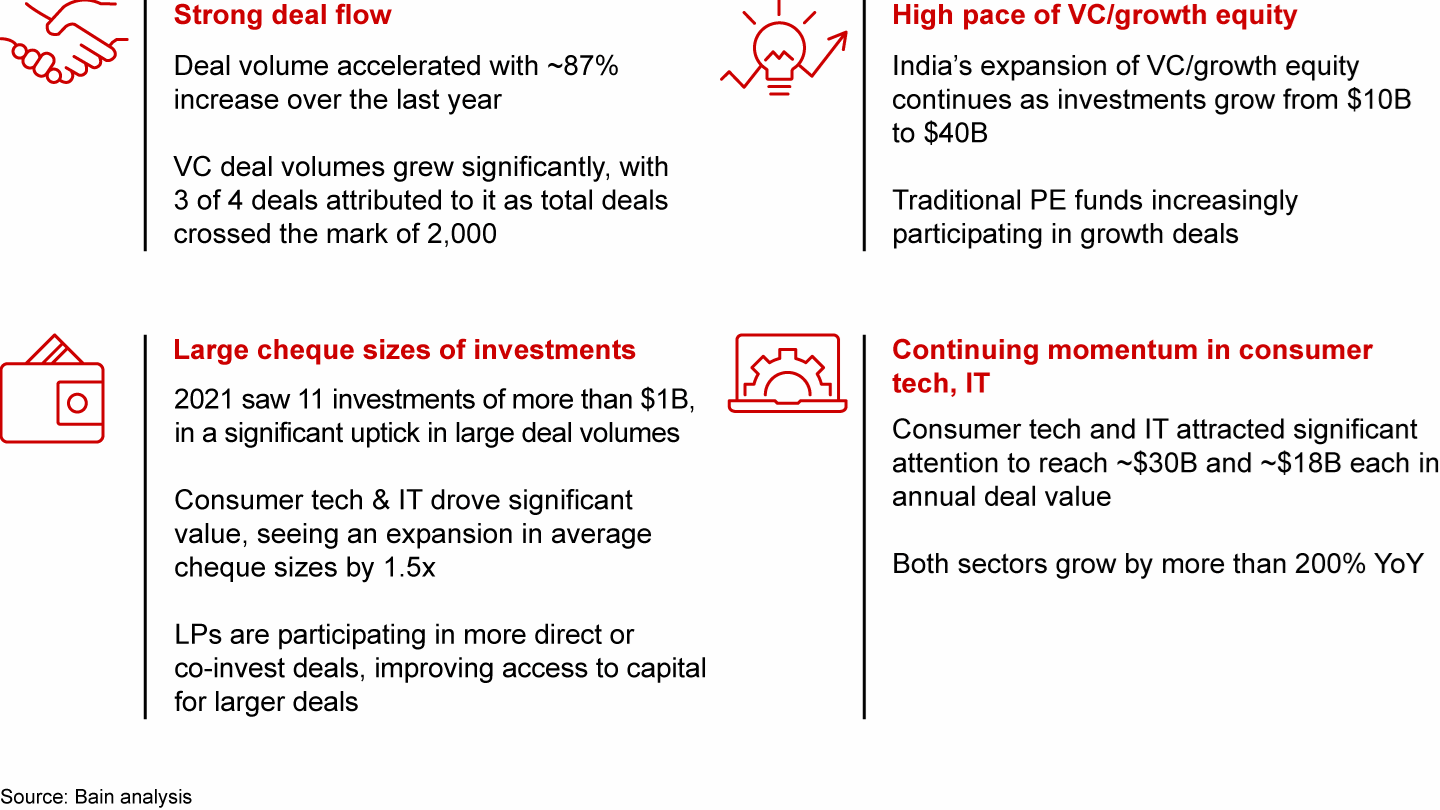
What changed—Things that were different in 2021
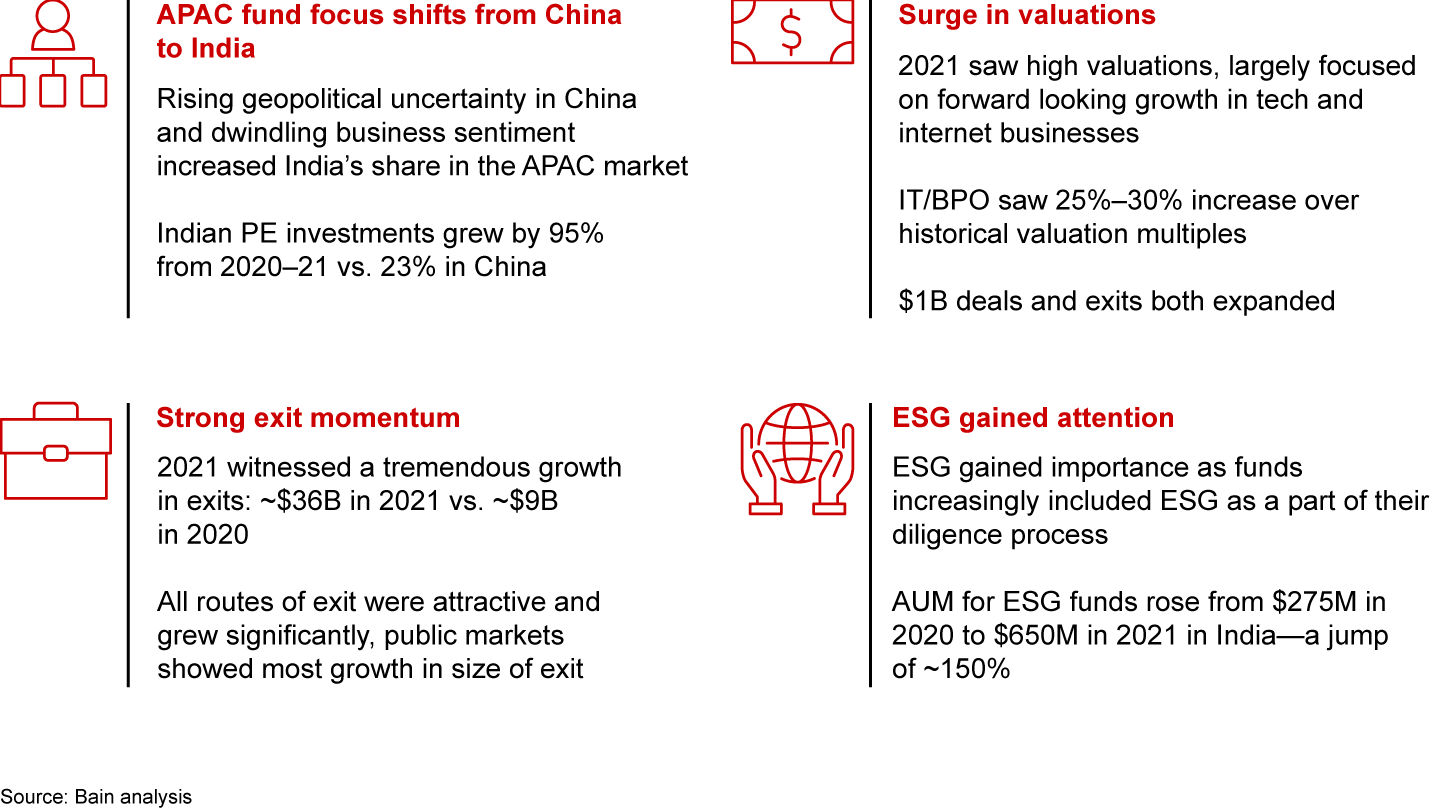
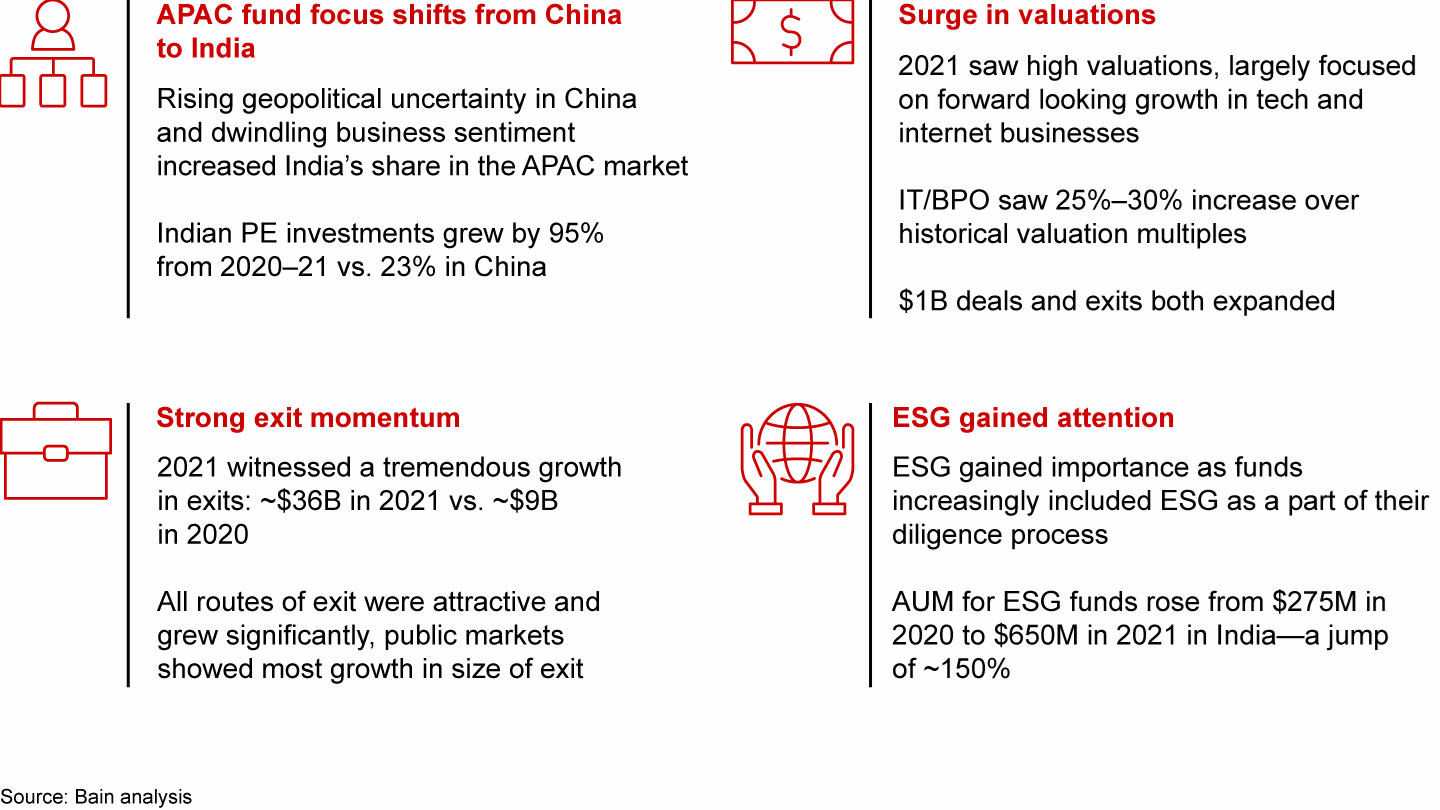
Deals landscape: A year of milestones
- PE-VC investments had a banner year in 2021 to reach an all-time peak of $69.8 billion, seeing a growth of 96% over the previous year’s deal values, excluding the mega-investments of Reliance Retail and Jio Platforms.
- Deal volumes nearly doubled to 2,000 from an average of 1,100 deals over 2019 and 2020, with the growth in volumes contributing nearly 96% to the growth in deal value seen in 2021, with minimal contribution from deal size expansion.
- VC and growth equity zoomed 4x to reach nearly $40 billion—reaching a 55% share of overall PE investments.
- Buyouts also picked up further in 2021, crossing $16 billion in value, with a significant expansion in the size of cheques. However, the number of deals in 2021 was tempered compared to 2020.
- The volume of large deals (>$100M) expanded significantly, growing by 95%, while the average cheque sizes remained similar to the last year.
- In a significant step up, 11 investments greater than $1 billion were seen compared to 6 in 2020. The average value of the top 15 investments grew by 50% to $1.5 billion.
- Consumer technology and IT/ITES accelerated the momentum from the last year and accounted for greater than 60% of 2021’s deal value. The growth witnessed in just the two sectors accounted for approximately $32 billion of the $34.1 billion growth in overall deal value.
- Consumer technology saw a surge in interest in VC and growth equity, with verticalized e-commerce, fintech, and gaming subsectors growing more than 5x. IT/ITES investments were driven by big-ticket investments in IT/BPO subsectors, with the top five deals accounting for about $10 billion in deal value.
- Traditional sectors such as RE & infra, manufacturing, energy, and telecom slowed down, seeing muted deal activity.
- Top funds stepped up their investment outlay from the moderation seen in the last year, and they increased the average size of deals.
PE-VC investments reached close to $70B, as deal volumes doubled
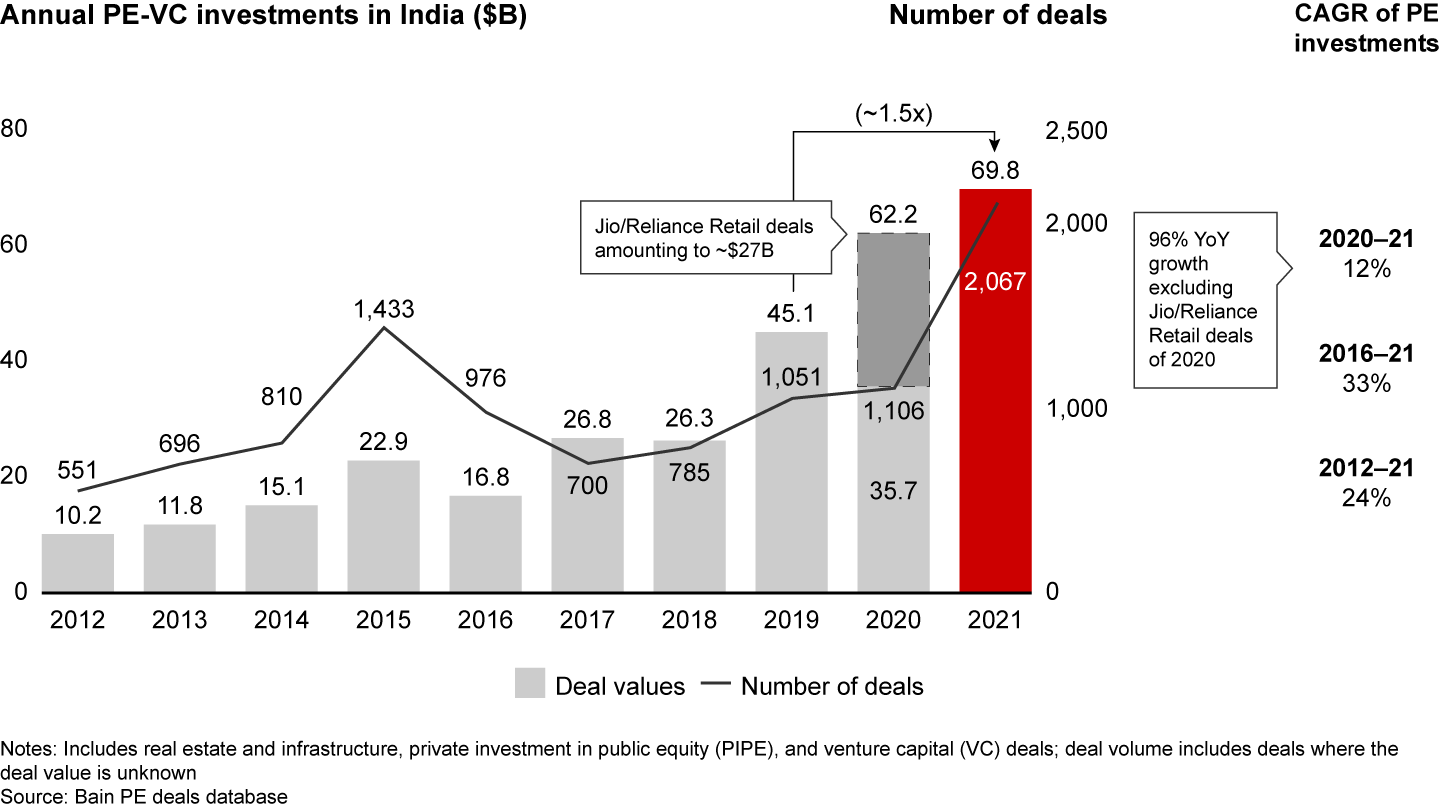
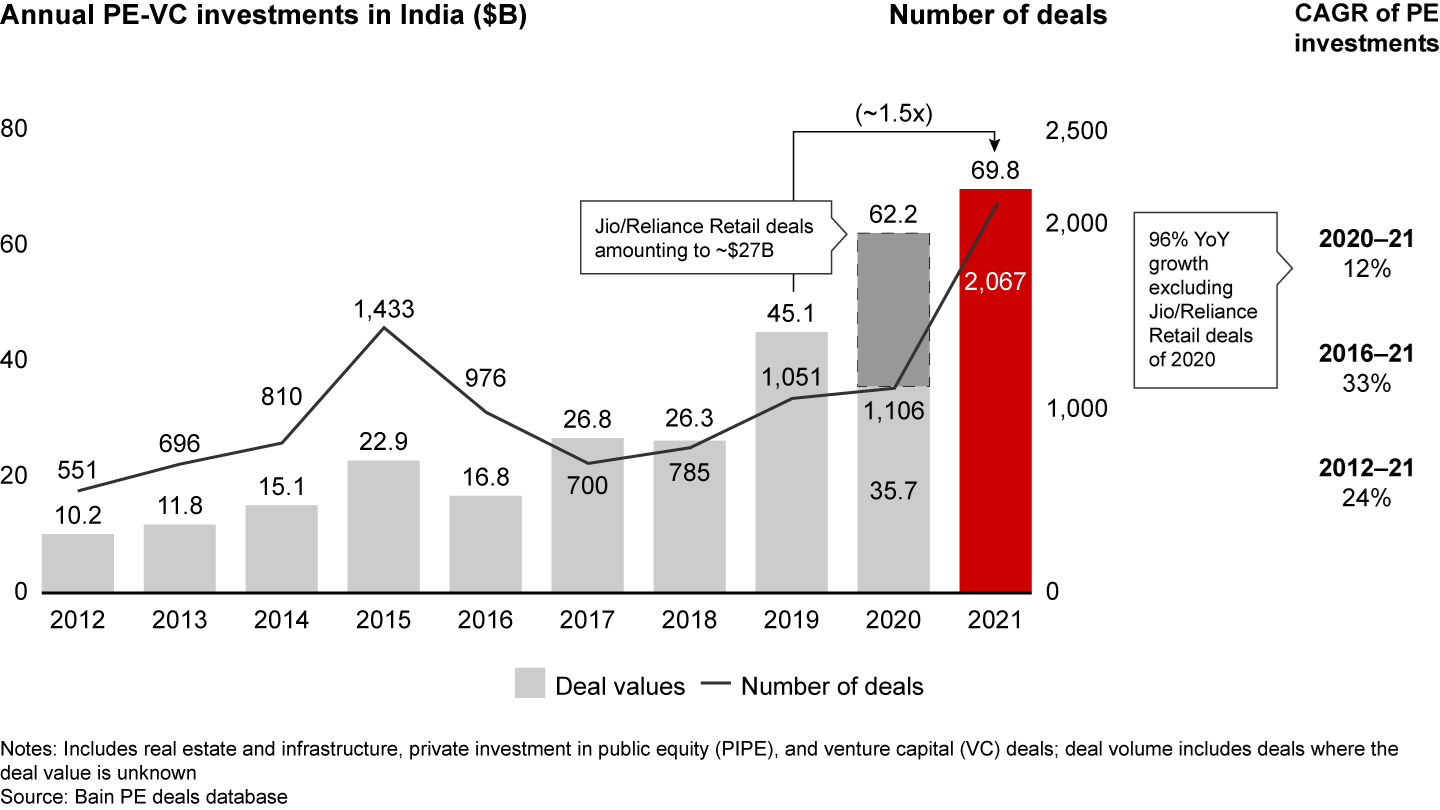
PE investments strengthened to $31B in a steady growth in value
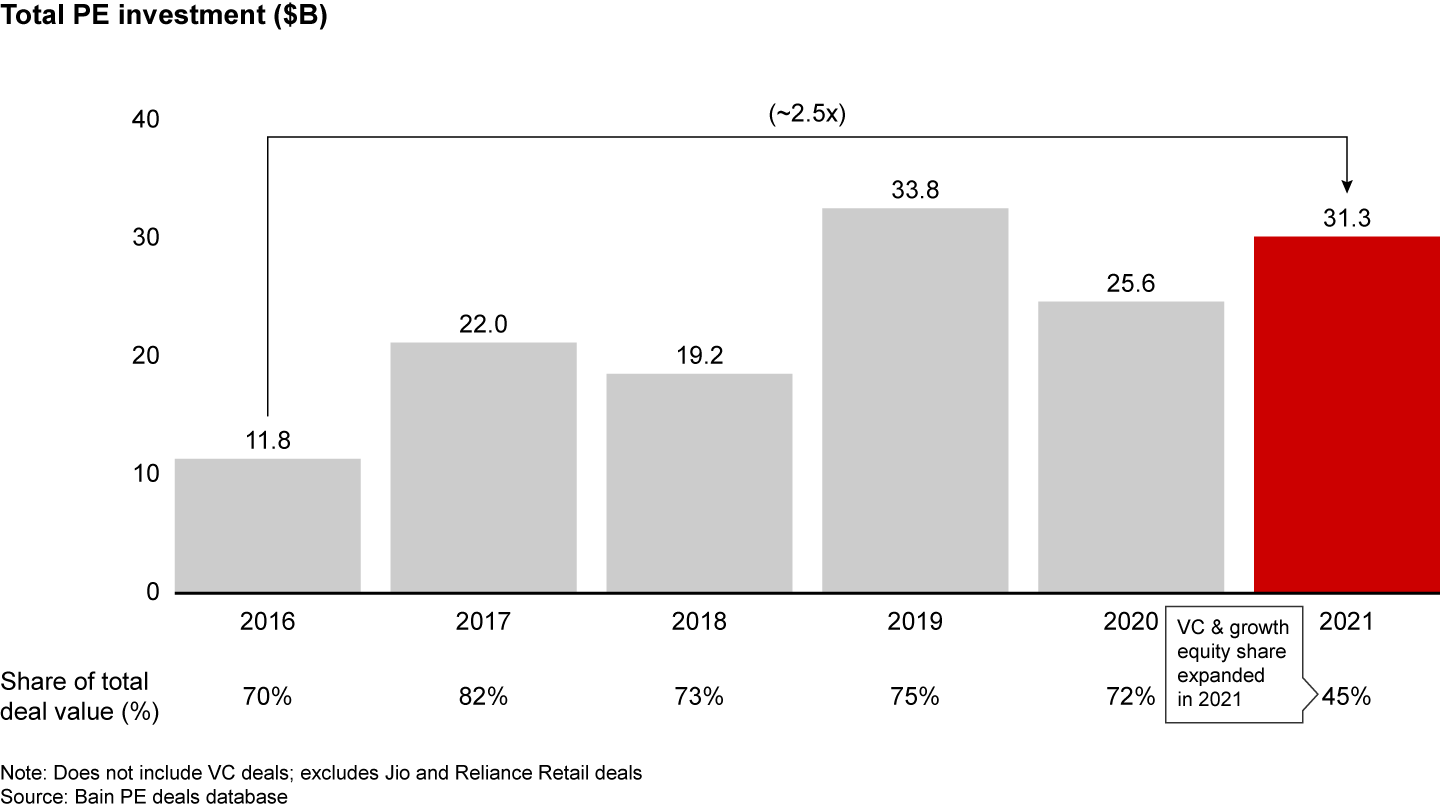
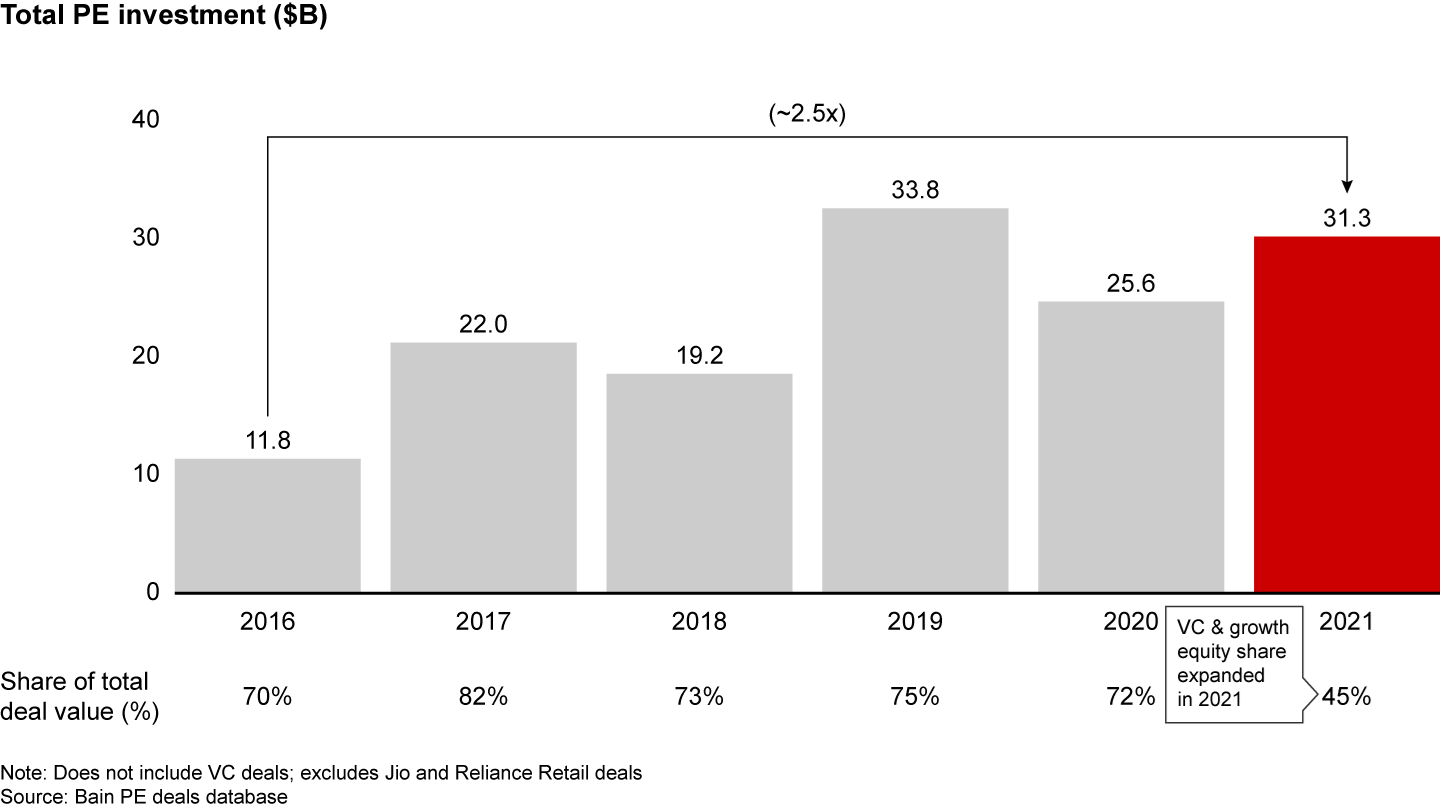
Buyouts continue to drive higher share of value within PE investments and expanded by 5x in that many years
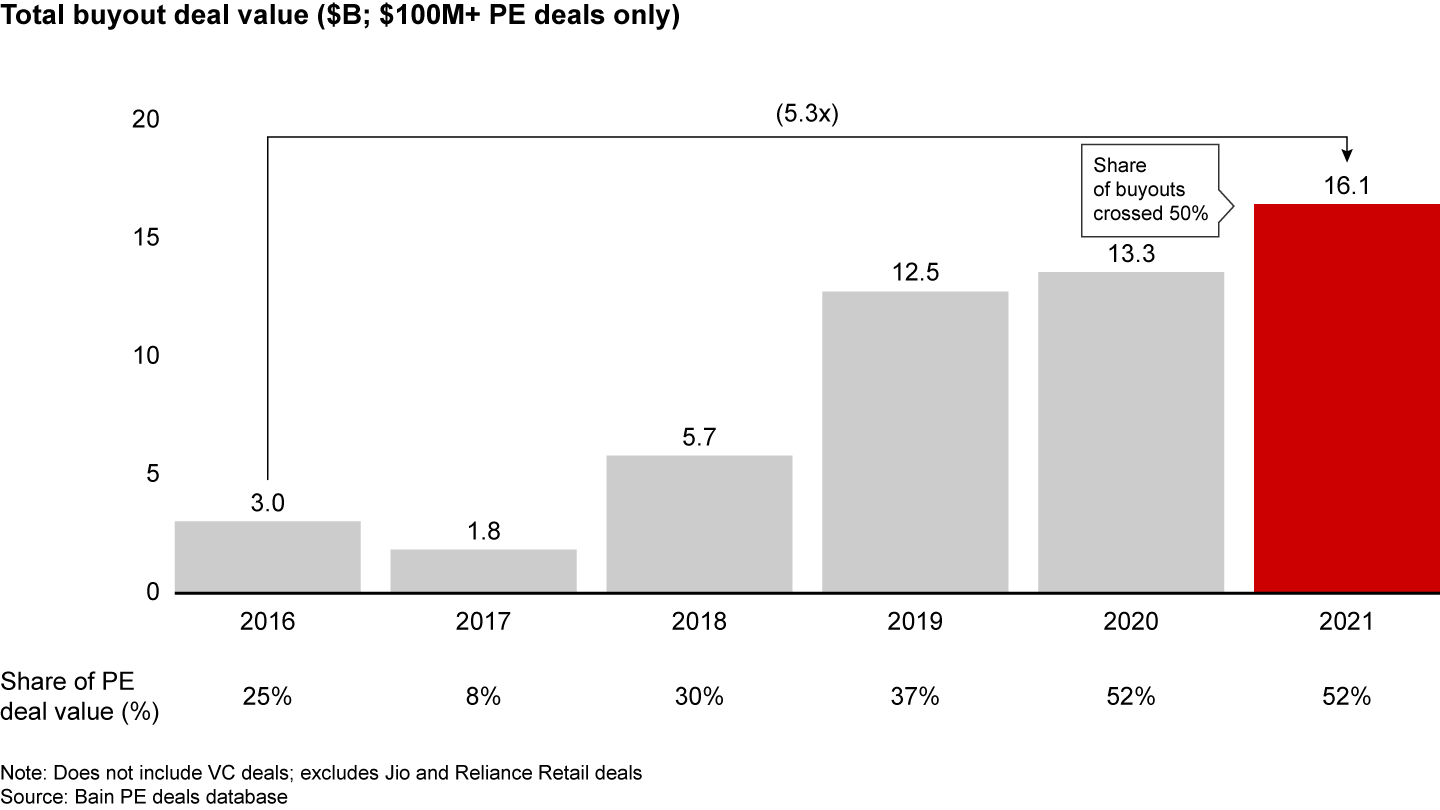
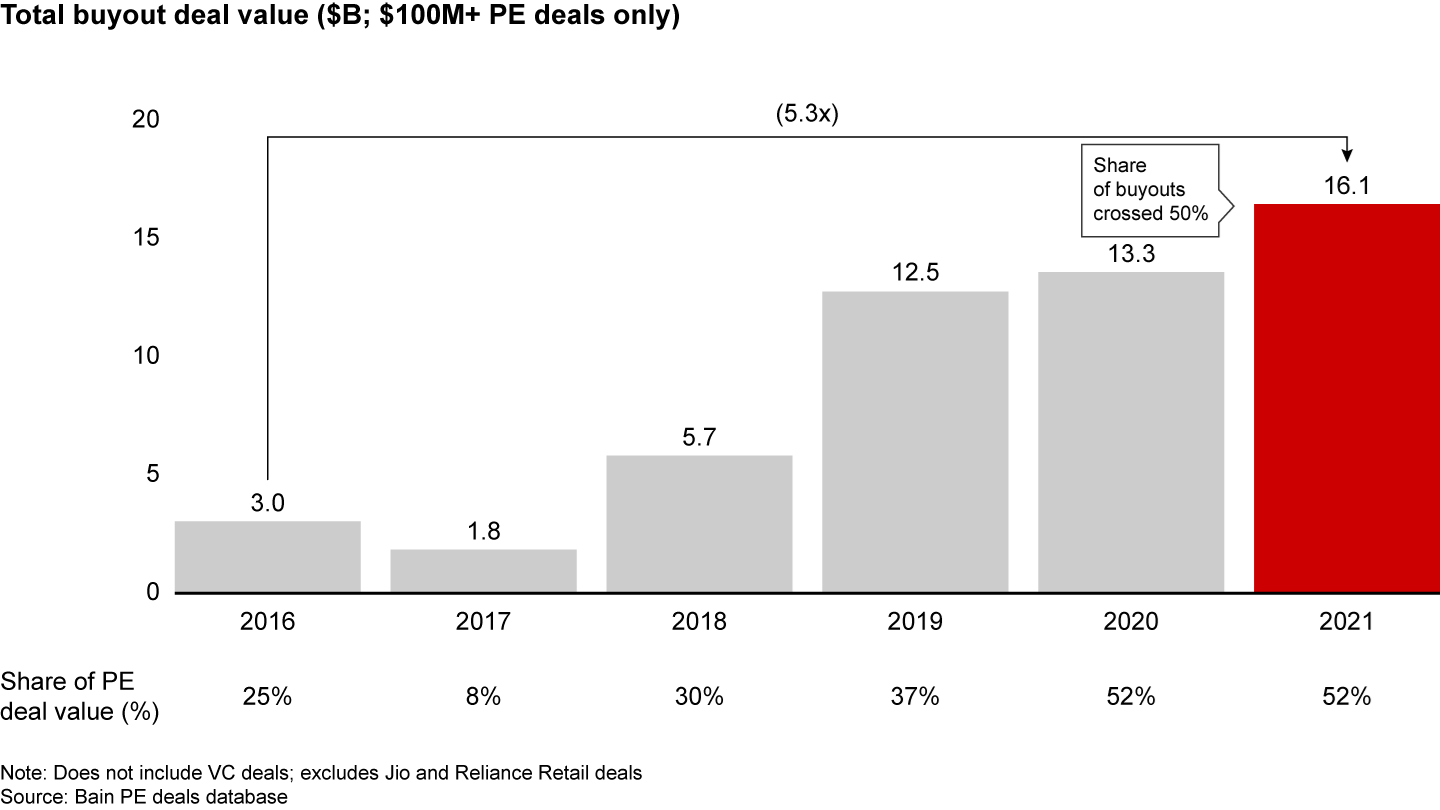
VC and growth equity reached ~$40B, riding on a ~4x growth after moderation in 2020
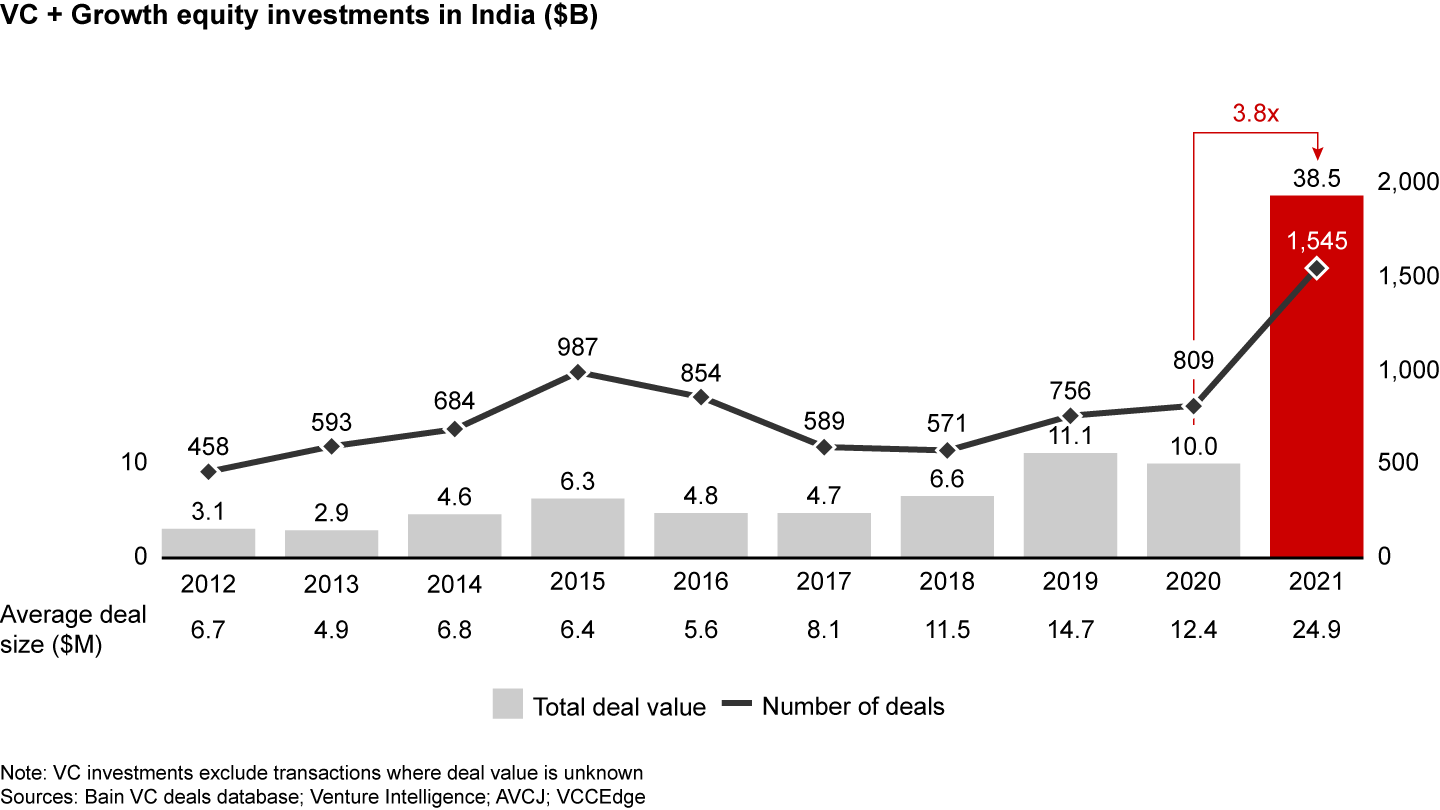
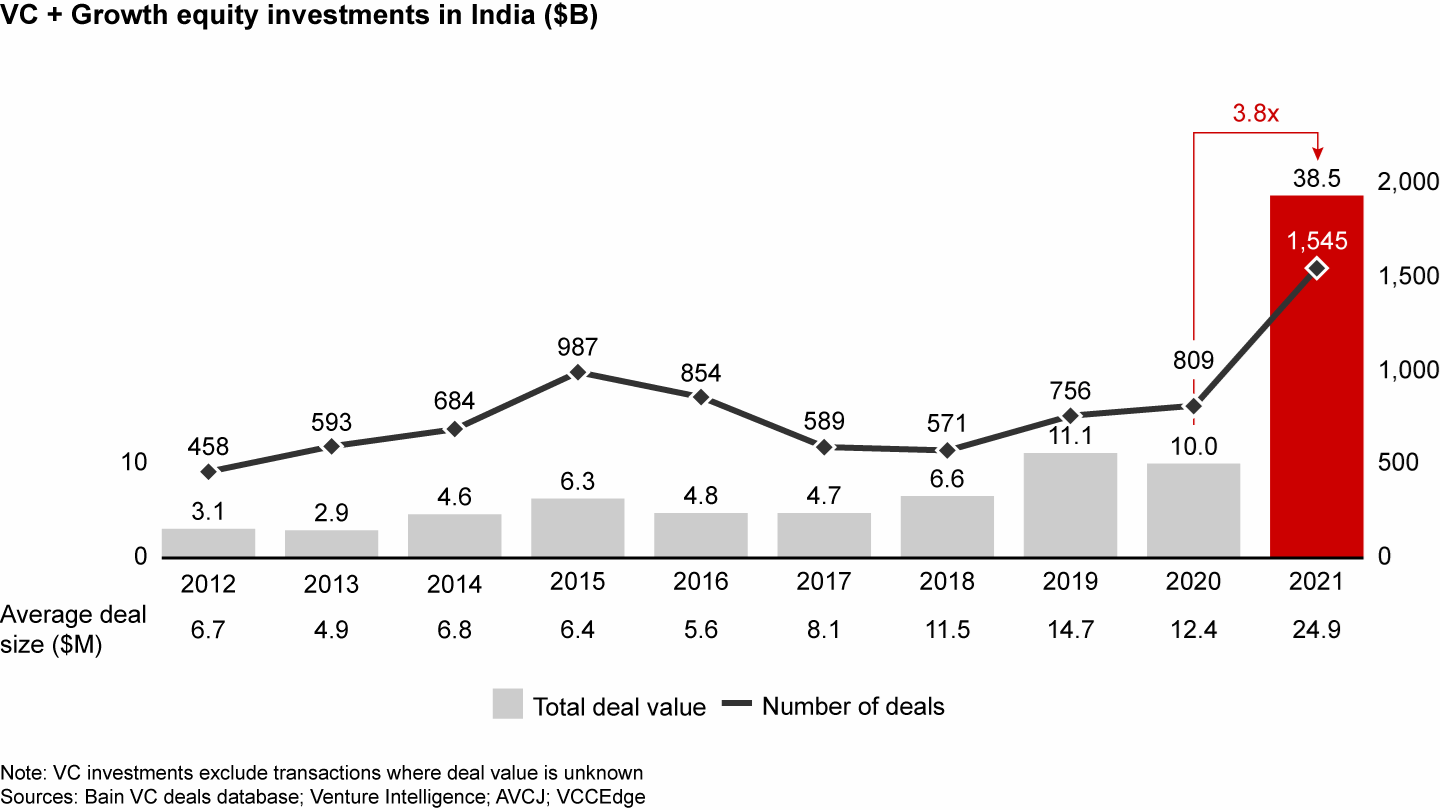
Growth is primarily driven by acceleration in deal volumes, with more than 70% growth attributed to increase in large deals
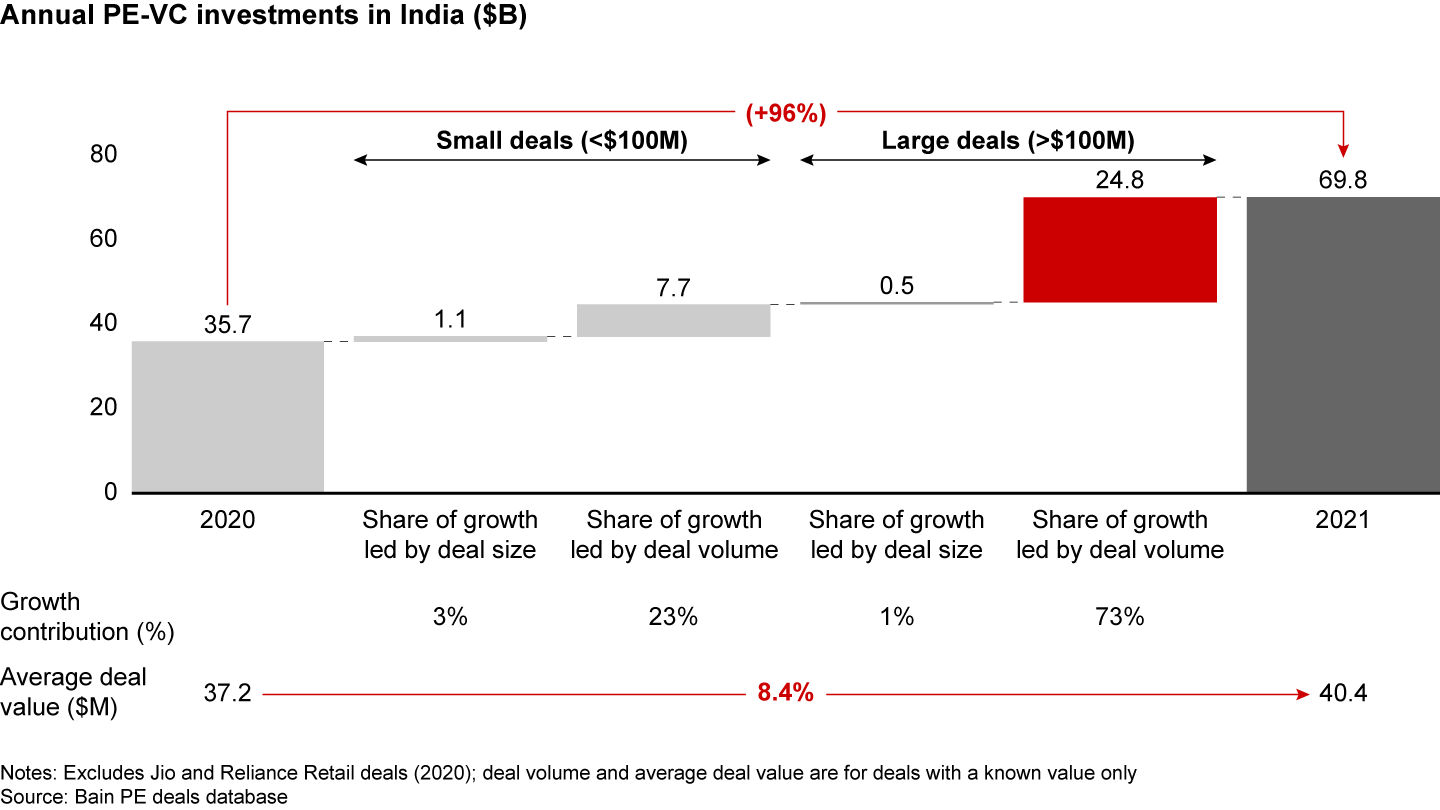
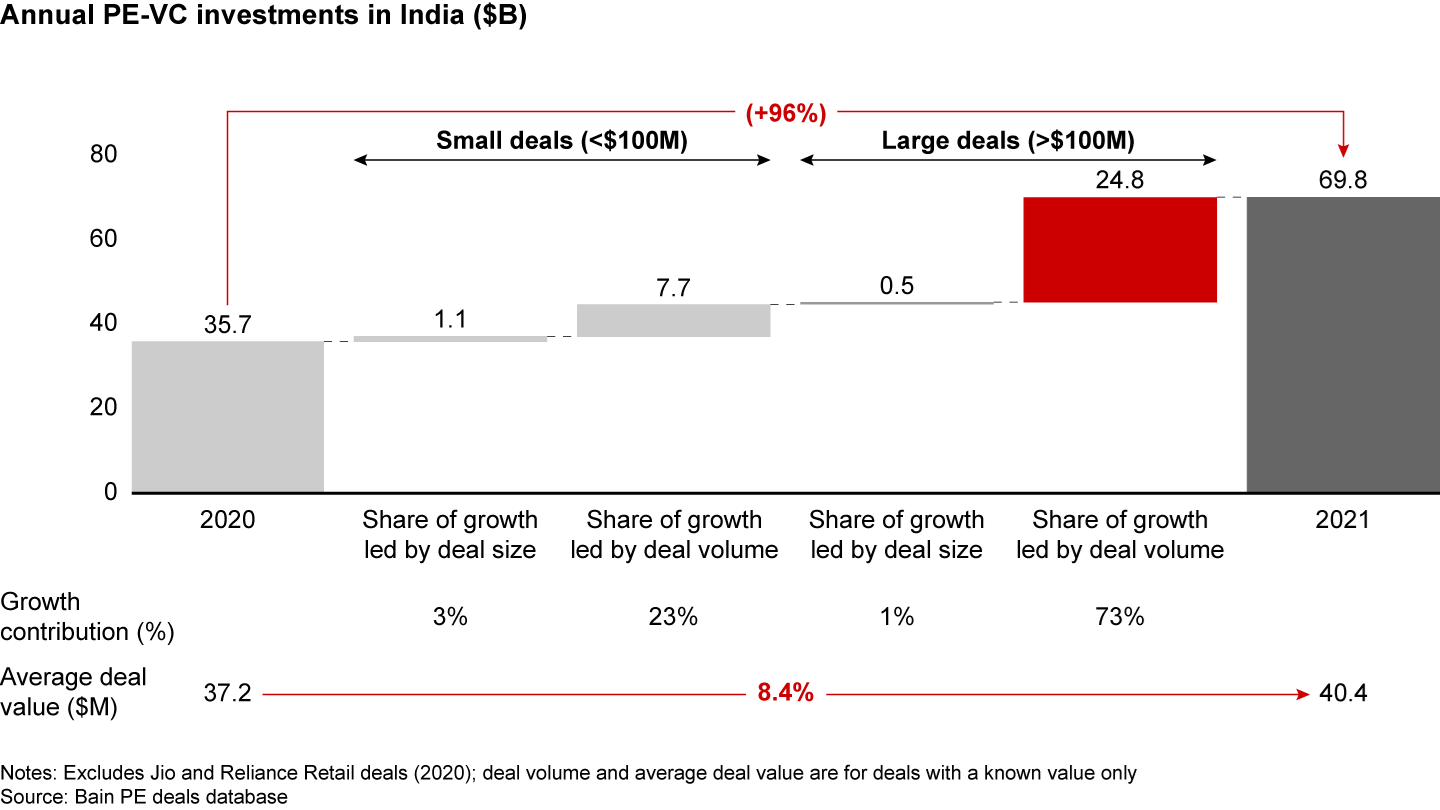
Acceleration in large deal activity in consumer tech and IT/ITES more than compensated for small declines in traditional sectors
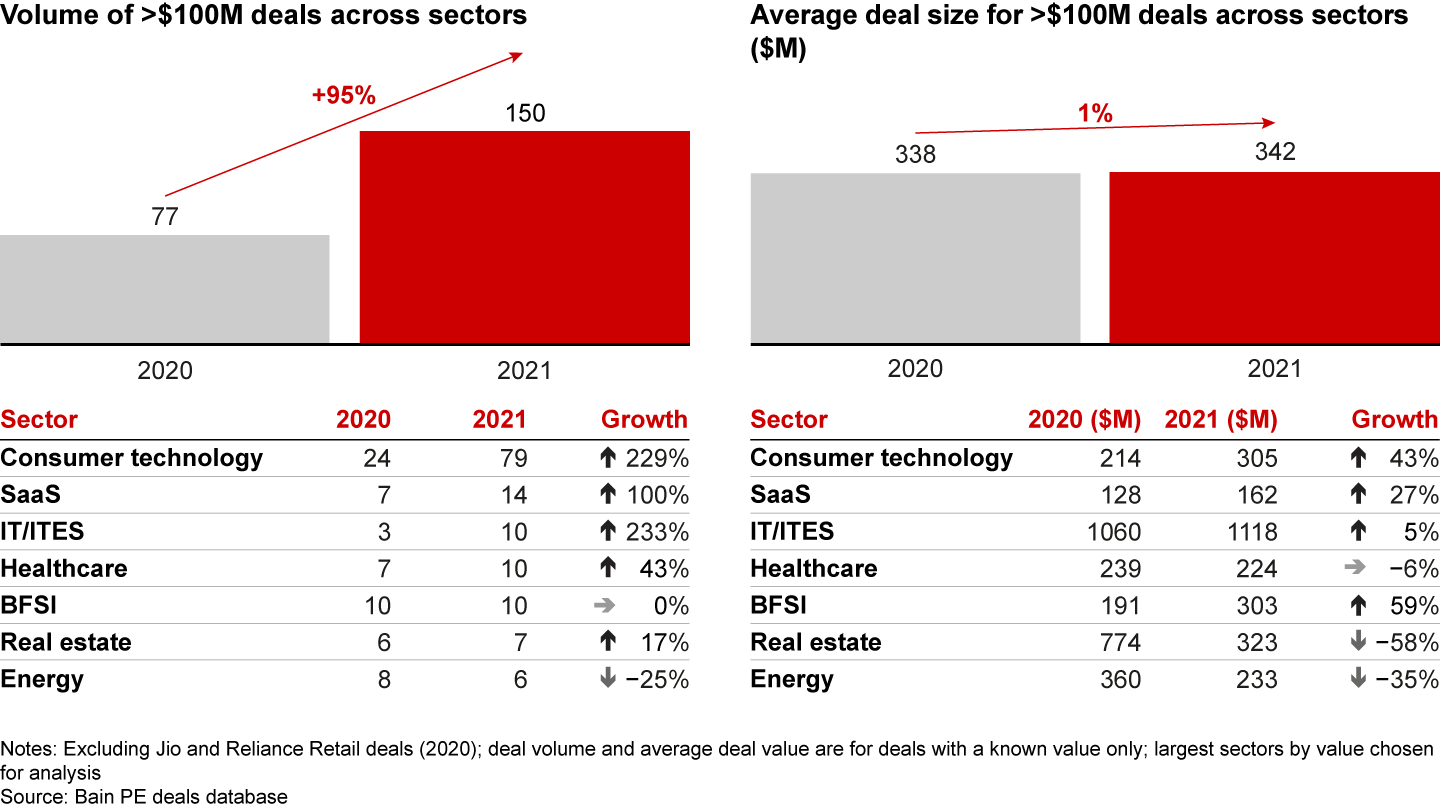
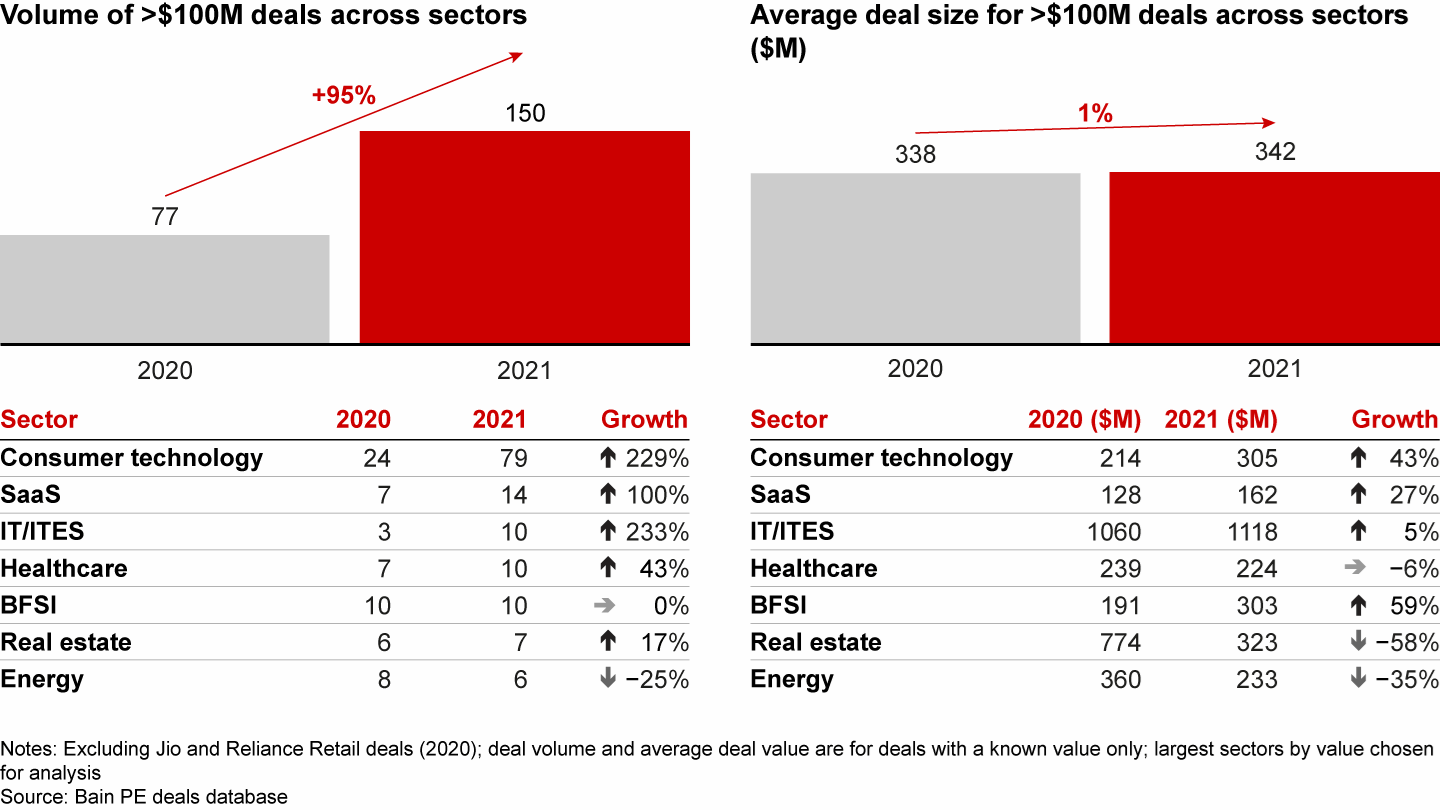
In a significant step up, 11 investments were greater than $1B, compared to 6 in 2020
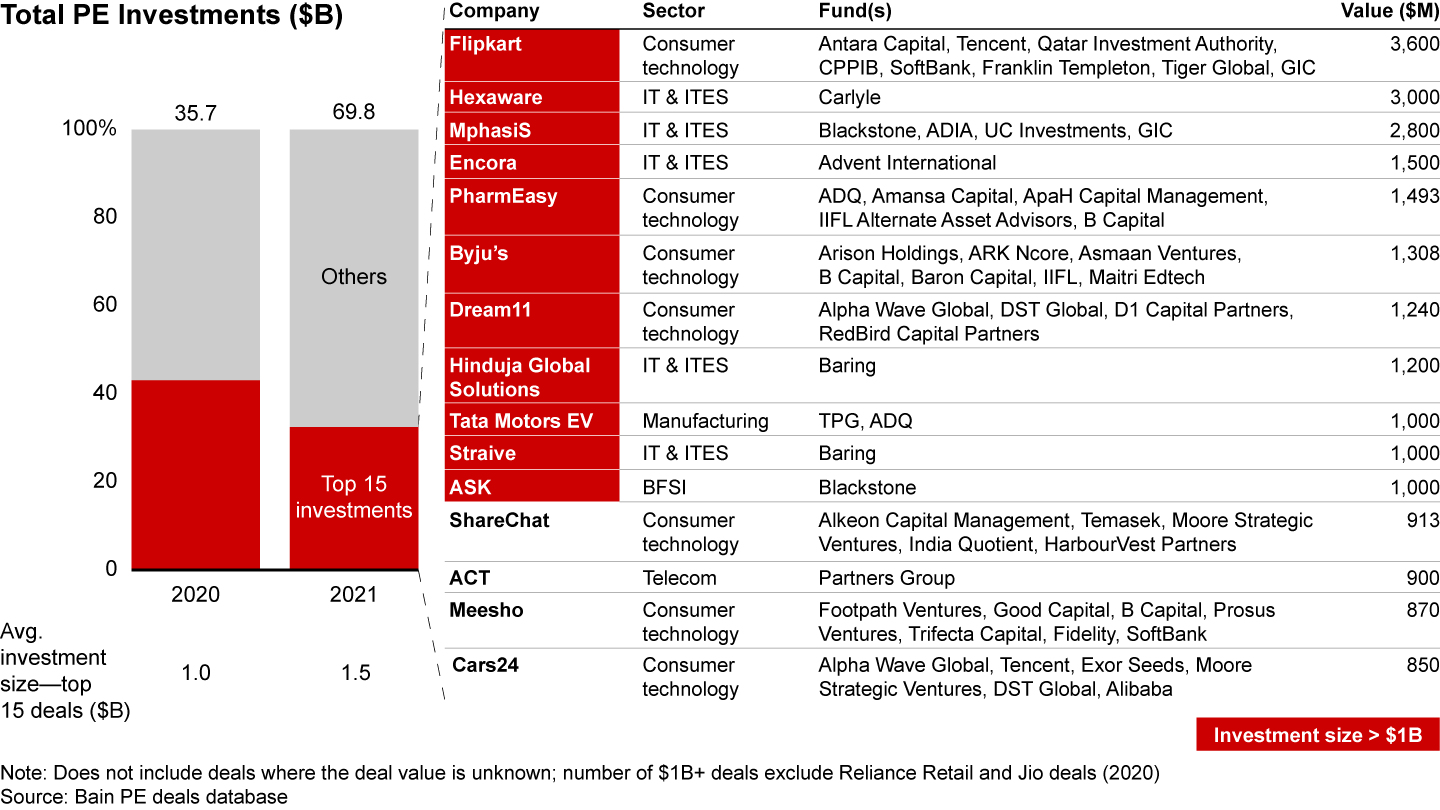
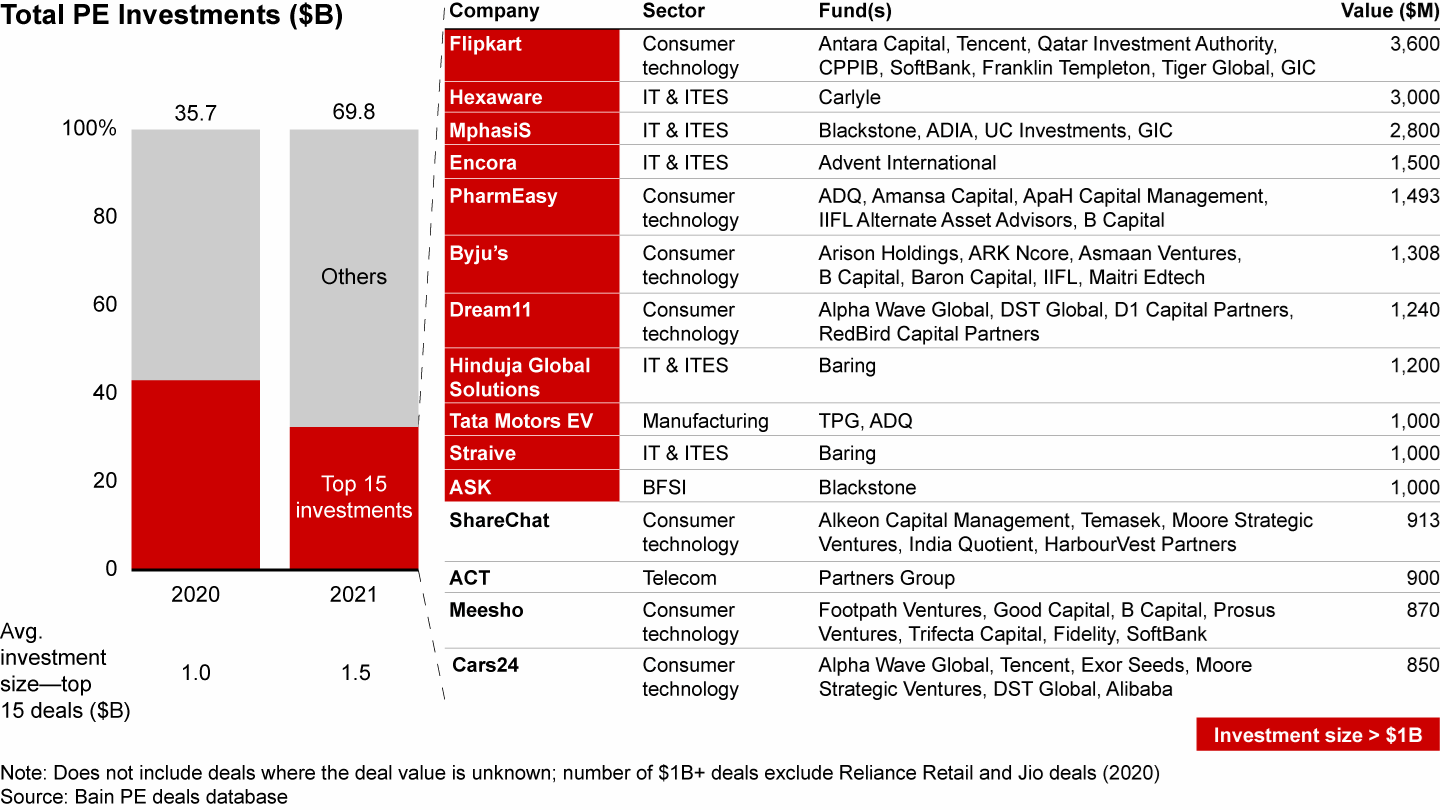
Top funds surpassed the previous year’s outlay and many expanded average cheque size
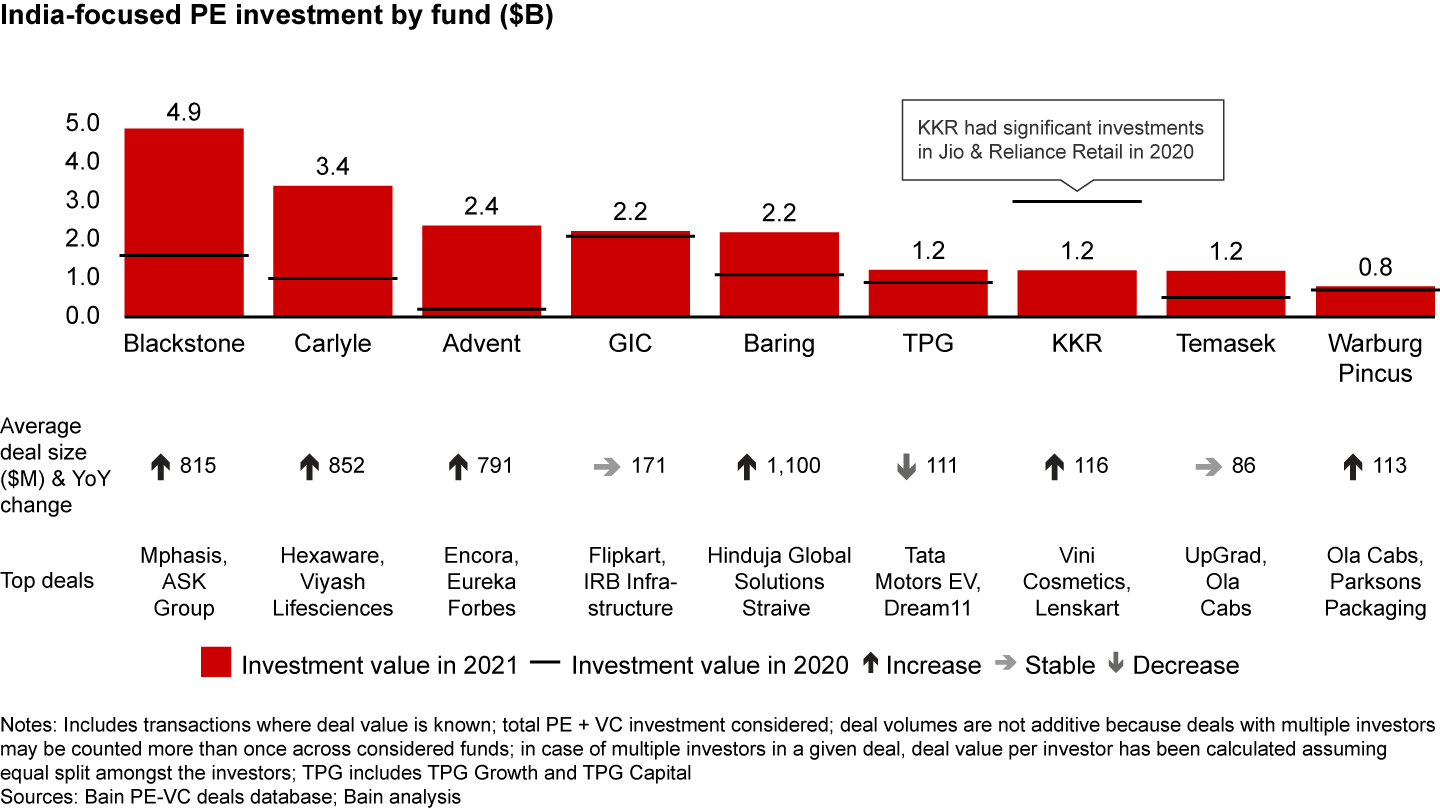
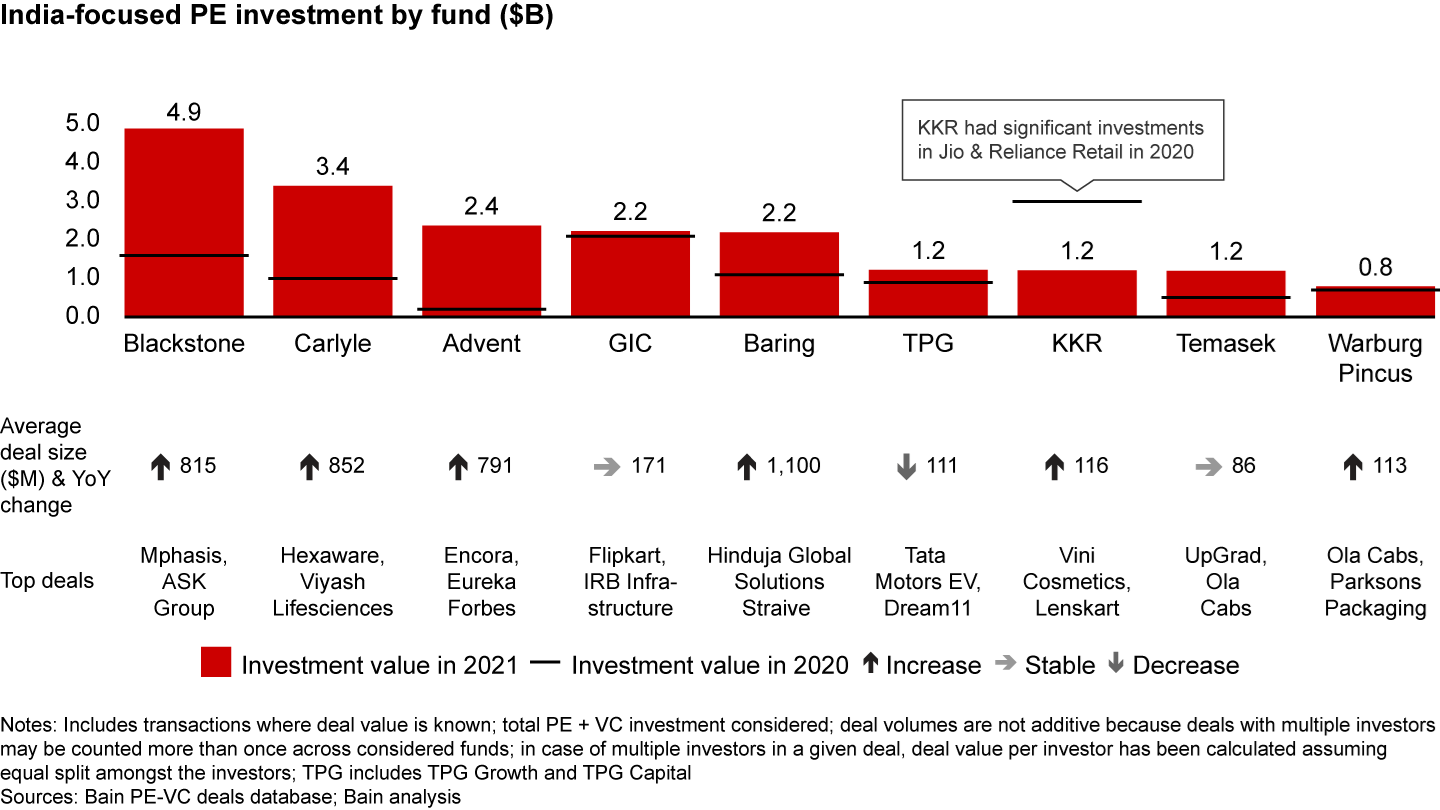
Consumer tech and IT/ITES drove a significant portion of 2021’s growth, with other sectors maintaining strength

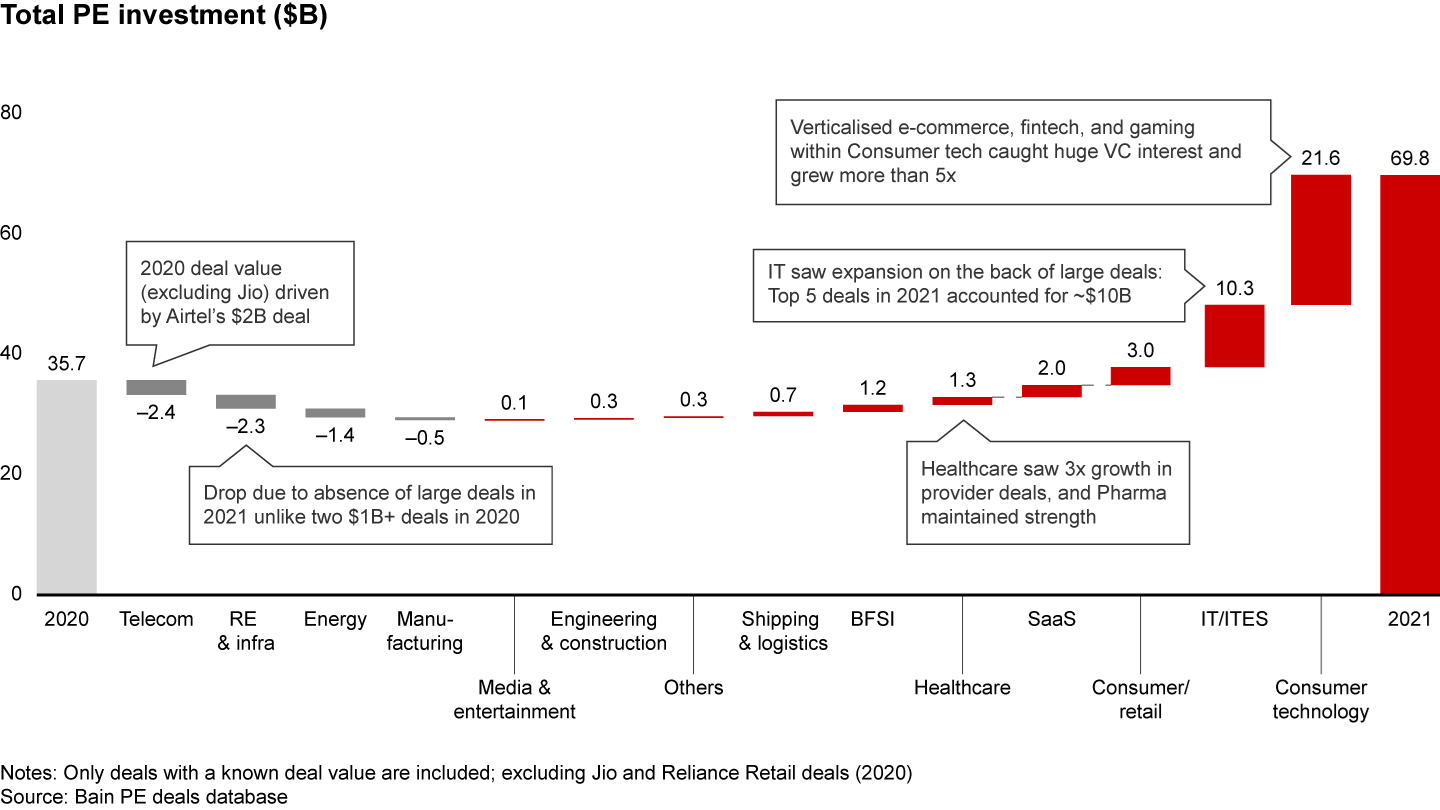
Consumer tech and IT/ITES drove more than 60% of the deal value in 2021
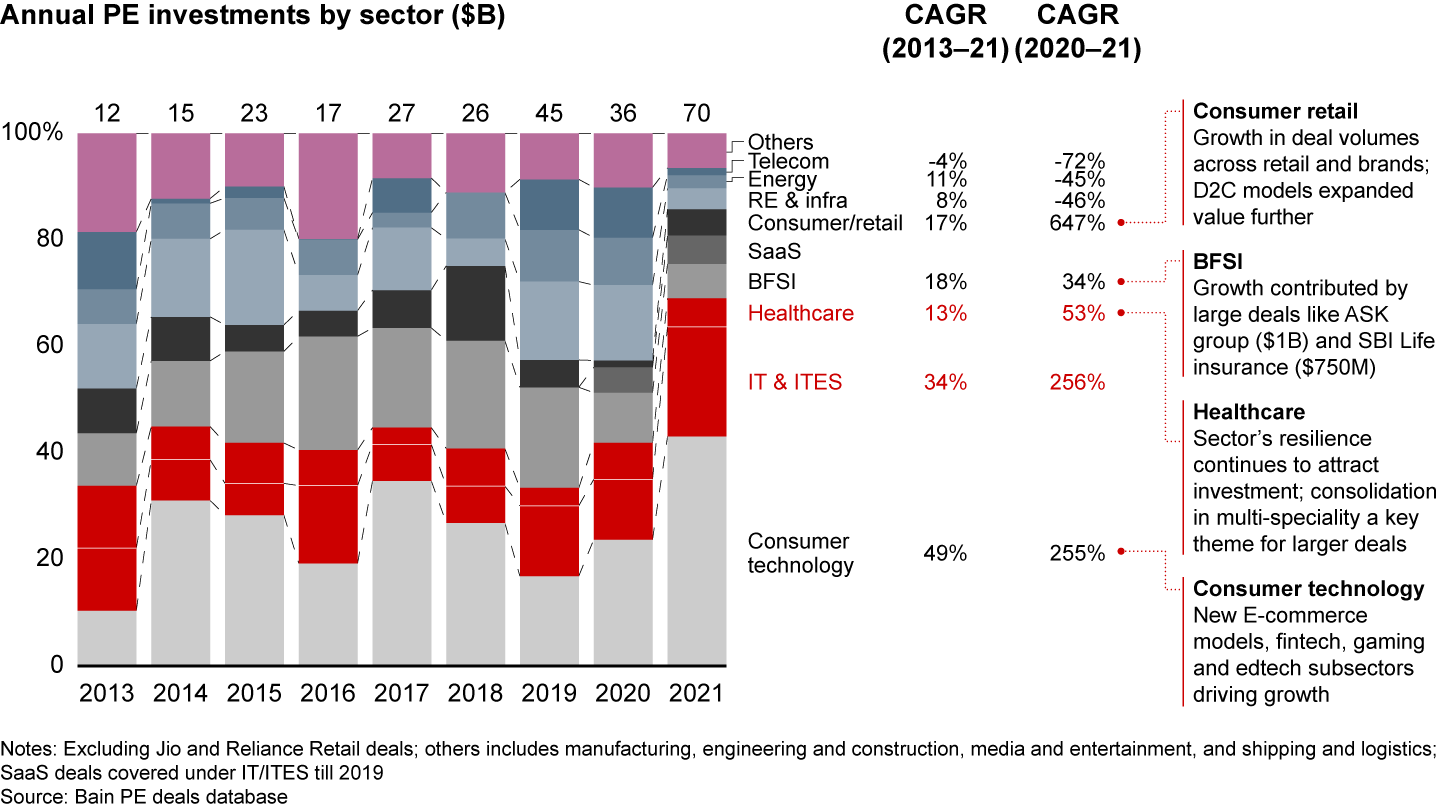
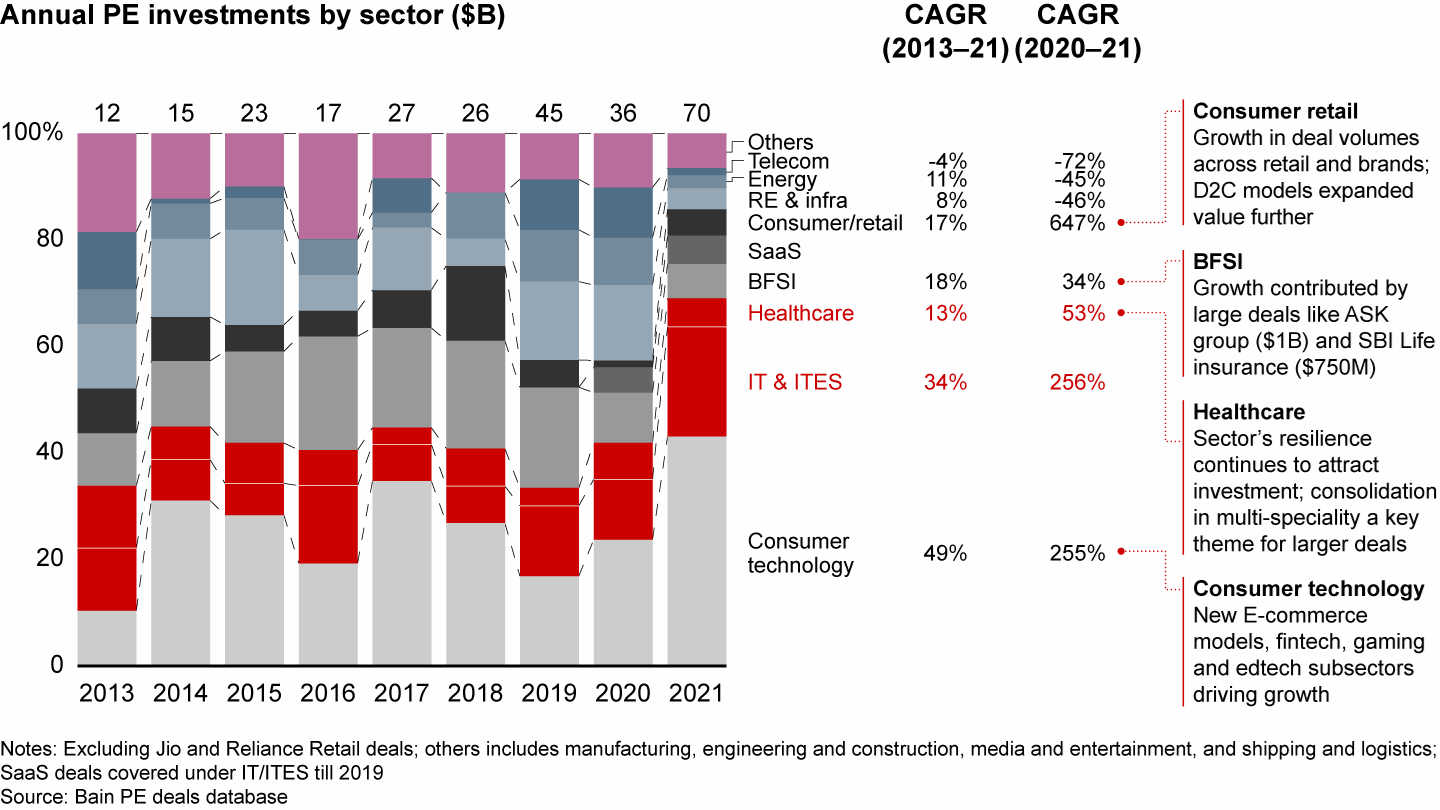
Sectors in focus: IT/ITES and healthcare—maturing ecosystems
- IT/ITES saw investments of $14.2 billion in 2021, growing by $11 billion over the previous year.
- PE investments in IT/ITES have grown from $2 billion to $12 billion in the past five years, and large deal volumes are increasing.
- In 2021, the sector saw five deals greater than $1 billion in a tremendous increase from the last two years that saw a single billion-dollar deal.
- The sector’s attractiveness has picked up due to post-Covid shifts in business operations, the need for business continuity amidst uncertainties, and a pivot to digitally enabled models focused on improving unit economics. This has created increased demand for offshoring and outsourcing, automation and digital, and cloud services. The shifts are expected to last as the world embraces a “new normal” moving into the endemic phase of the pandemic, and IT promises to provide the backbone of these shifts.
- Valuations in IT saw a significant rise, with the large deals in ITES closing at 20–30x EBITDA multiples, much higher than historical multiples of approximately 15x and BPO reaching multiples of 13–14x, growing from the range of about 10x. The sector also continues to see significant buyout activity and accounted for nearly 40% of buyout deal value at almost 20% of buyout deal volumes over the last three years.
- Healthcare grew 1.5x in 2021, with providers growing 2x after the slowdown in 2020, and pharma maintaining the strength gained on the back of Covid-led expansion.
- Within provider, multi-speciality saw a 300%+ growth followed by diagnostics and single-speciality. The Manipal and Apollo deals drove a significant chunk of the deal value.
- Multi-speciality hospital deals are largely driven by scale and consolidation, as private players seek to dominate local presence and improve share of high-value cases. Platform play is also an emerging thematic area of focus.
- Single-speciality niches have proved mettle not only with customers but also with investors, as various asset-light, highly replicable models emerge in different clinical specialties and find scale.
- India’s diagnostics market has been given a fillip by Covid-19, and diagnostic chains are expected to reap the growth with an expected growth over the next five years of close to 17%.
Consumer tech and IT/ITES drove more than 60% of the deal value in 2021
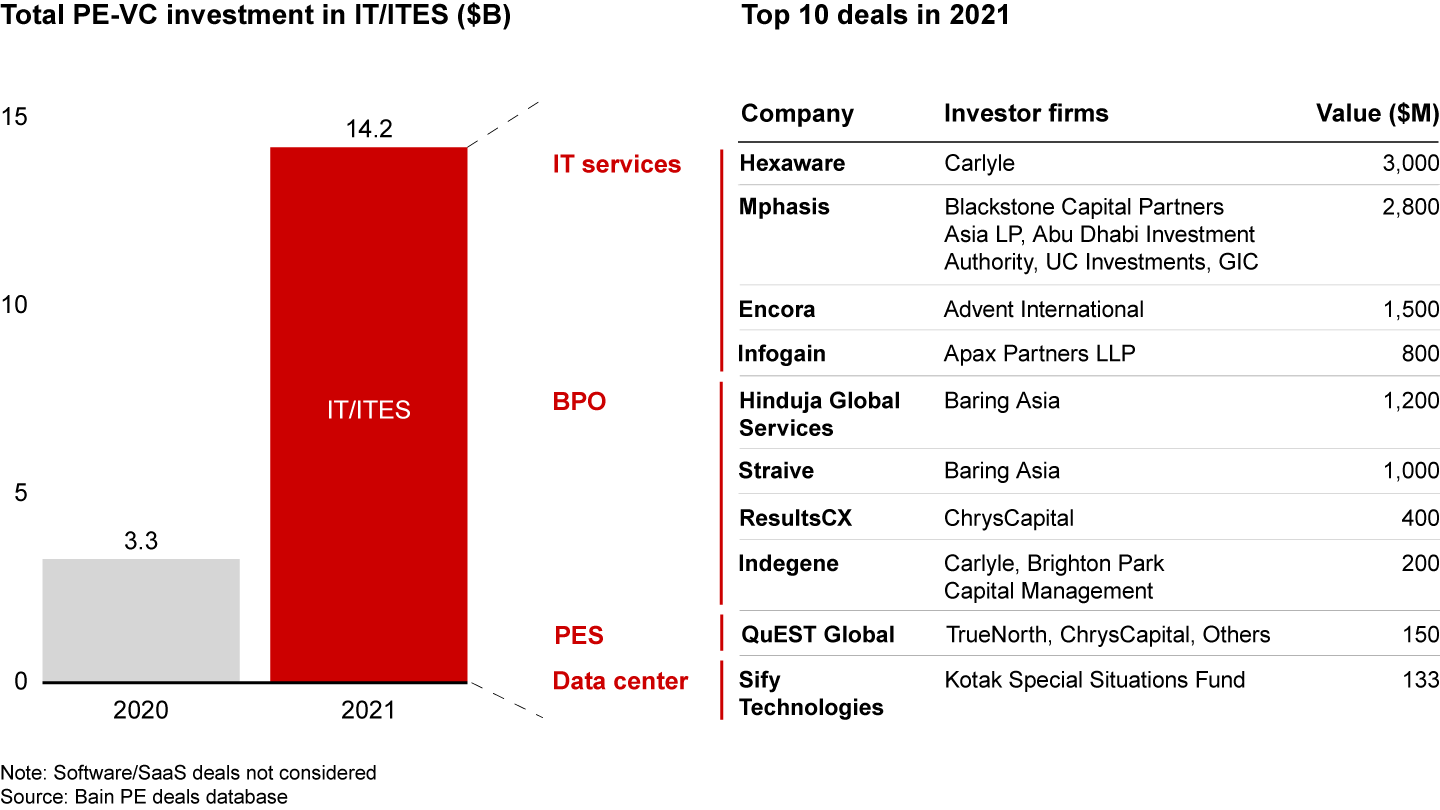
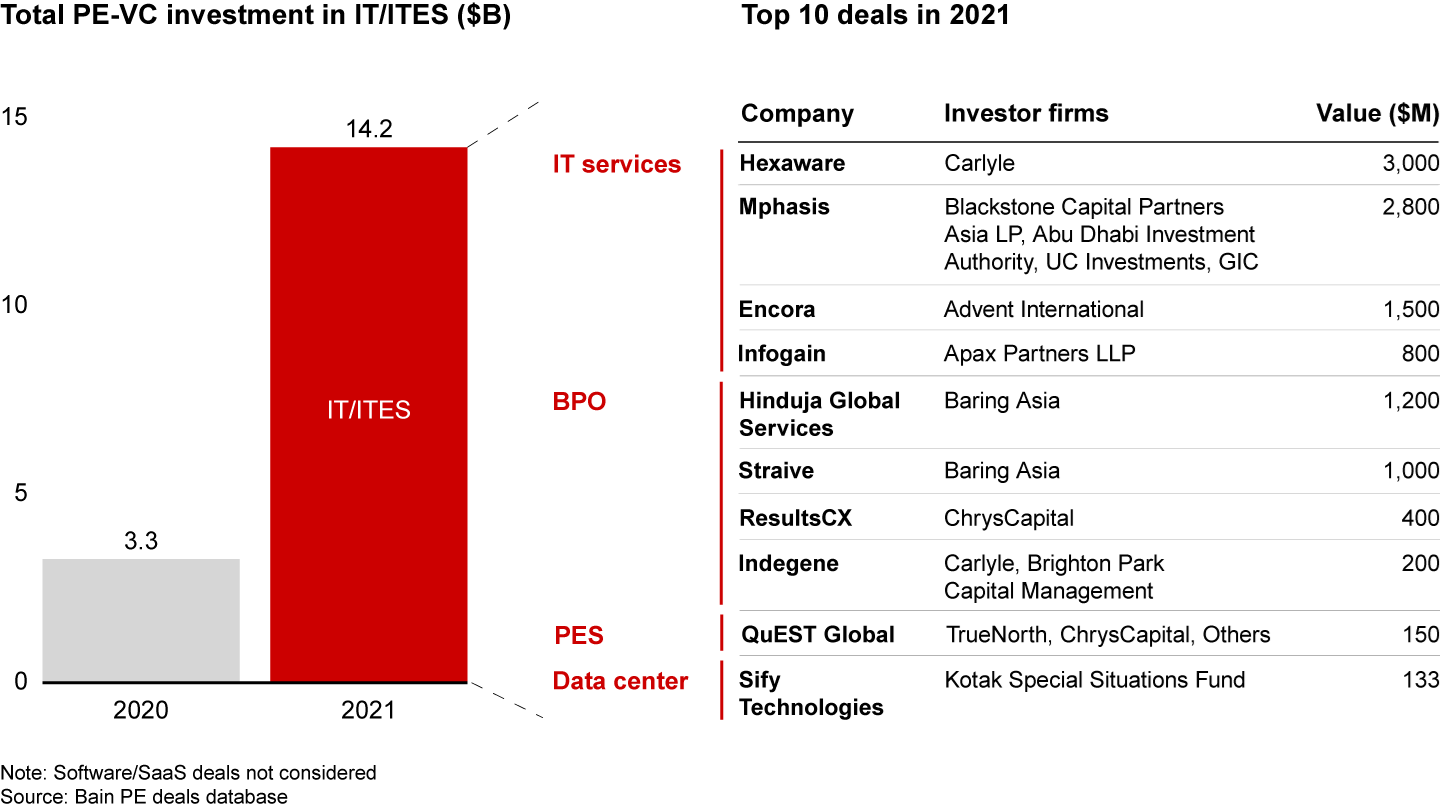
IT/ITES investments have grown from ~$2B to ~$12B in the past 5 years, and large deal volumes are increasing

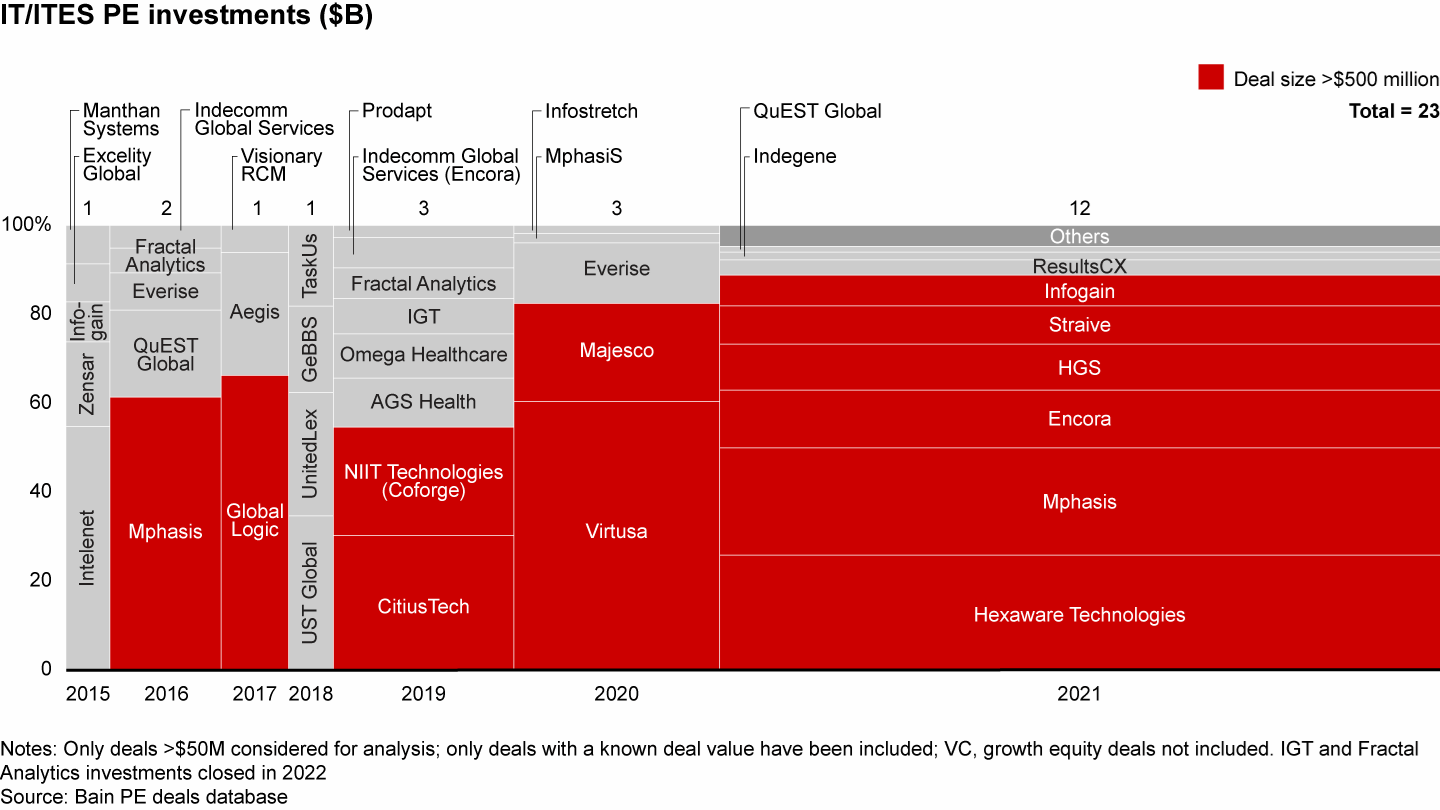
IT/ITES has seen an increase in both large deals and valuations in 2021
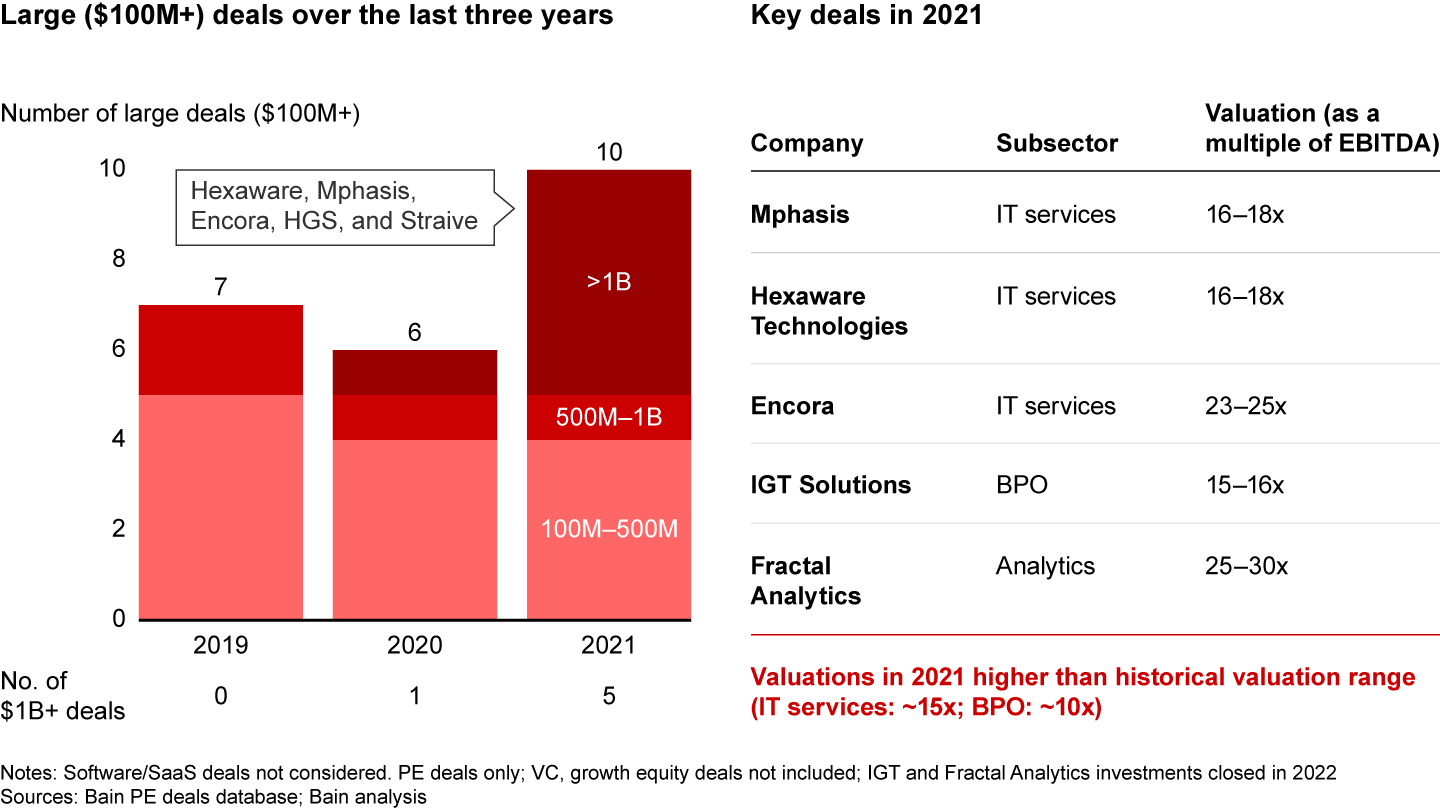
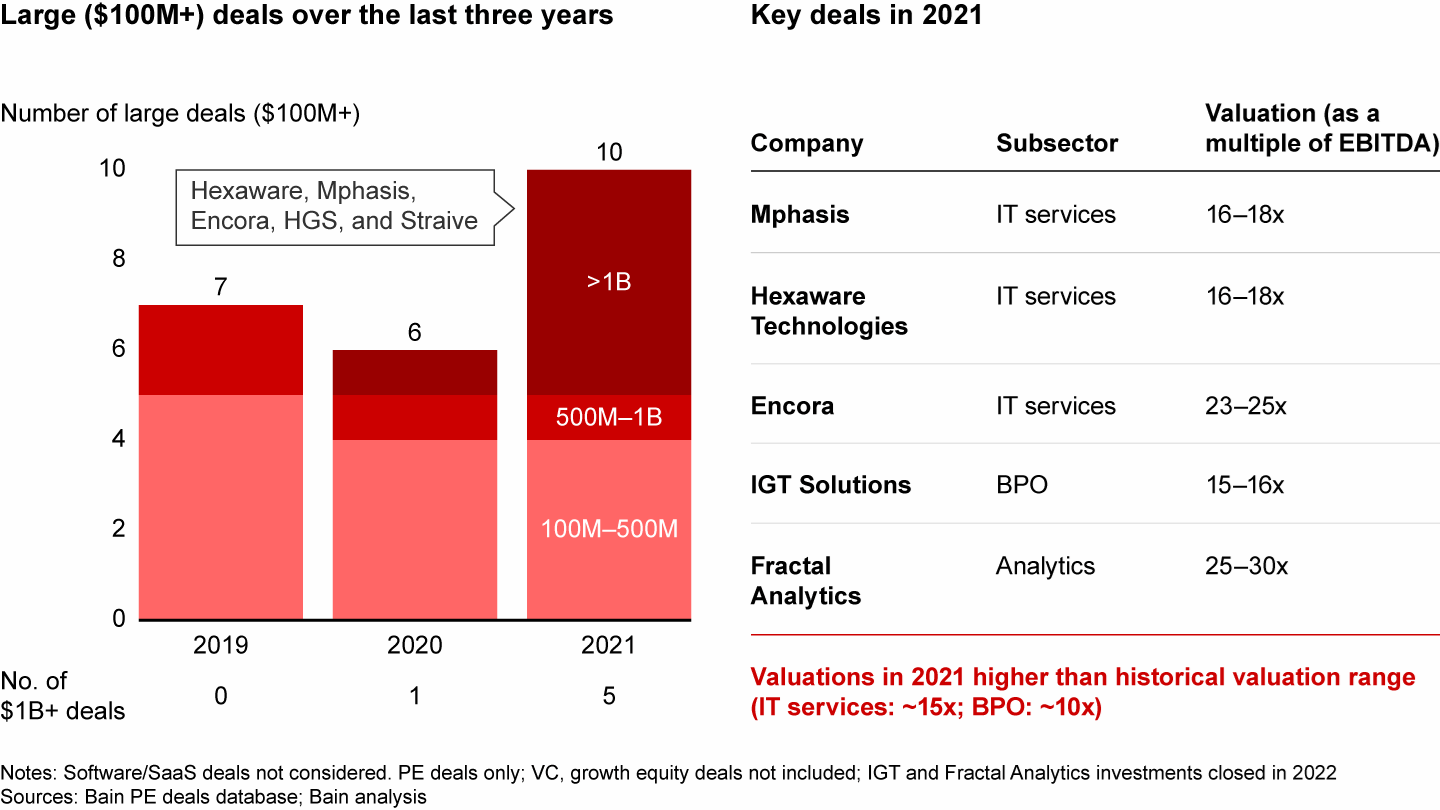
Pandemic-induced acceleration in digital transformation agendas for traditional business models has unlocked huge market opportunities
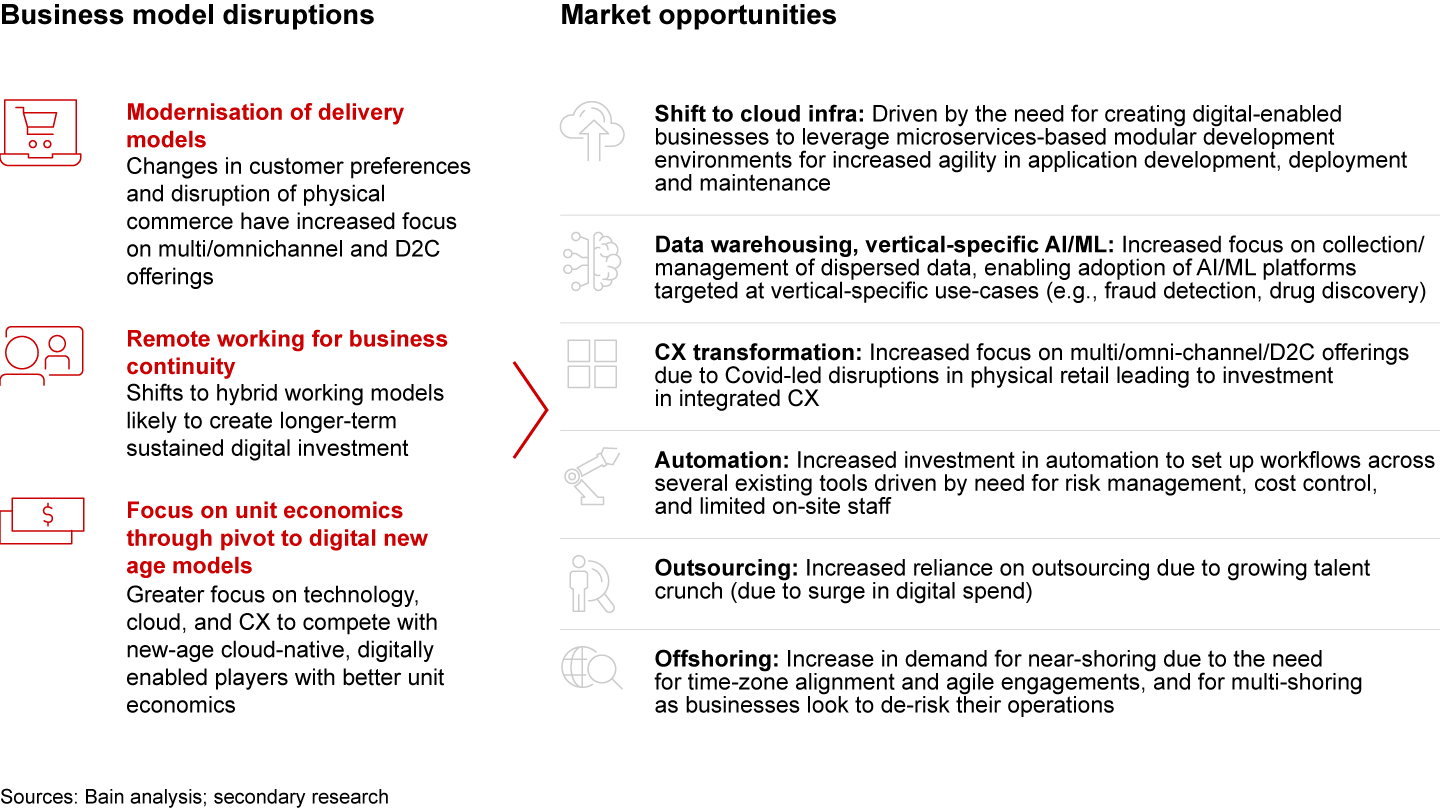
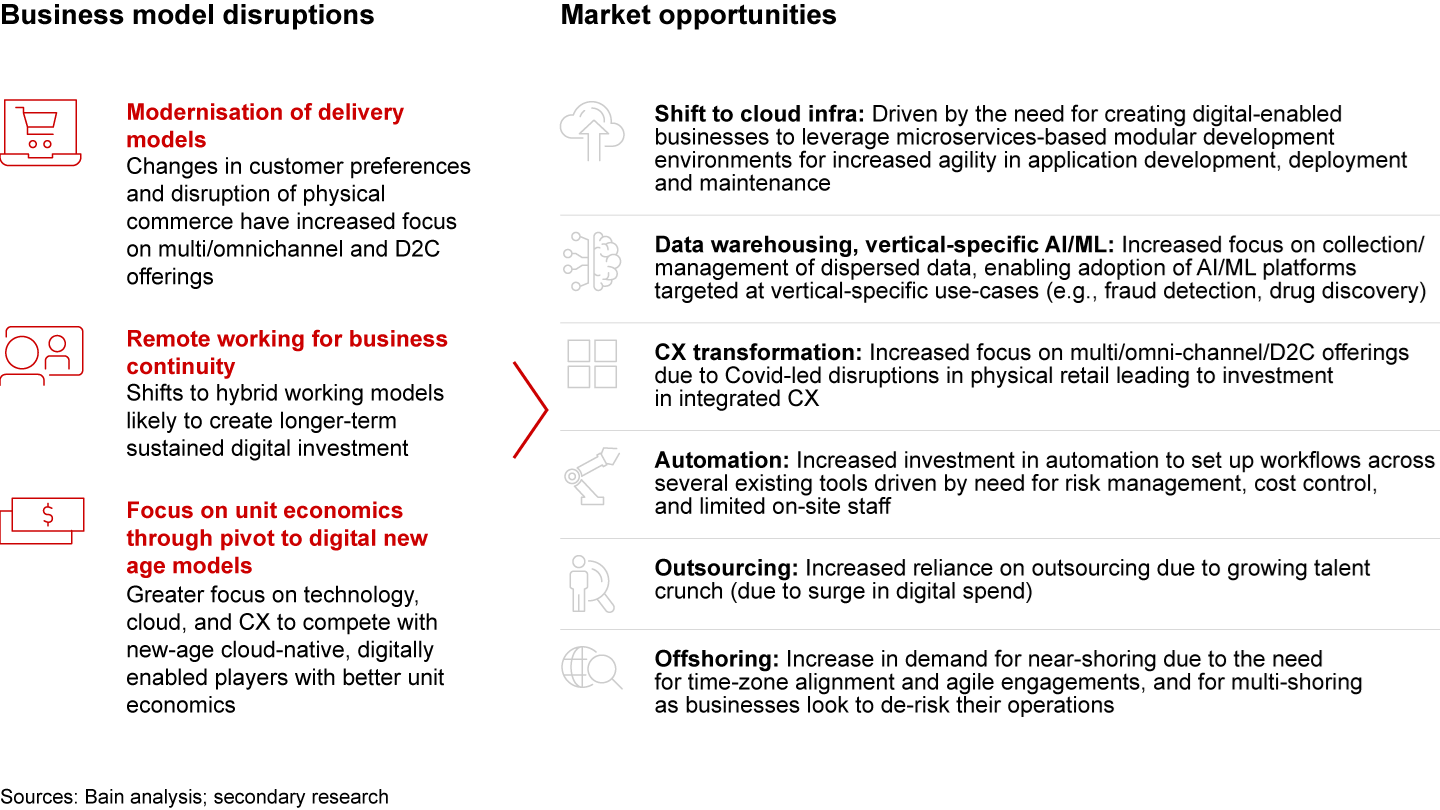
Outsourced digital IT services can be divided into nine subsectors with large market opportunities
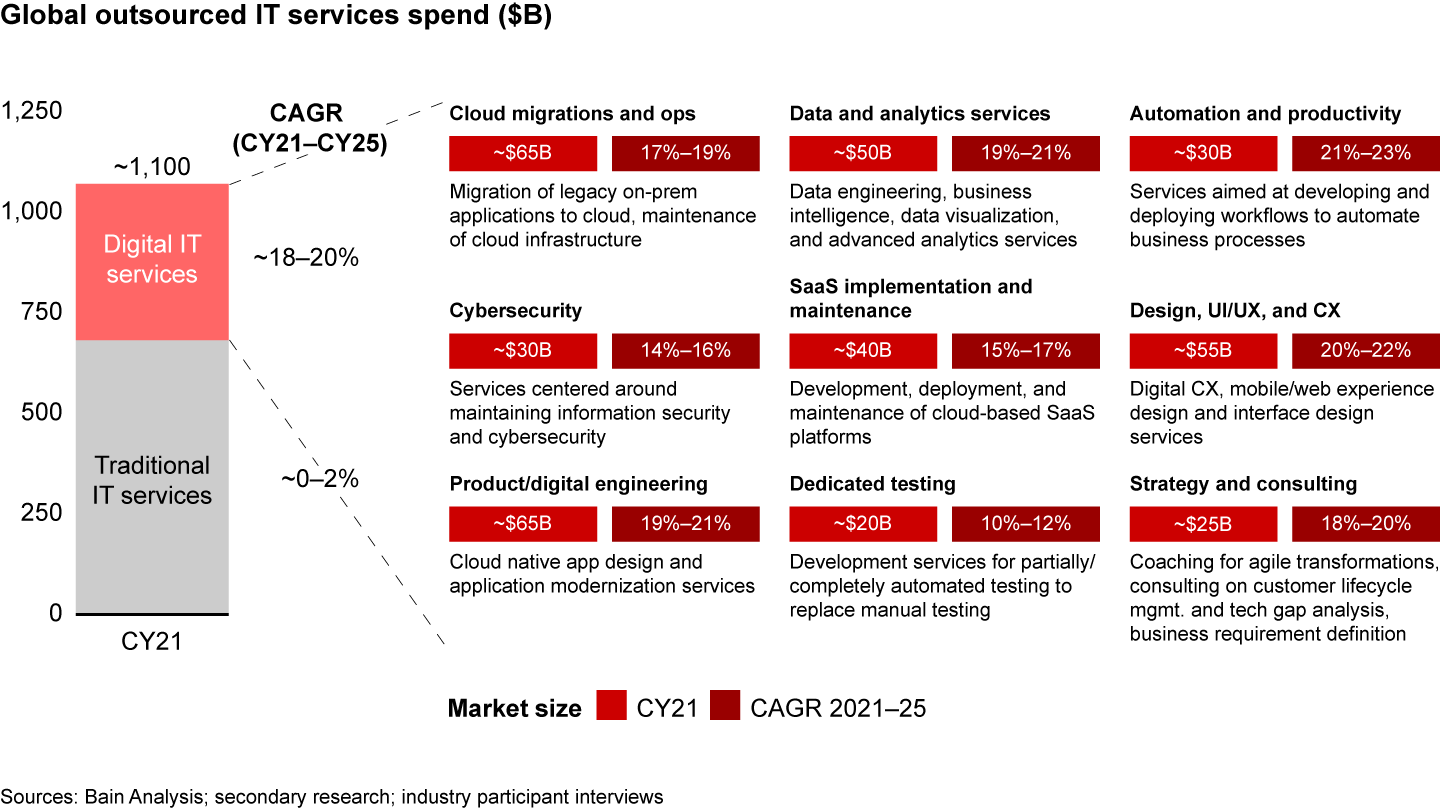
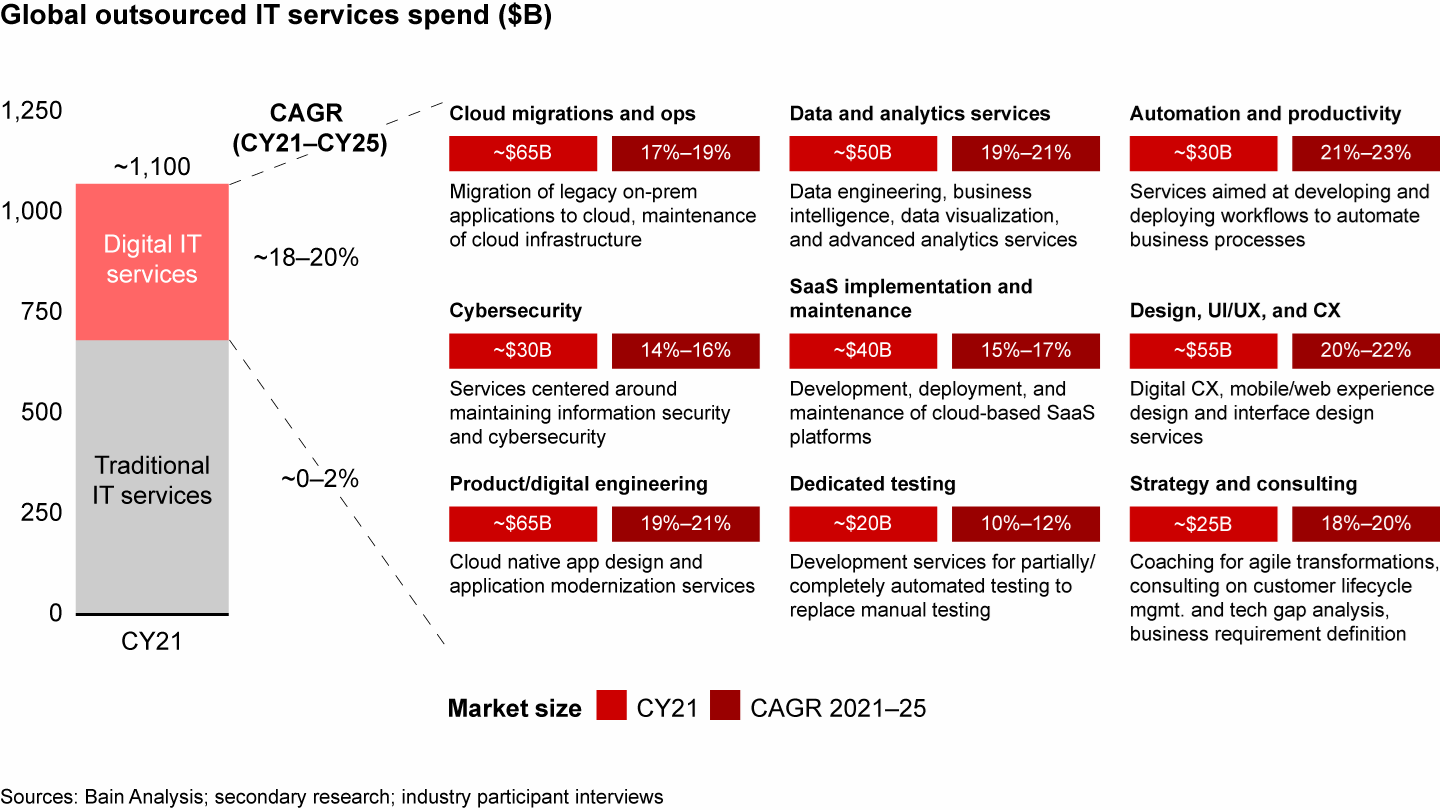
Healthcare providers space rebounded in 2021 with 2x+ growth over 2020, driving the expansion in healthcare
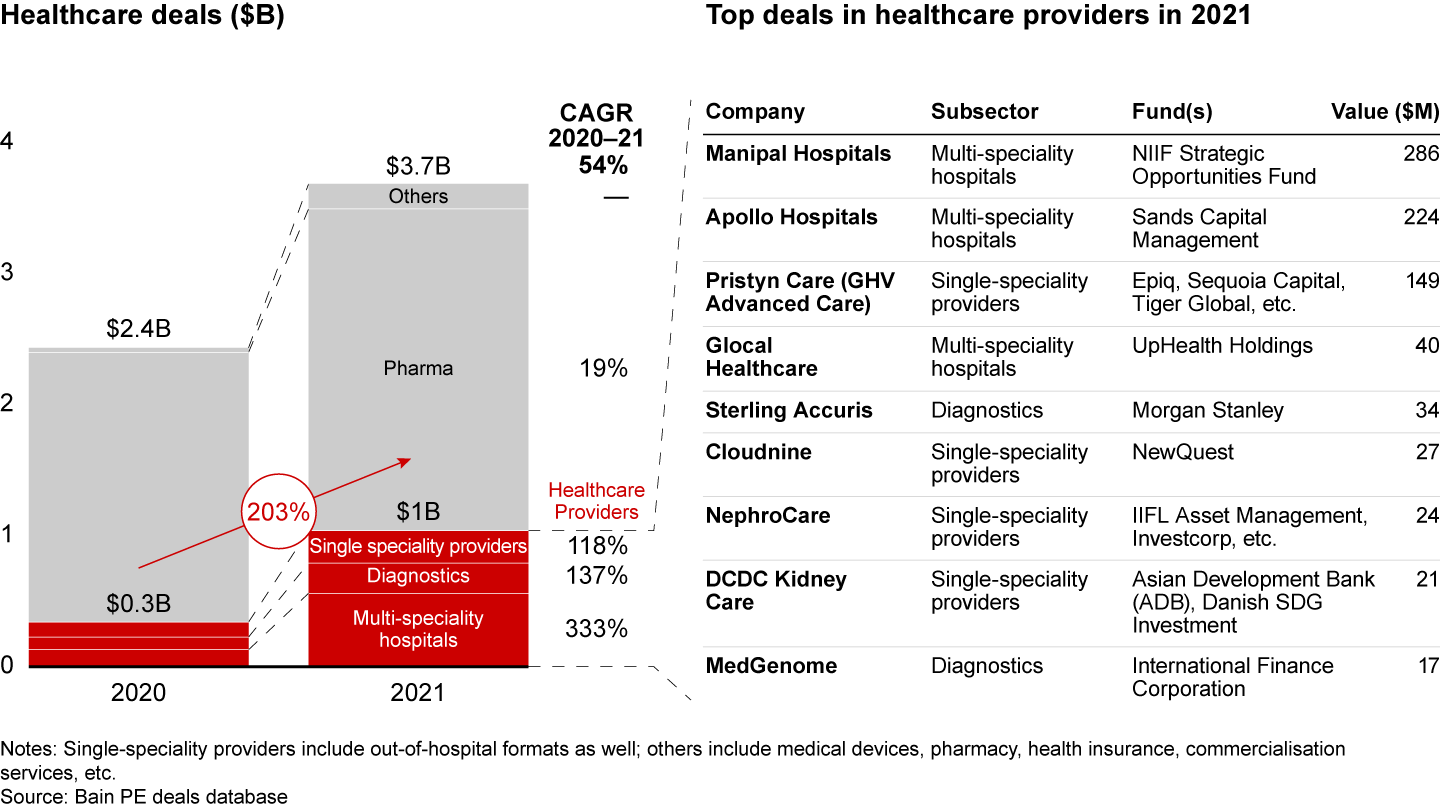
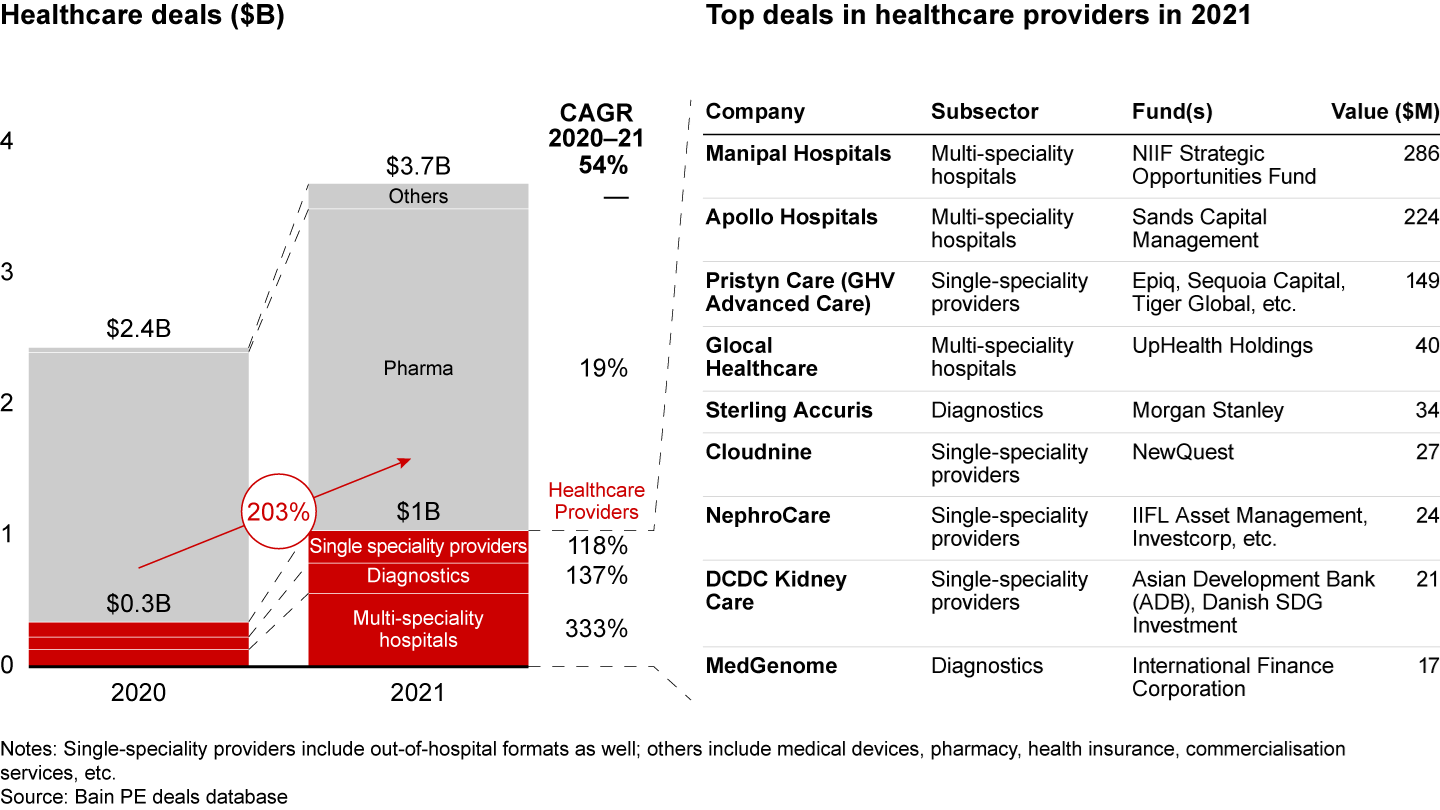
Investments in healthcare delivery are driven by five discernible themes
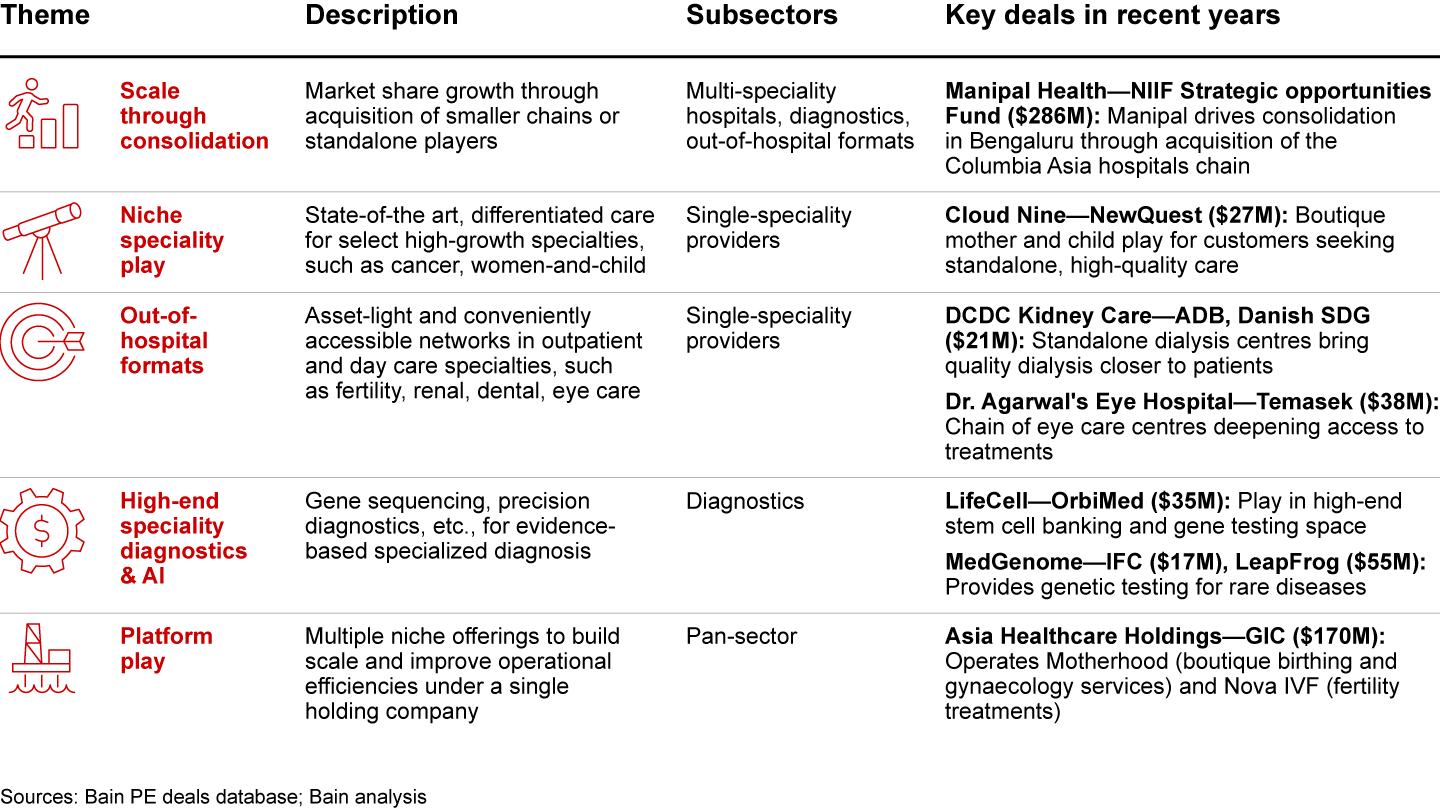
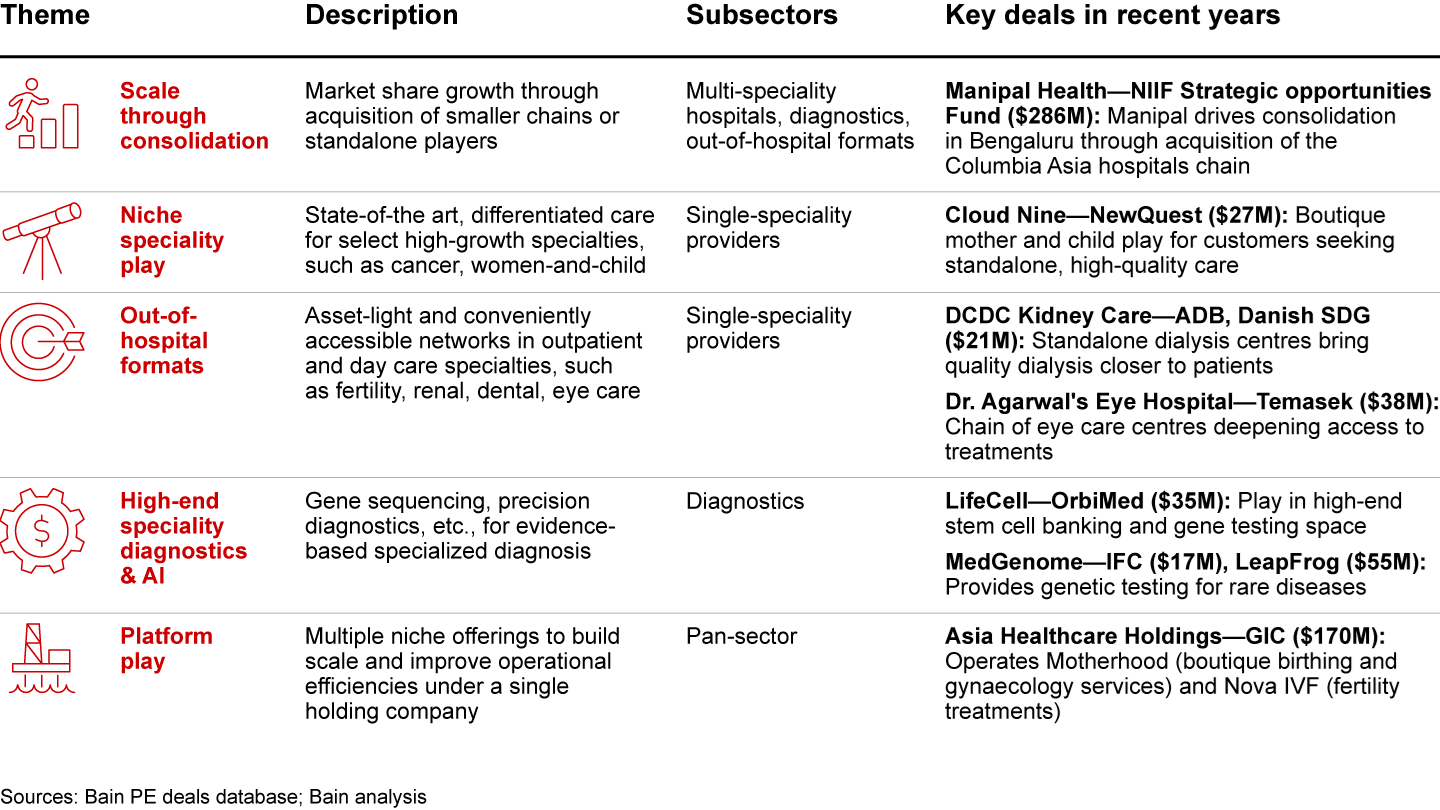
Growth in multi-speciality hospitals is driven by corporate and private stand-alone players, which better fulfil growing demand for quality care and complex treatments
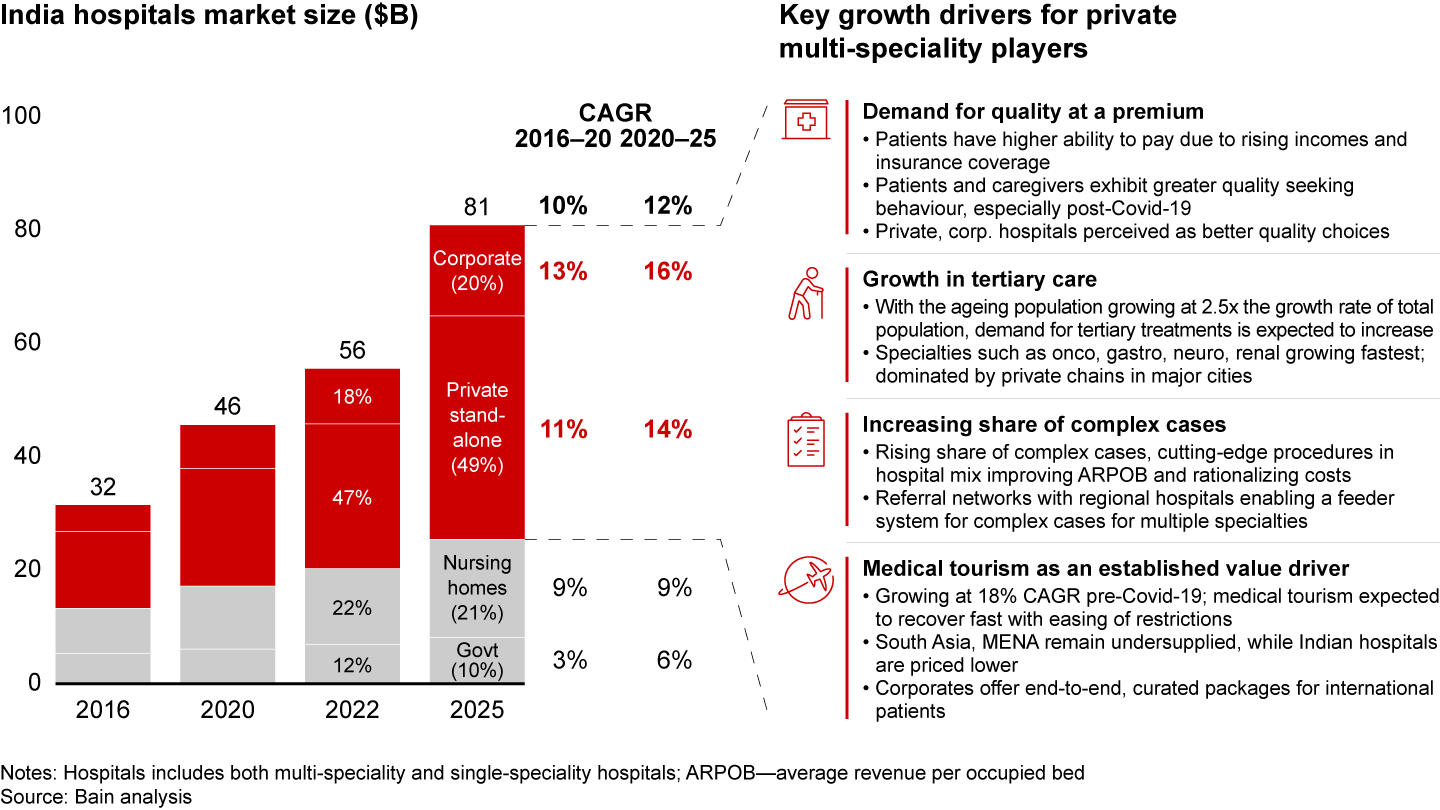
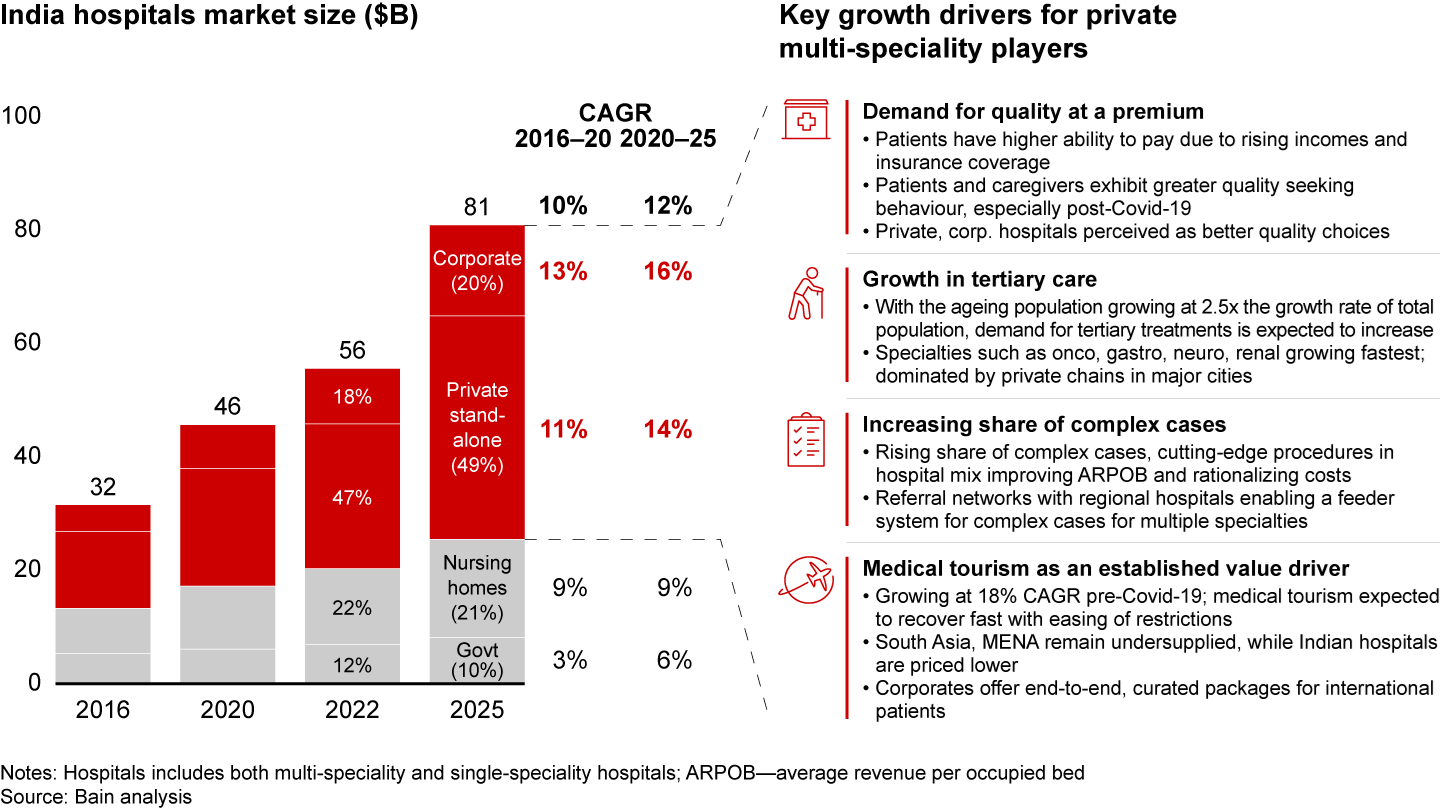
Single-speciality formats are developing great product-market fit and are attractive for investors
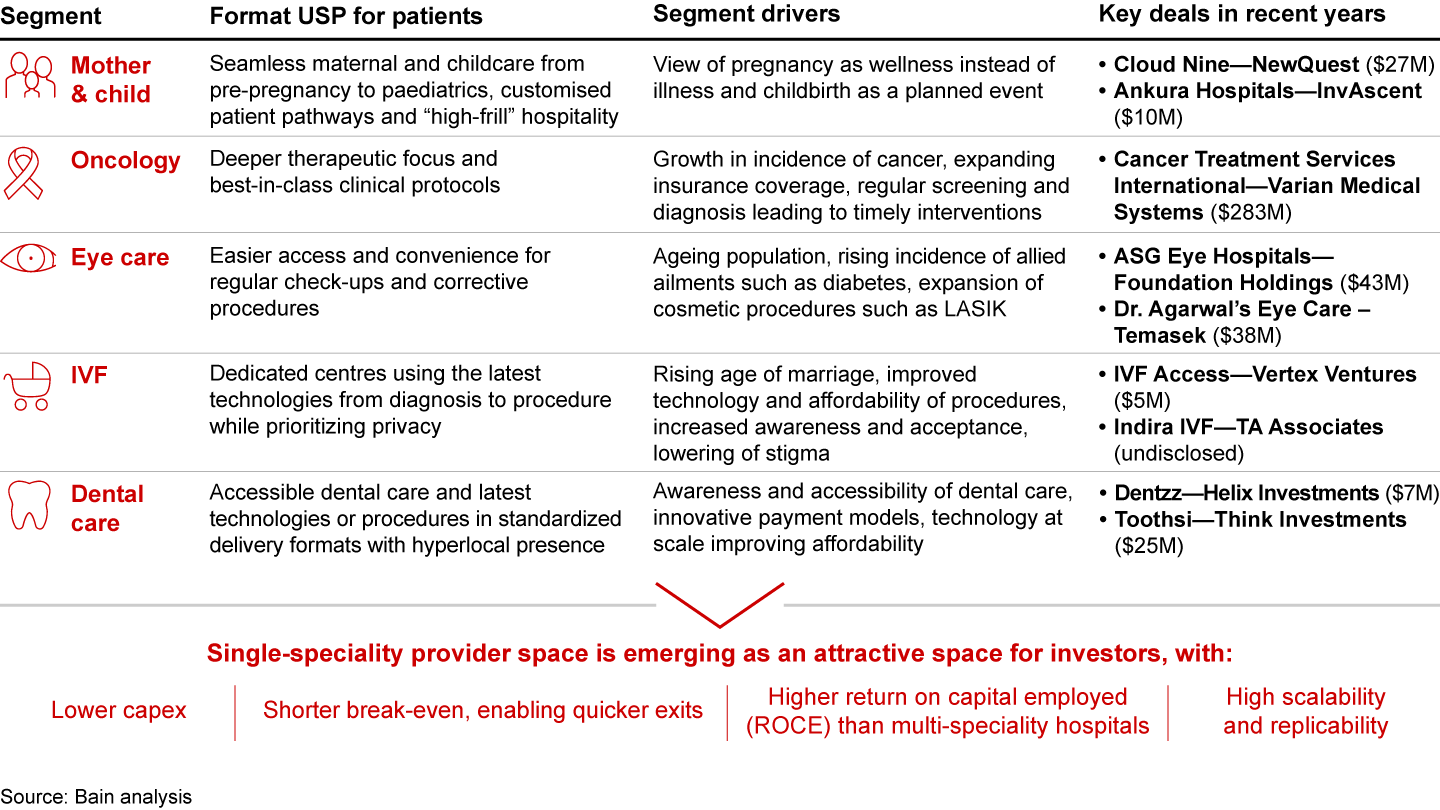
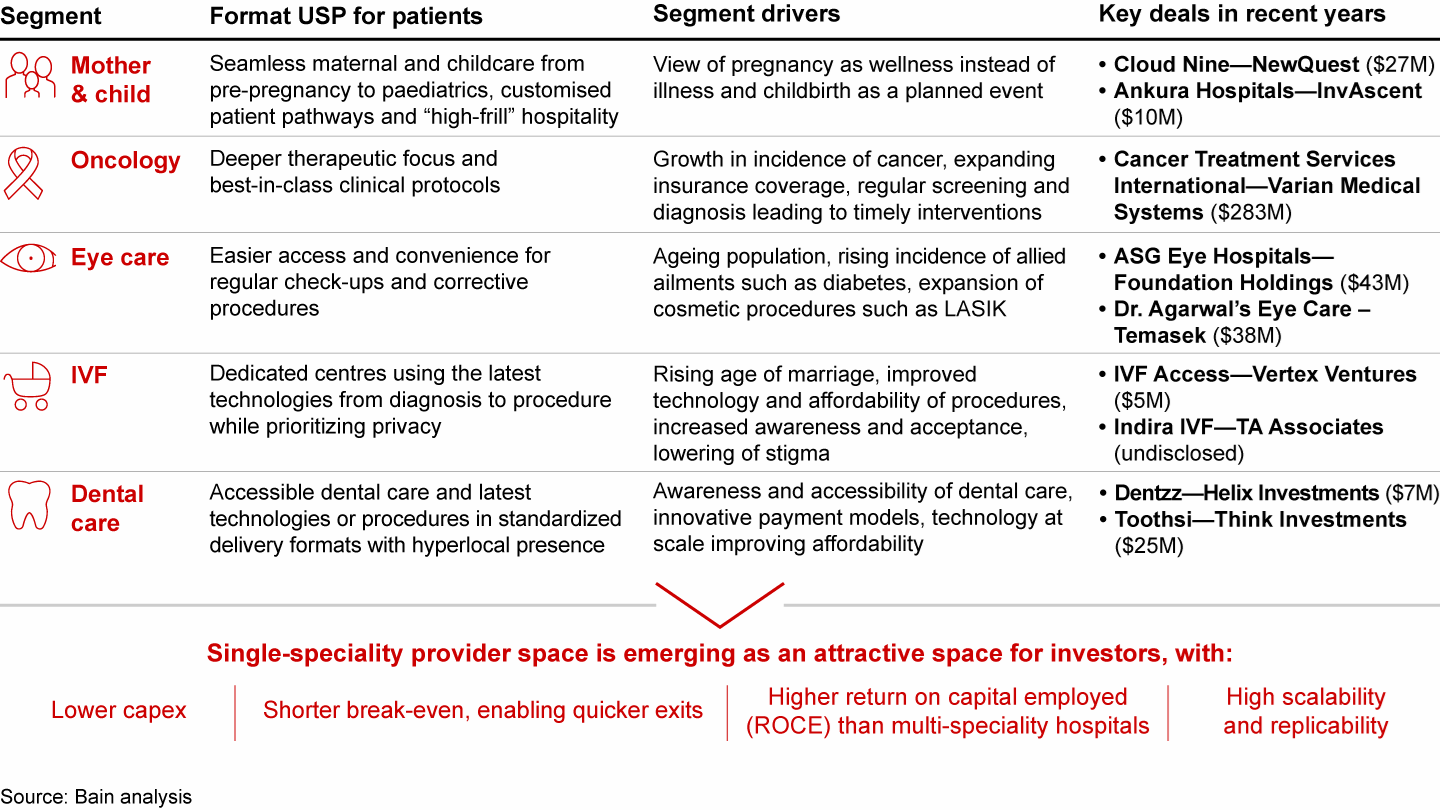
An already expanding segment pre-Covid-19, diagnostics has picked up pace with various complementary trends driving growth
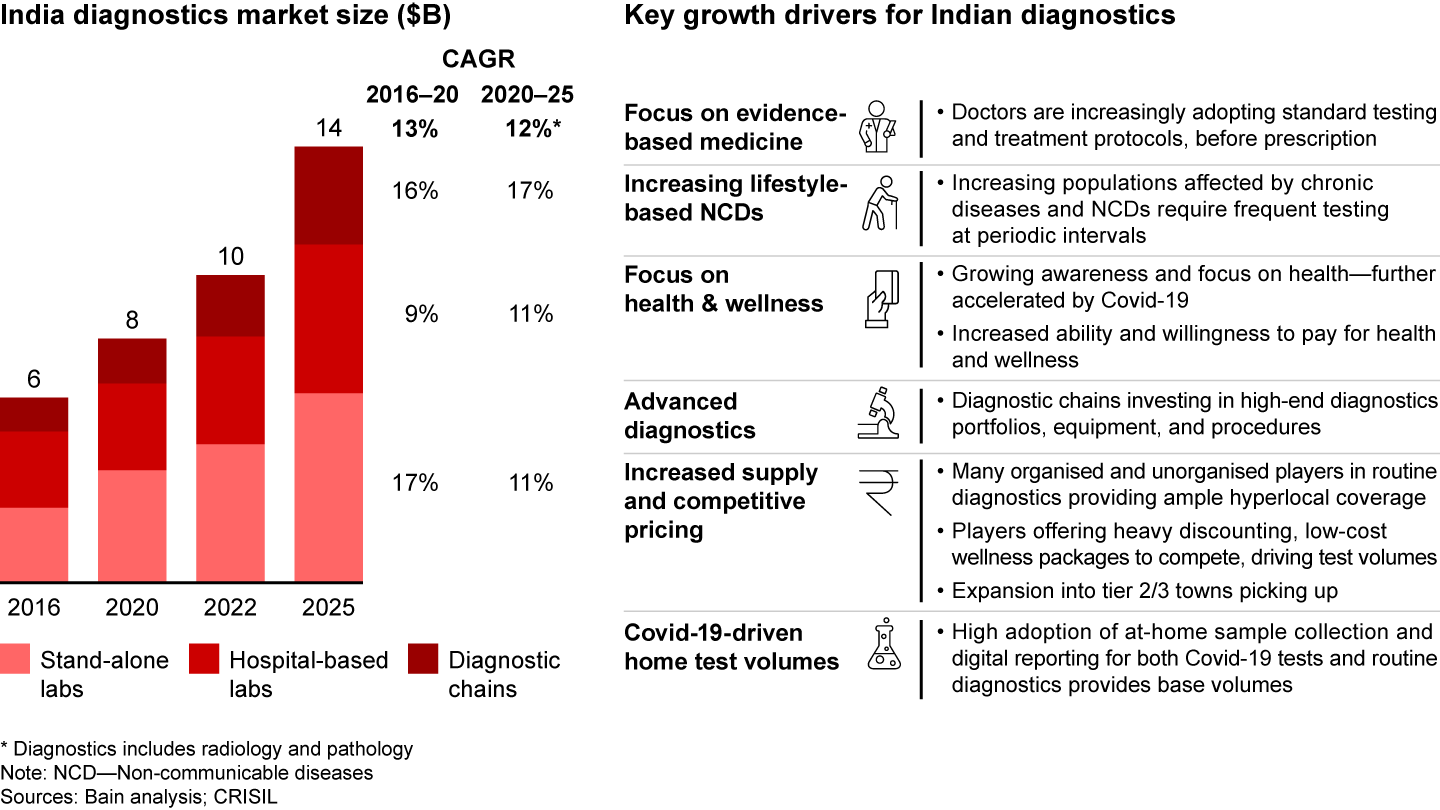
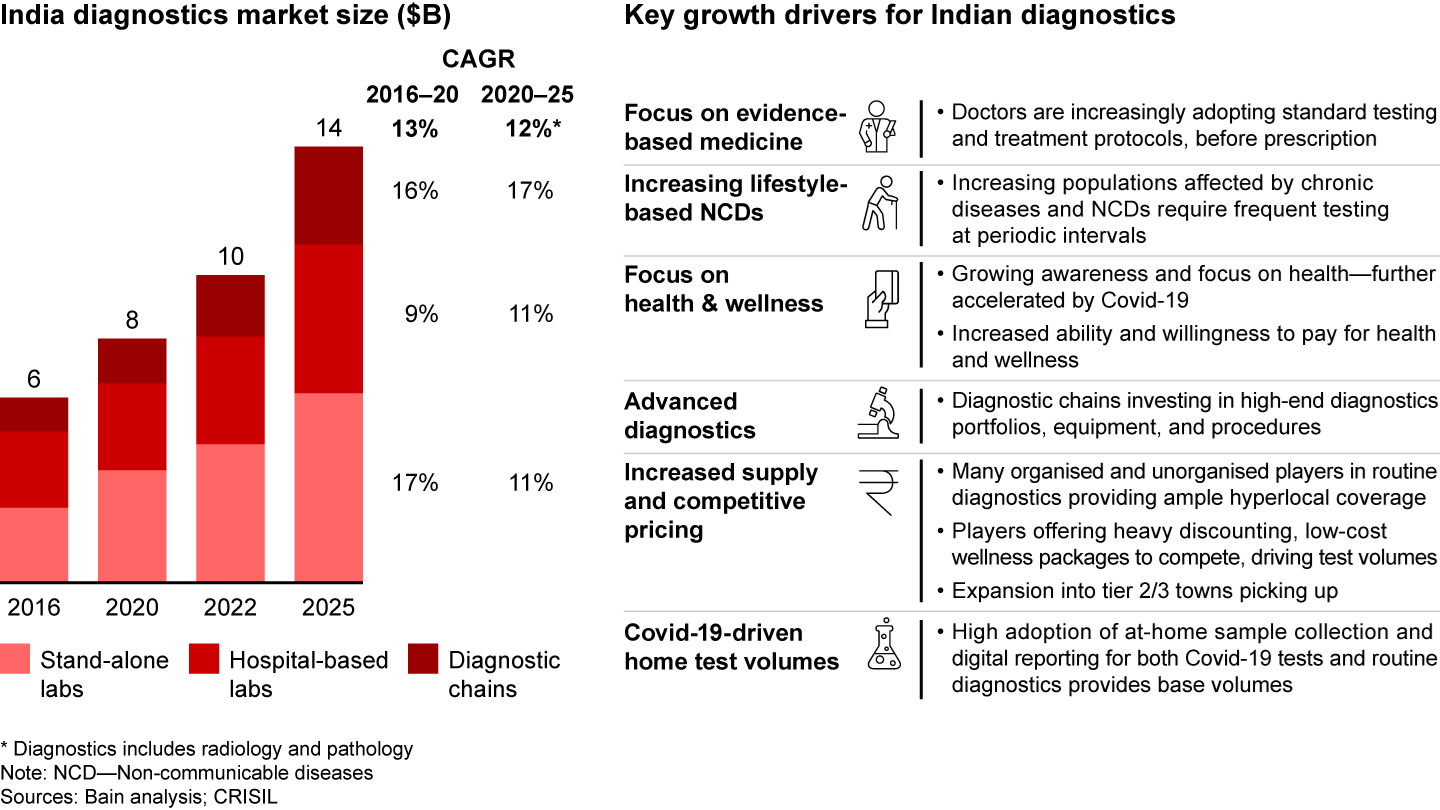
Fund landscape: An evolving investor ecosystem for value creation
- Top 10 funds have invested close to $43 billion in India in the last three years. The largest deals from these investments are in IT/ITES and telecom (largely in Jio Platforms and Airtel).
- Major LPs are getting more active and co-investing with GPs on large assets. 2021 saw 2x activity from LPs compared to their average deal activity across 2018–2020.
- The increase in LP participation in deals bodes well for PE in India as it unlocks access to larger deals with a shared risk for investors and allows a win-win for both GPs and LPs.
- The quantum of buyouts has been picking up, with a 5x growth in the last five years to reach $16 billion. In 2021, 46% of all PE deals were buyouts, compared to 33% in 2016. The average buyout deal value has expanded 3x to reach nearly $900 million in 2021.
- Blackstone, Baring, Carlyle, Advent, GIC, and KKR are most active in buyouts and have individually deployed more than $1 billion in taking majority control of firms in the last three years.
- The expansion in buyouts coupled with larger valuations is leading to a higher emphasis on value creation through operational turnarounds, for which funds are setting up internal operations teams.
Top funds have invested close to $40B in India in the last three years with the largest investments in IT/ITES and telecom

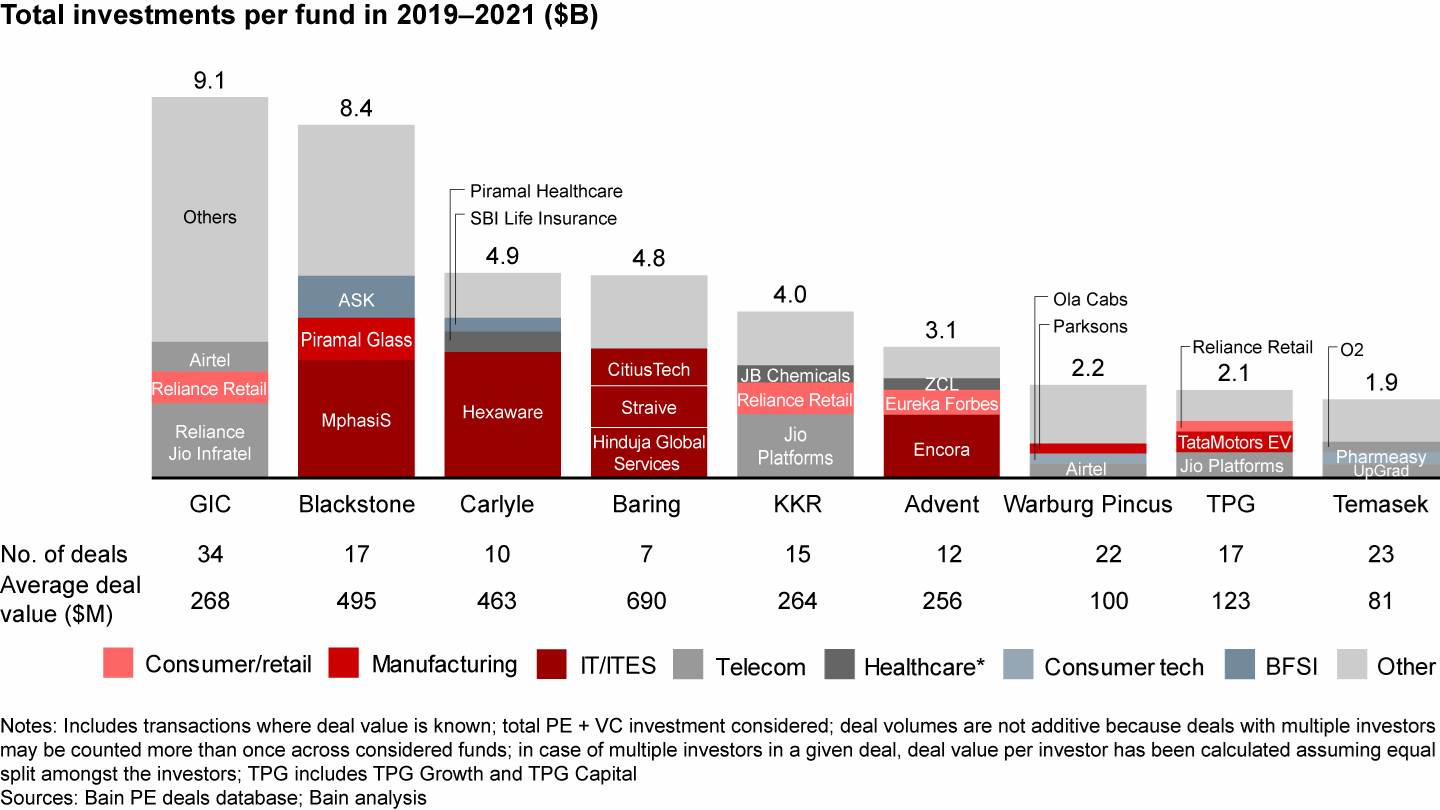
In a maturing investment ecosystem, certain trends are leading to changes in the traditional fund model
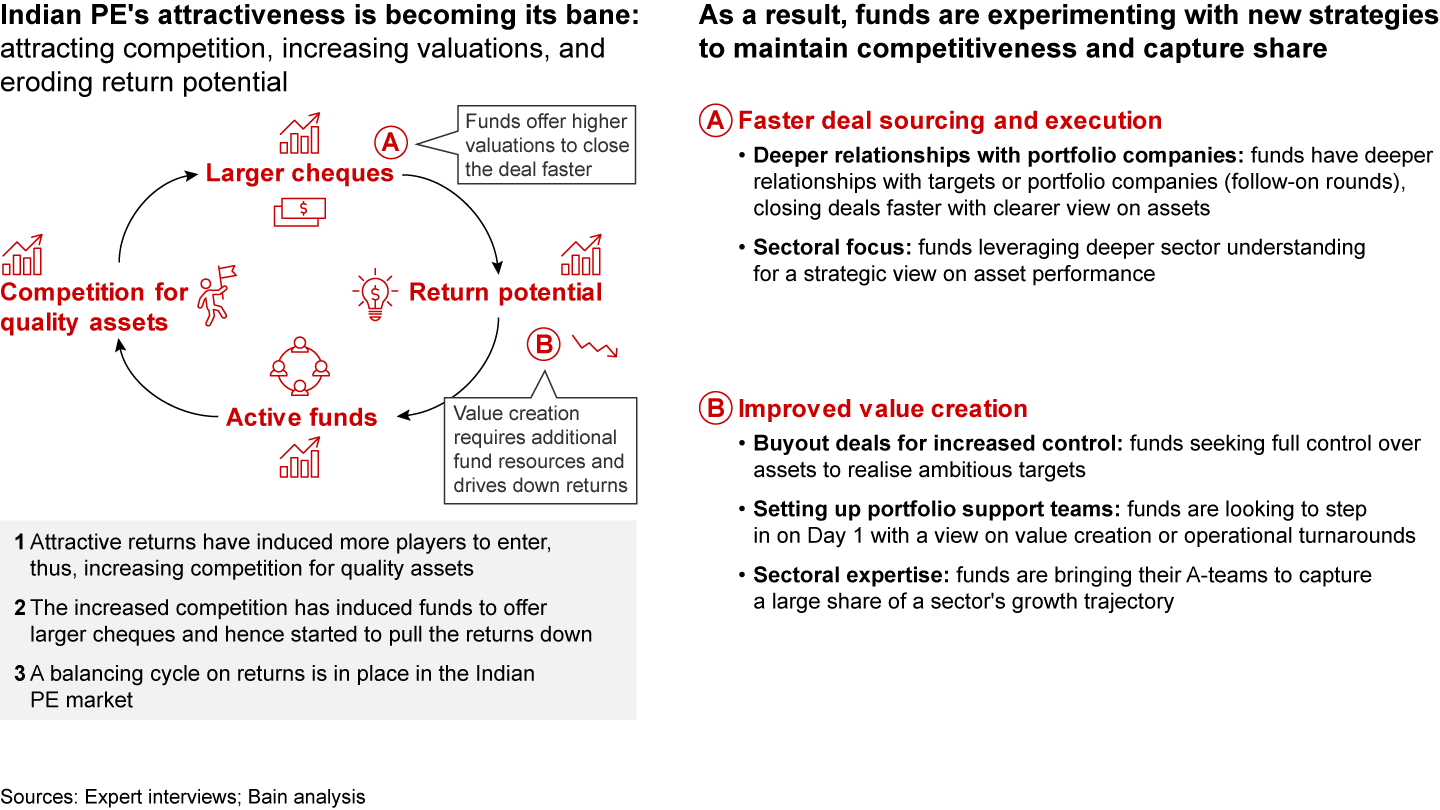
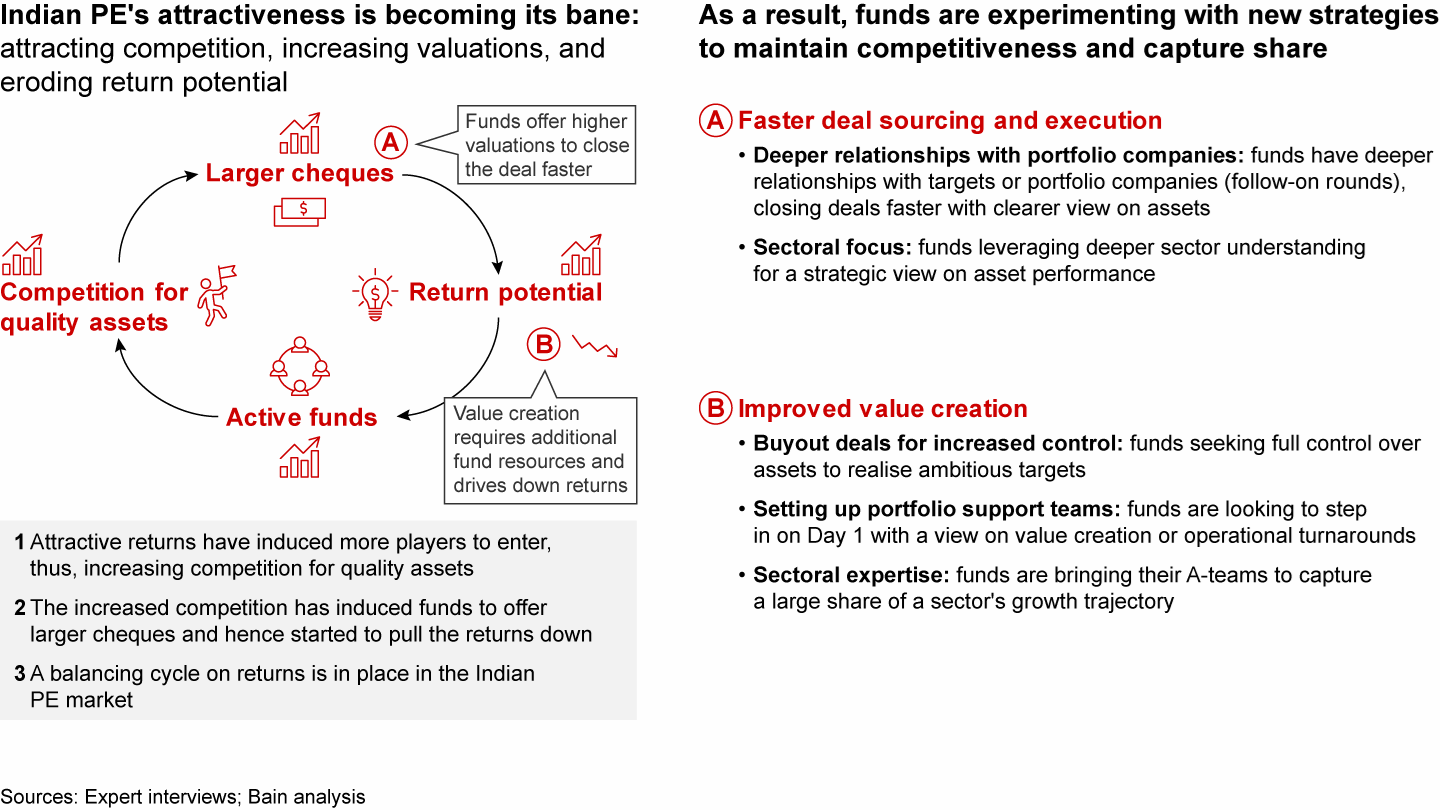
Funds are exhibiting preference for buyouts in PE and directing more capital toward control over quality assets
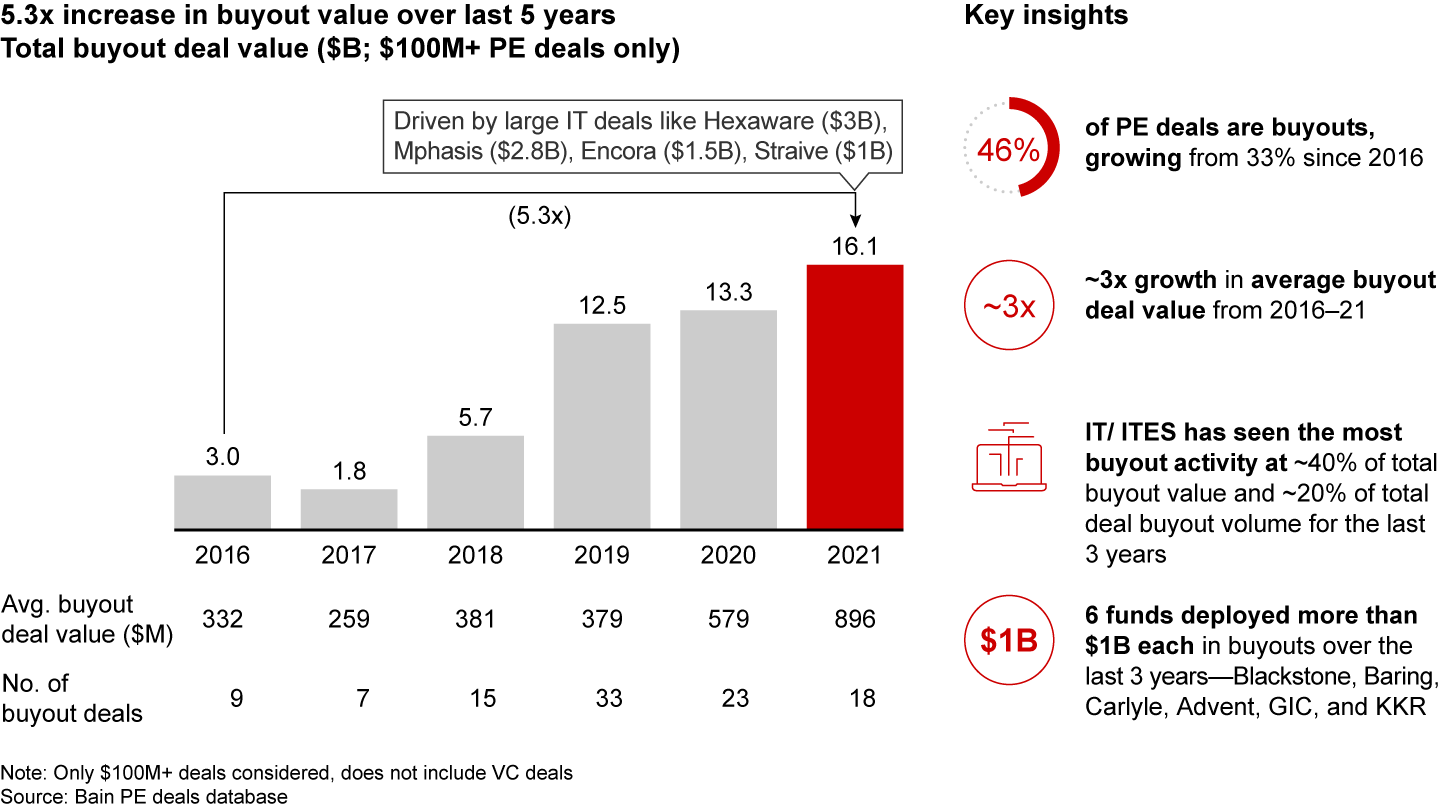
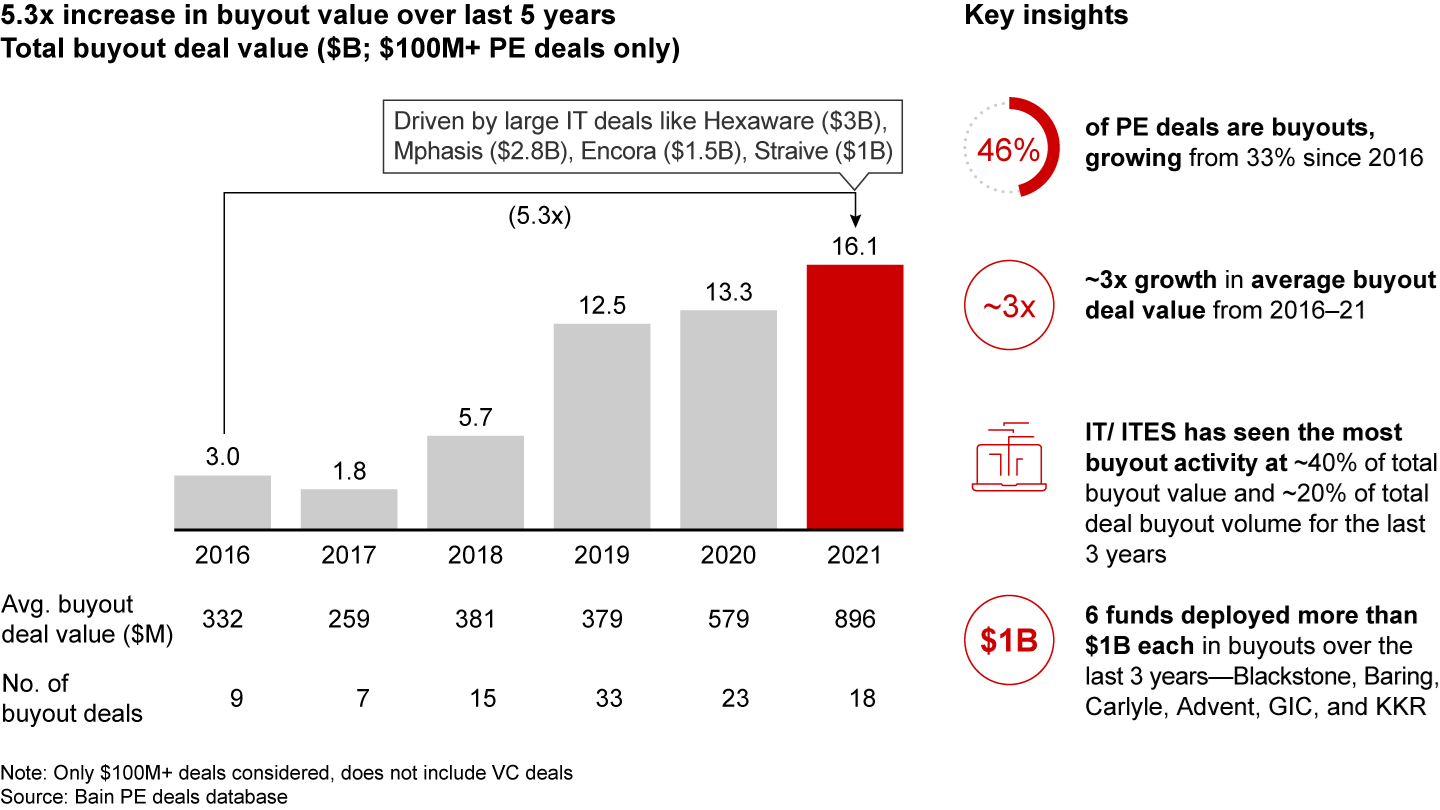
LPs are becoming more active exploring co-investing with GPs

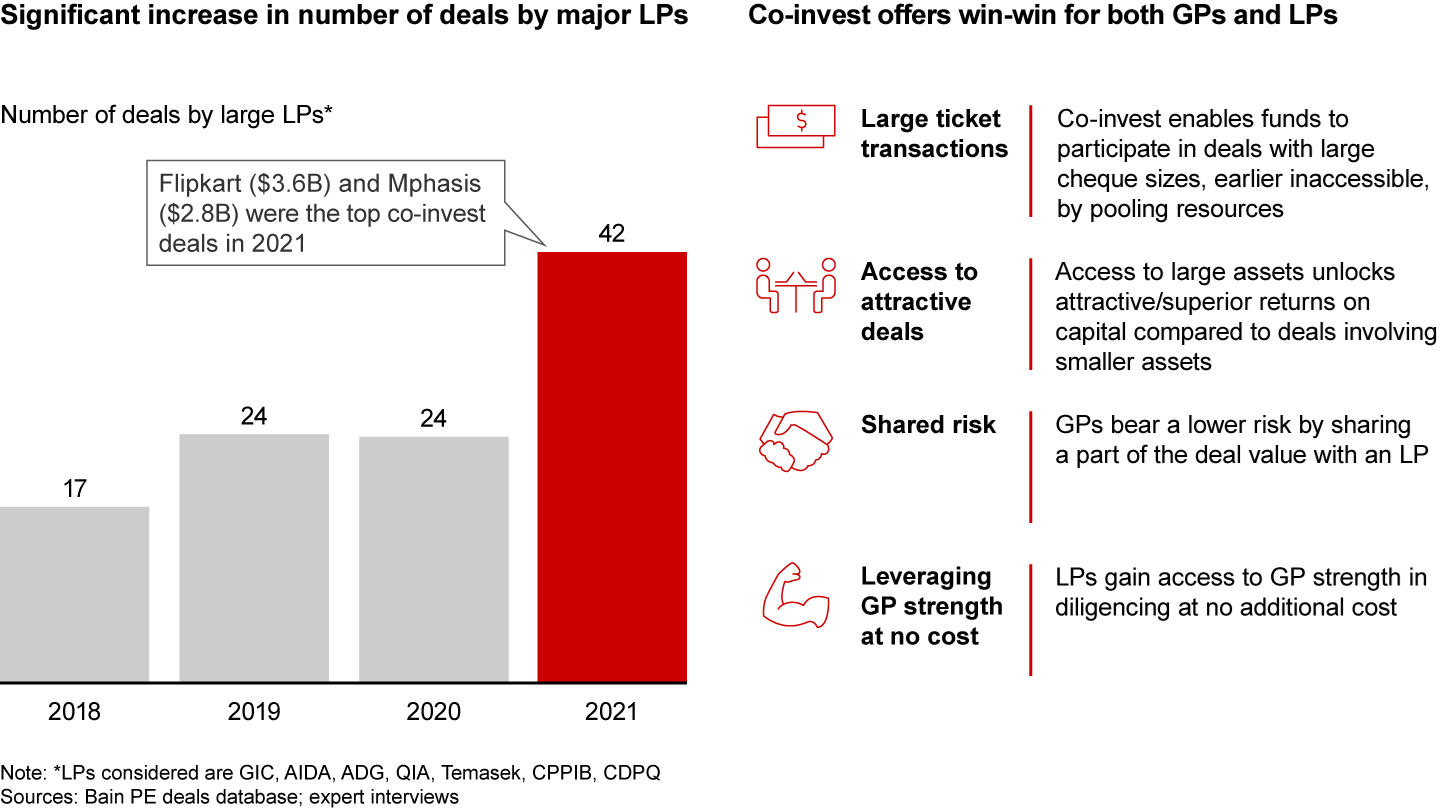
Exits: Hitting the peak
- Exits were at an all-time high in 2021, picking up rapidly from the past year’s lull across all routes of exit. 2021 saw more than $36 billion in exits, quadrupling the value over 2020’s approximately $9 billion. Even though the exit sentiment was muted in the second quarter of 2021 owing to India’s devastating second wave of Covid-19, H2 saw a flurry of activity, especially in IPOs and other public market sales.
- Exits of >$100 million nearly tripled in volumes and grew by 69% in size, as all sectors witnessed an acceleration in exits and exit value.
- Strategic sale continues to be the most dominant route of exit, with almost 50% of all exits over the last few years. Secondary sale and strategic sale are becoming the most preferred exit routes, expanding by 28% and 23% respectively each year, over the last three years.
- The size of exits grew significantly faster than the exit volumes, indicating higher valuations. Public markets are also showing an appetite for large exits, with an average size of exit reaching $266 million, at a CAGR of 95% since 2019.
- Fund portfolios looked much younger by the end of 2021 than at the beginning of the year, in a testament to the pace of both deal making and exit activity.
- The average size of top 10 exits increased fourfold to nearly $2 billion, and 9 exits surpassed $1 billion in value. BFSI and consumer technology dominated as the top industries for exits.
- Exit returns increased by 1.2x to 5.6 in 2021 driven by high multiples on invested capital and large volume share of consumer technology, IT/ITES, and BFSI exits, like the last year.
- Exit momentum is expected to continue this year, but the public market sentiment will see moderation even though a strong future IPO pipeline led by BFSI and consumer tech awaits.
Exit value crossed $36 billion in a bumper year with a 4x jump over 2020 and a 2x rise over decadal high (excluding Flipkart mega exit)
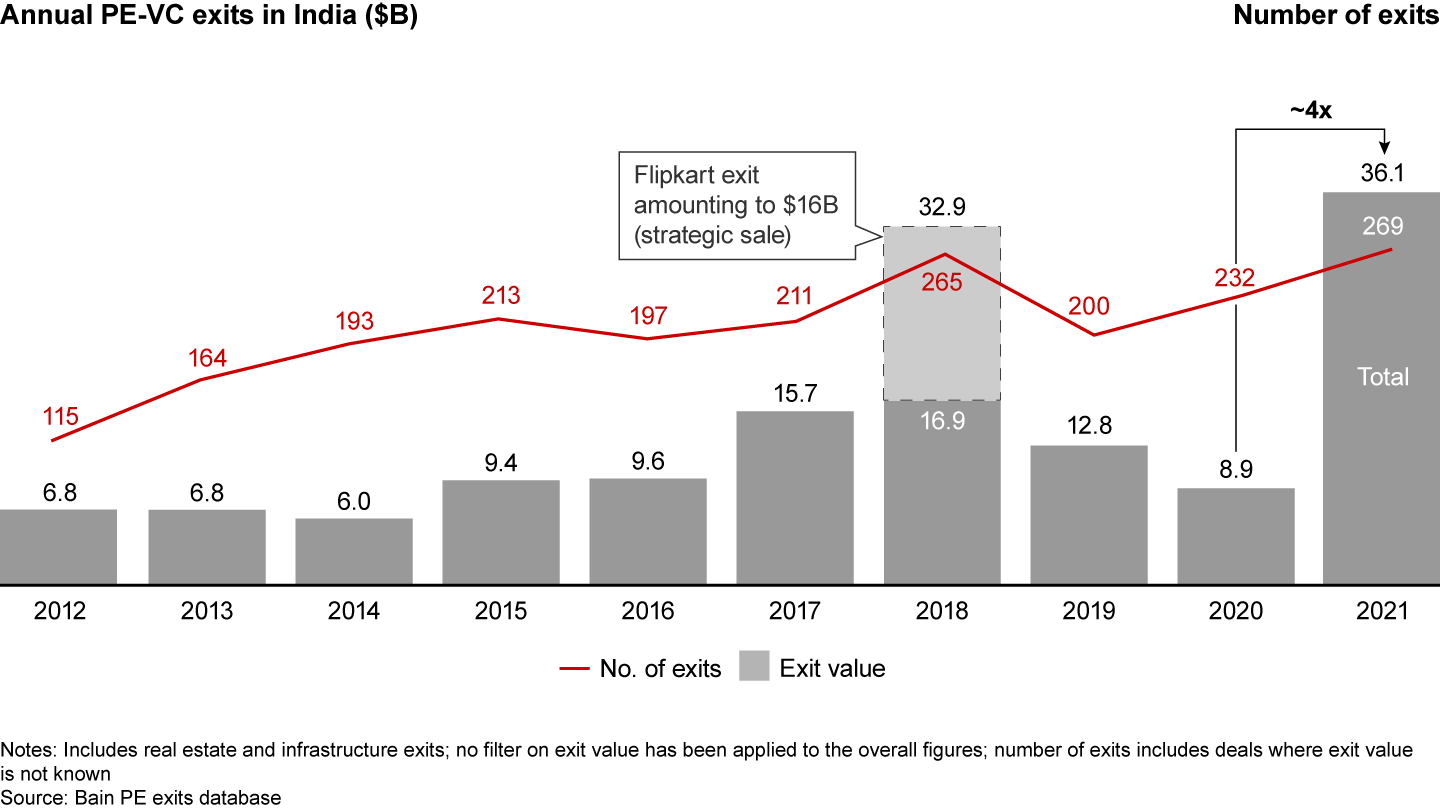
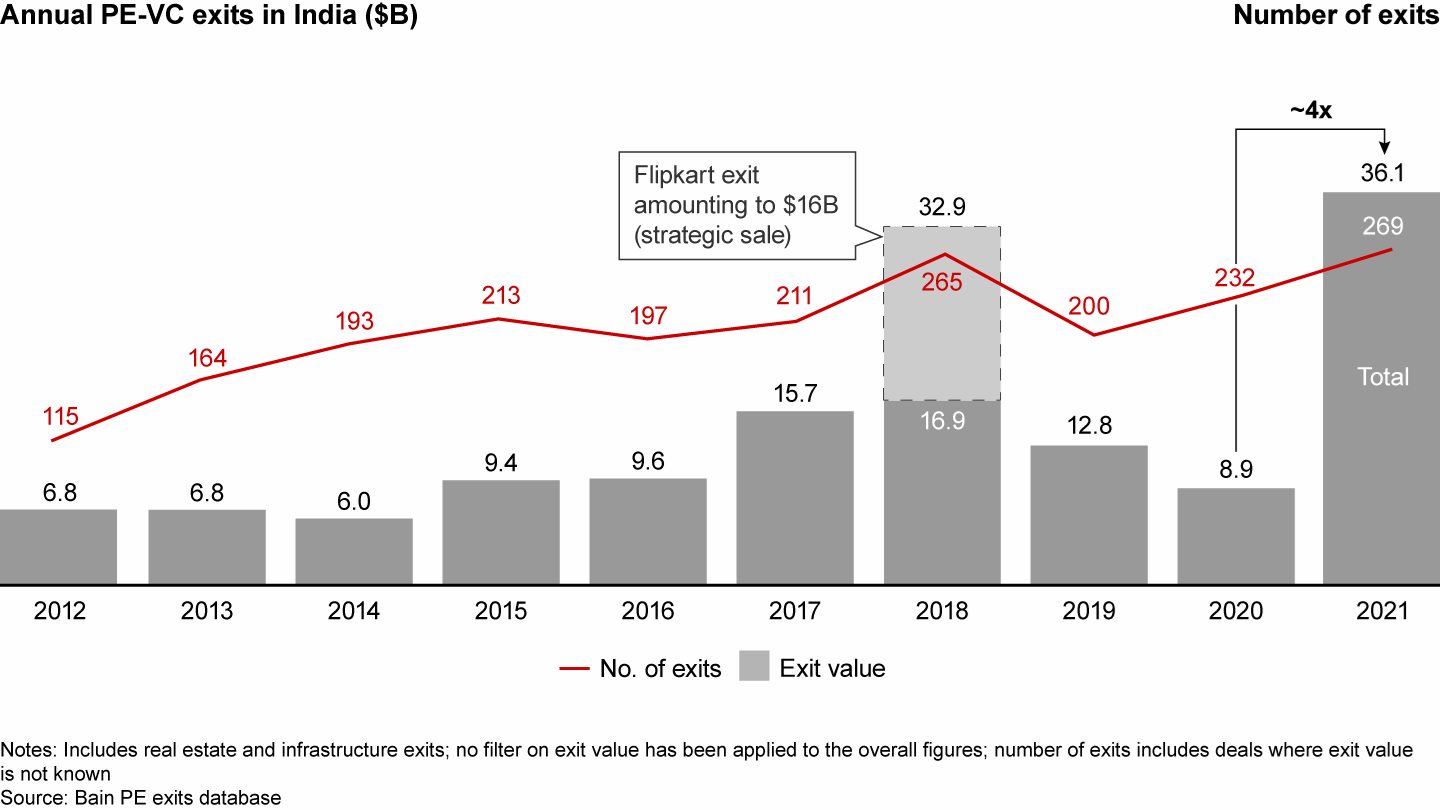
Strategic sale continues as the dominant mode of exit, while size of exits expanded across all routes
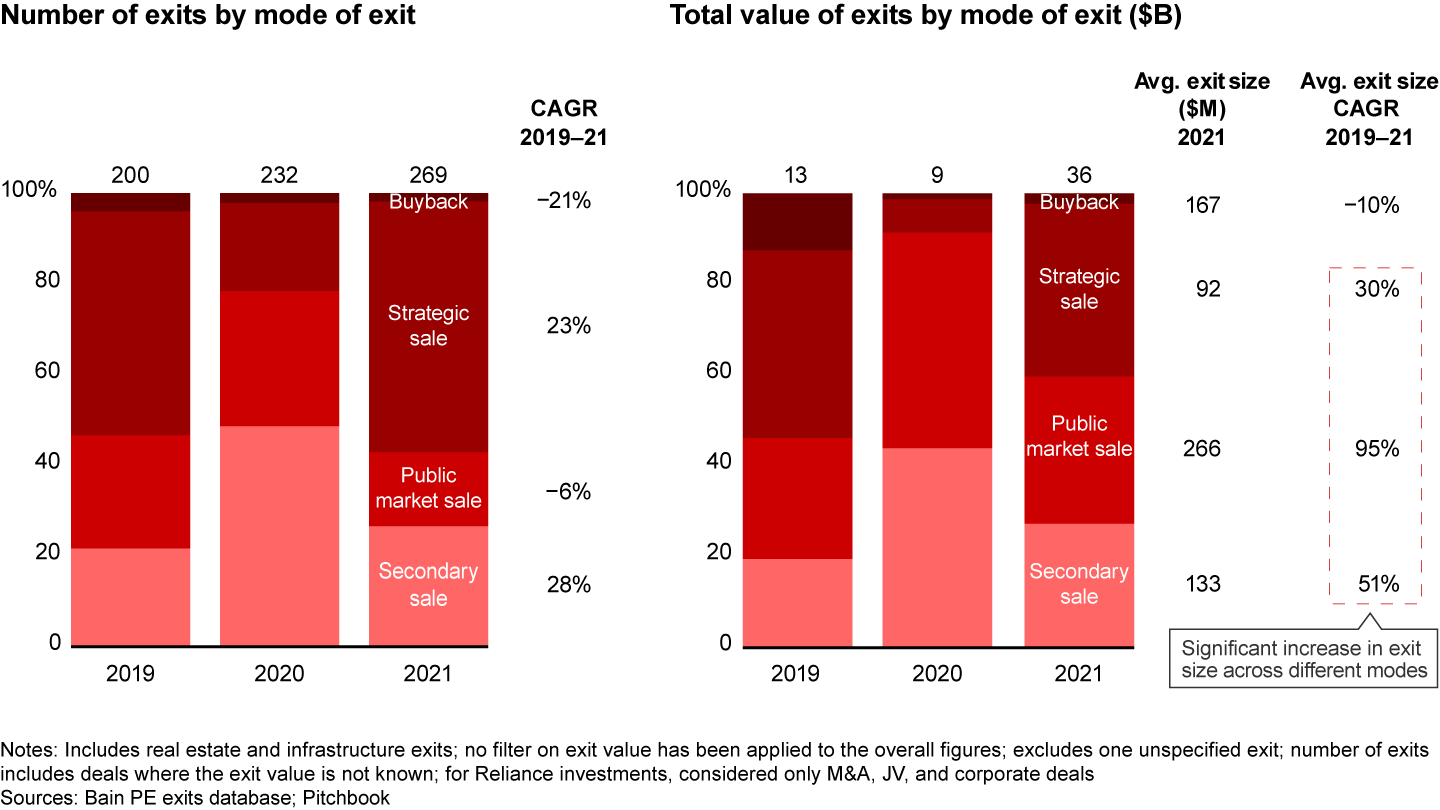
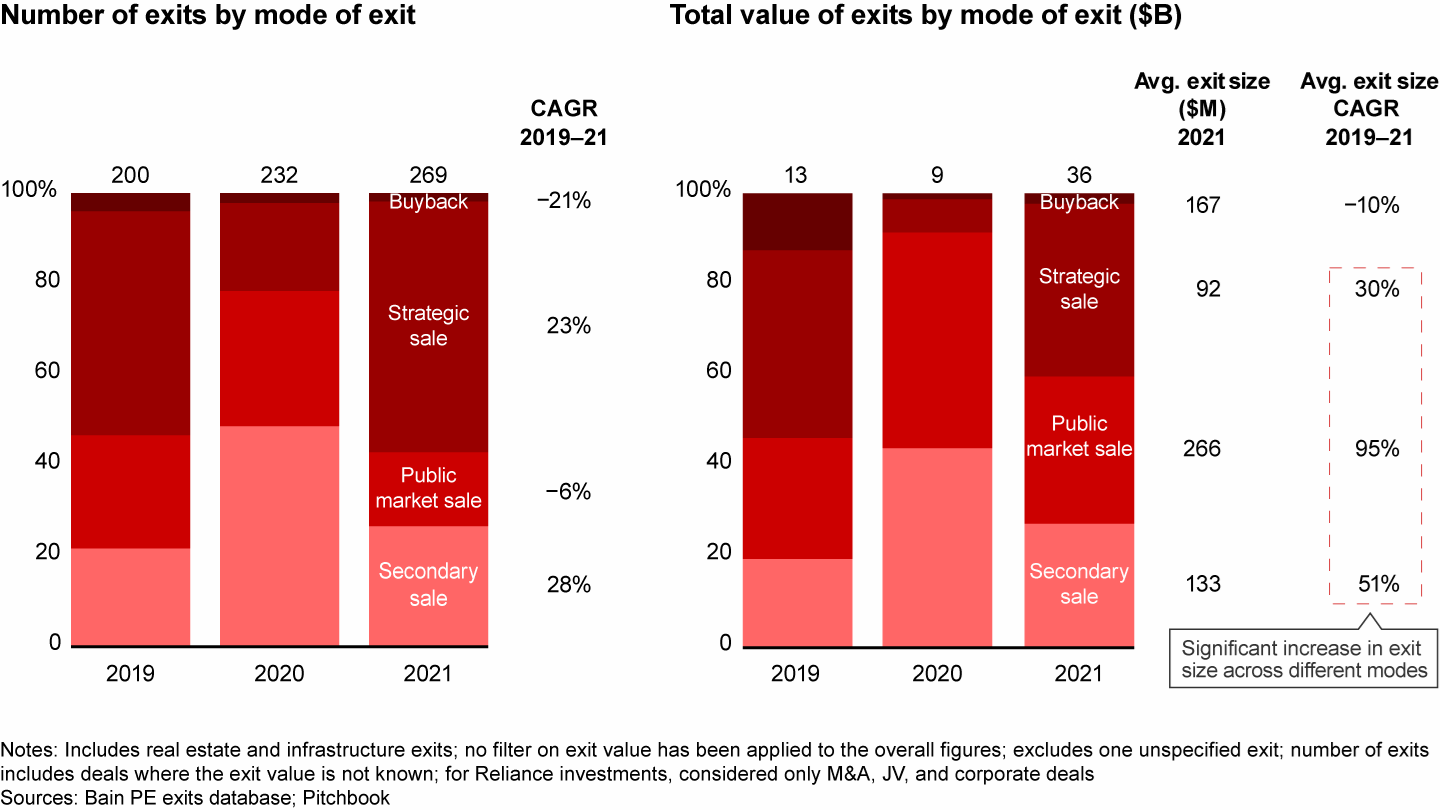
Large exit volumes almost tripled and exit size expanded across sectors, reflecting the buoyancy of the market
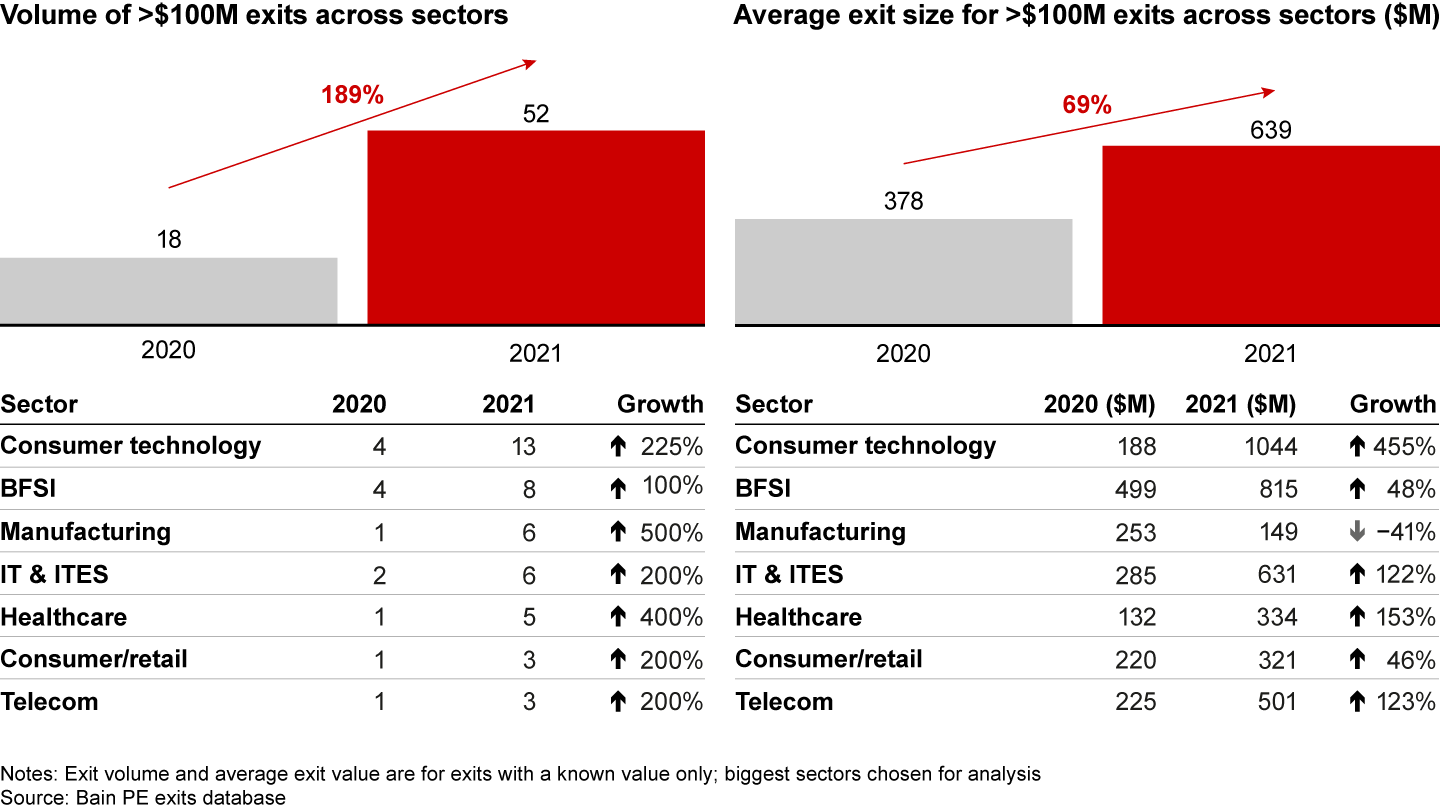
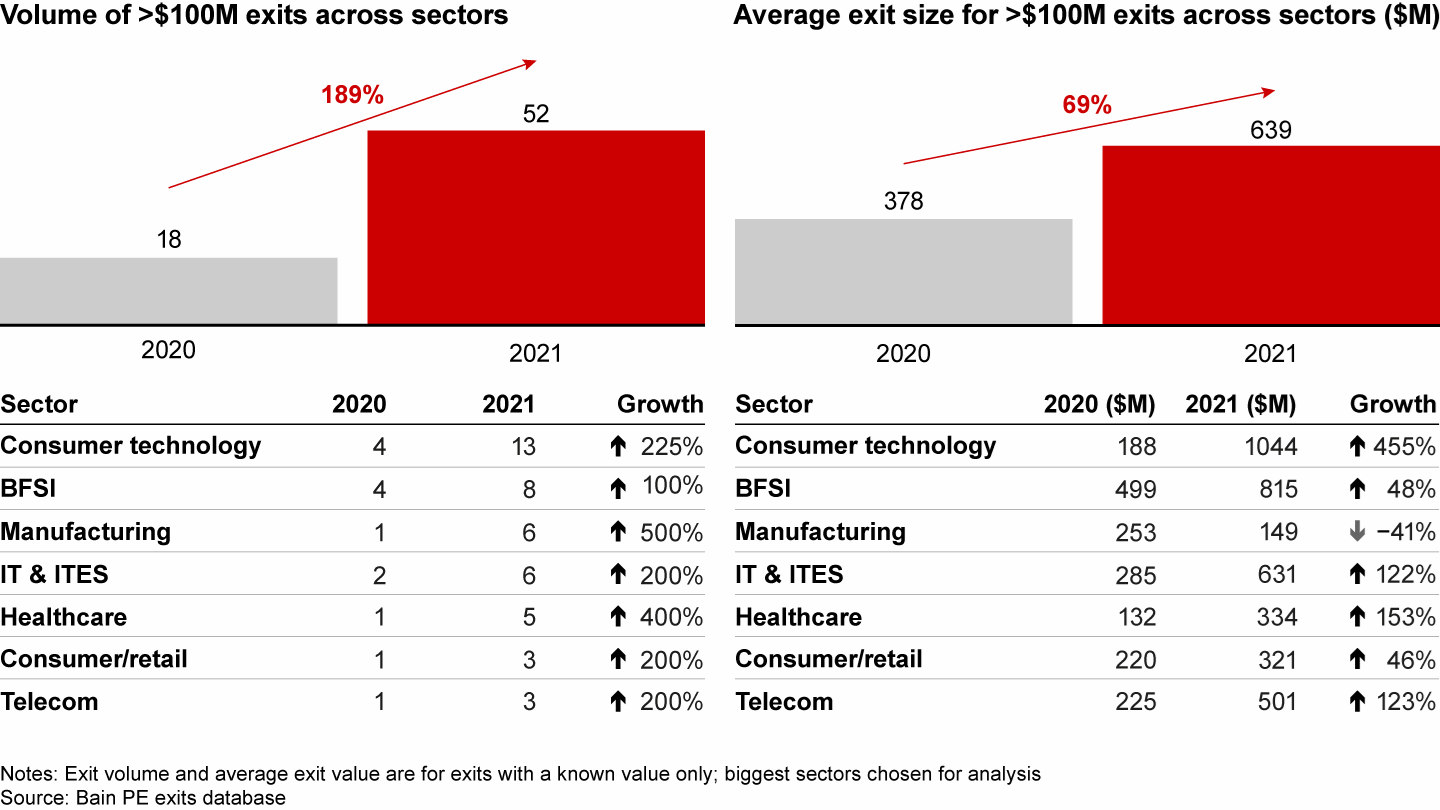
Moving forward from a bumper year for exits, the outlook stays optimistic, but slight moderation expected in the near term
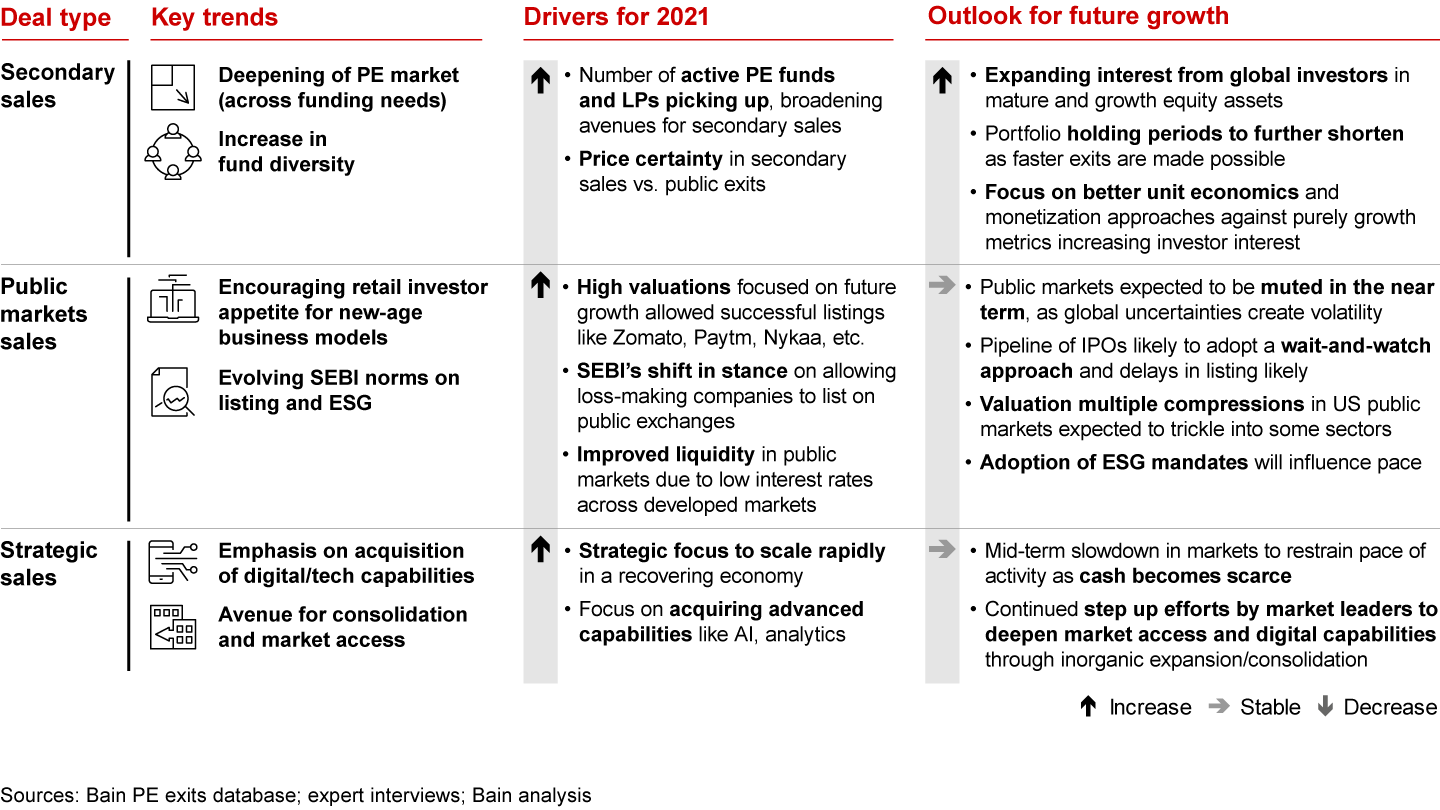

Fund portfolios look much younger due to the pace of deals and exits
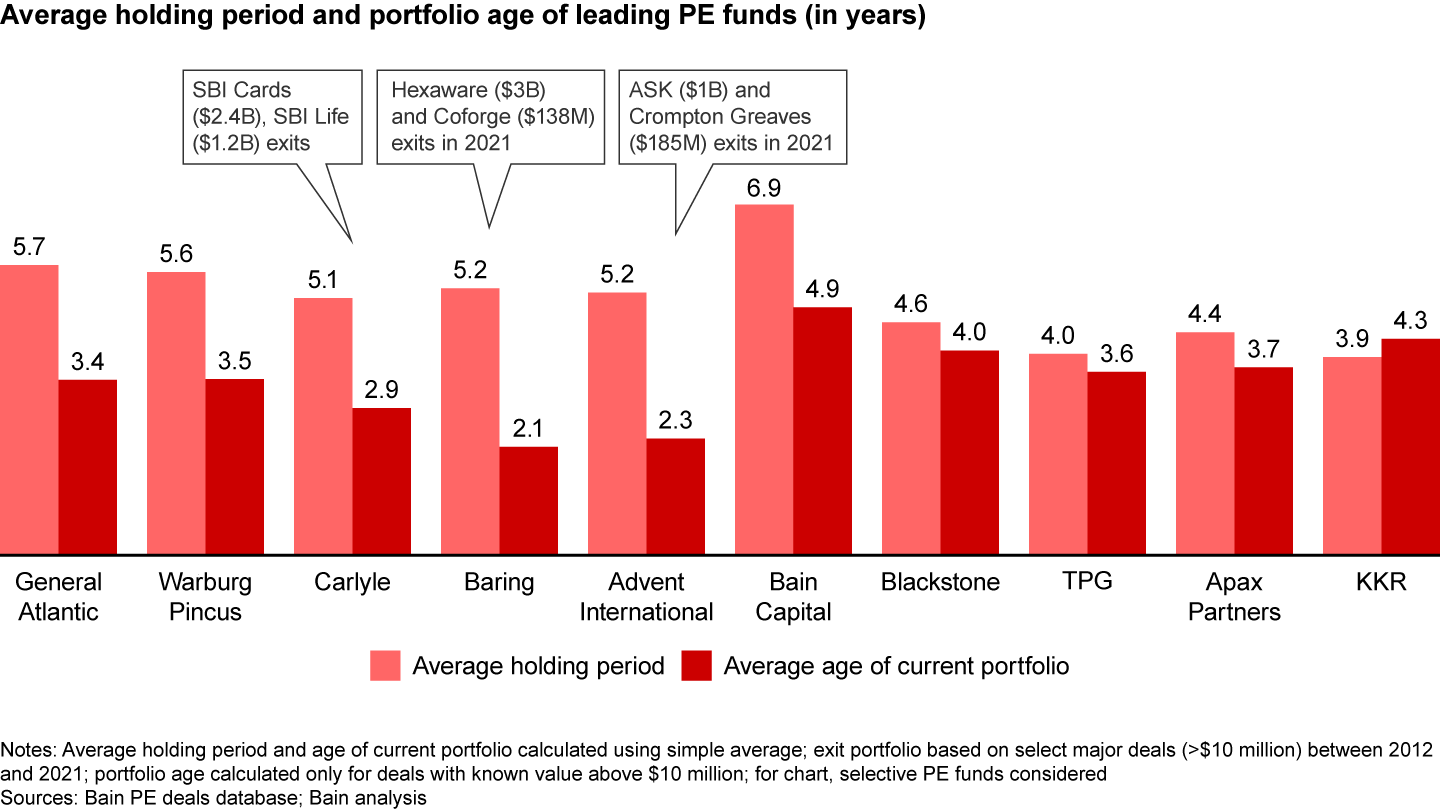
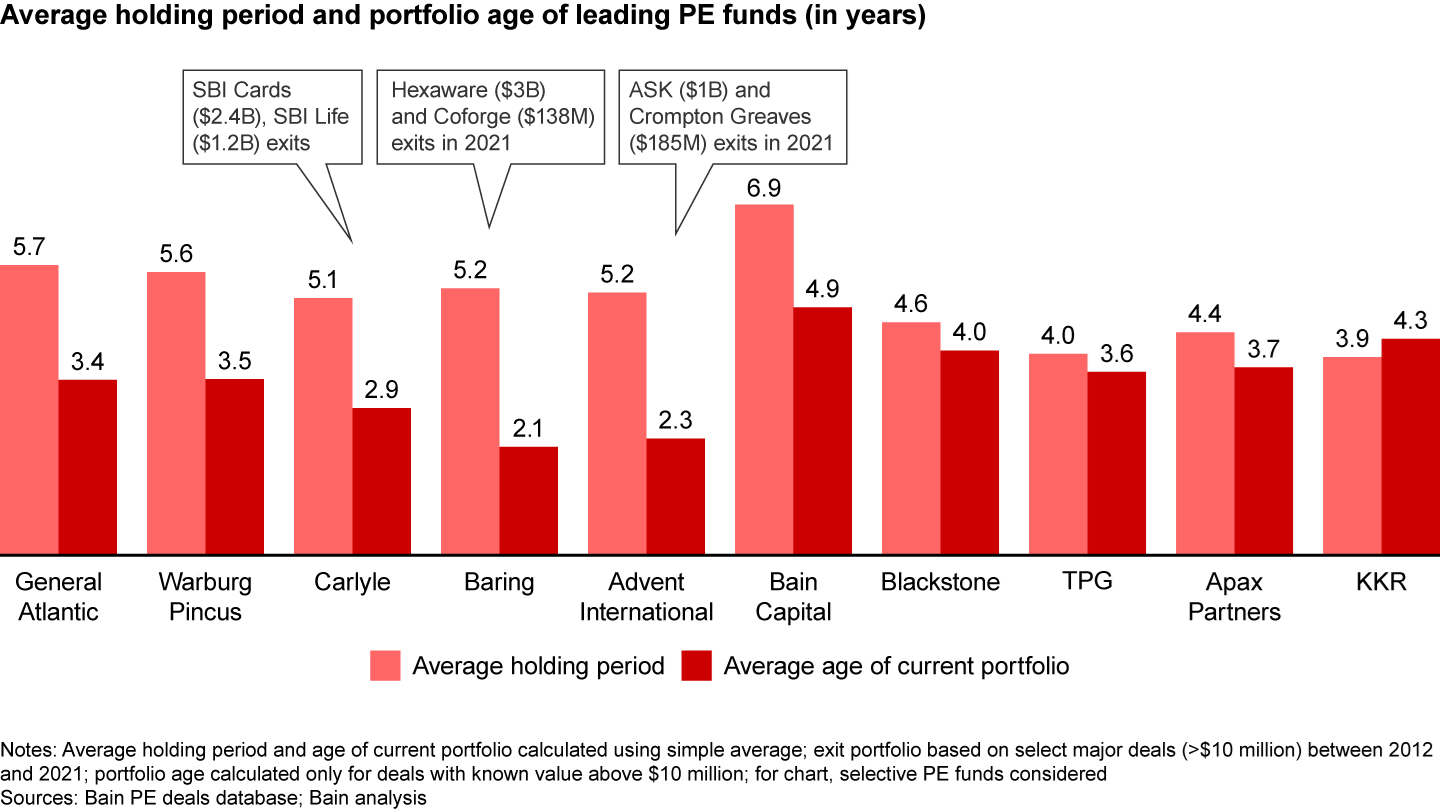
Nine exits surpassed $1 billion in value and the size of top exits quadrupled
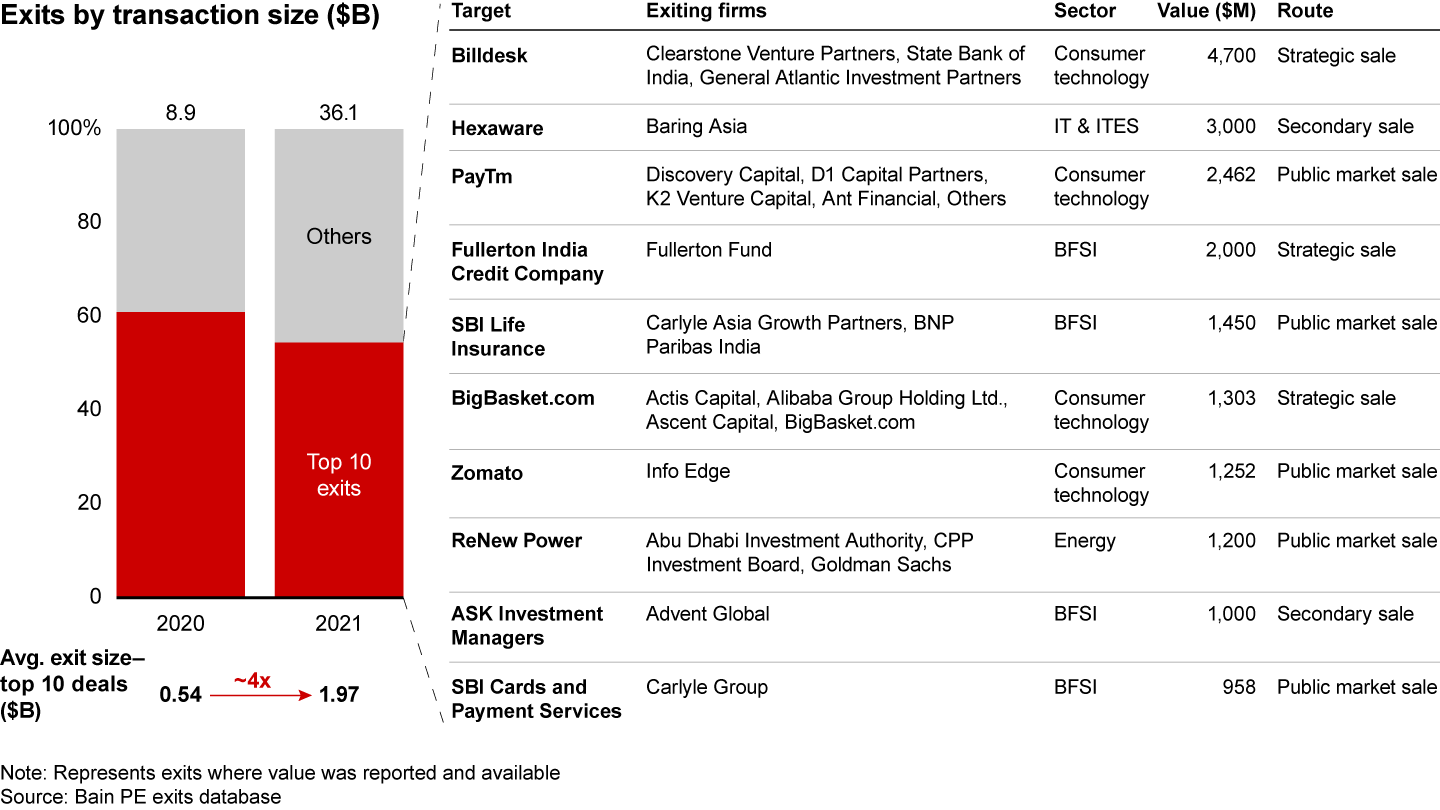
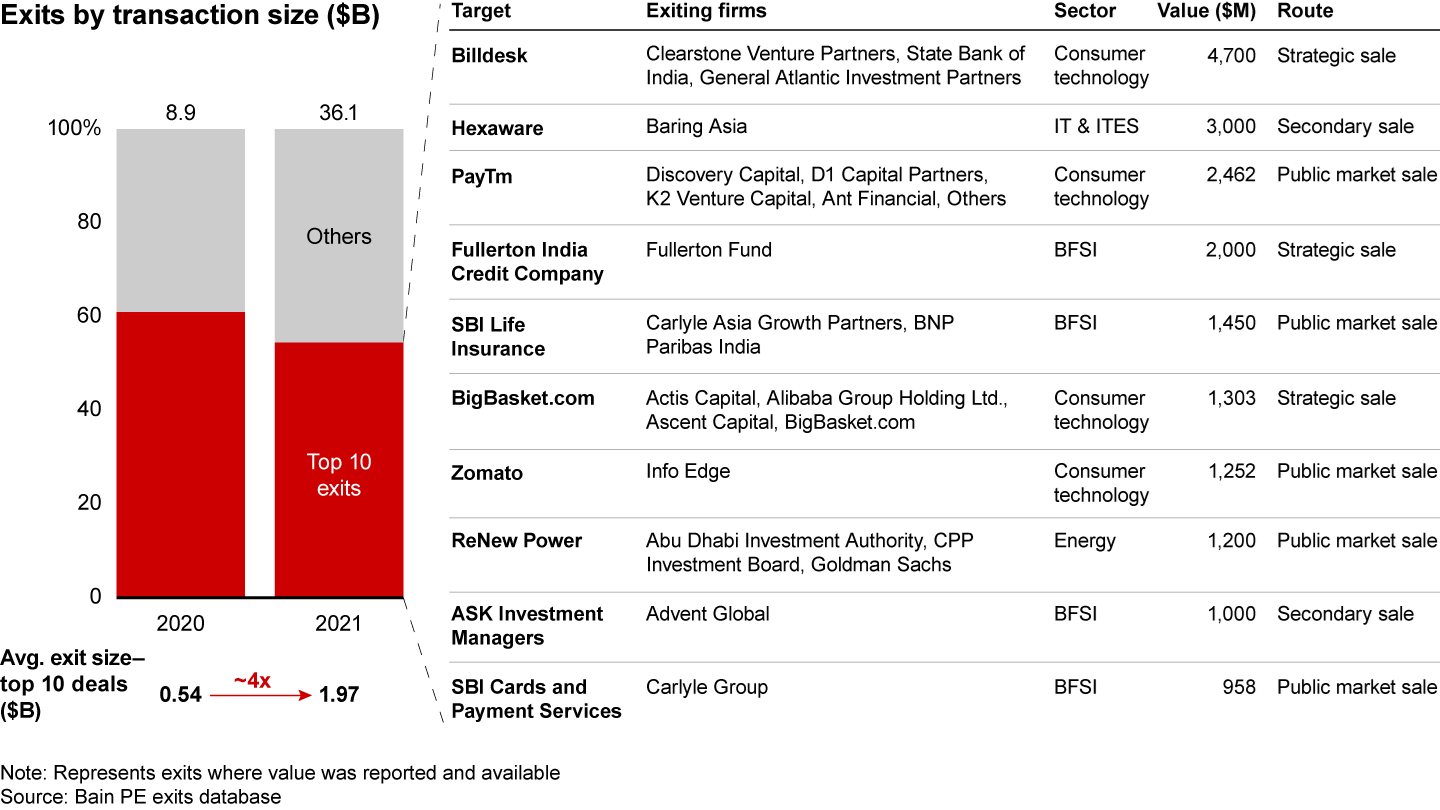
Public markets were buoyant in Q4 of 2021, enabling great listing gains for IPOs and other public market sales
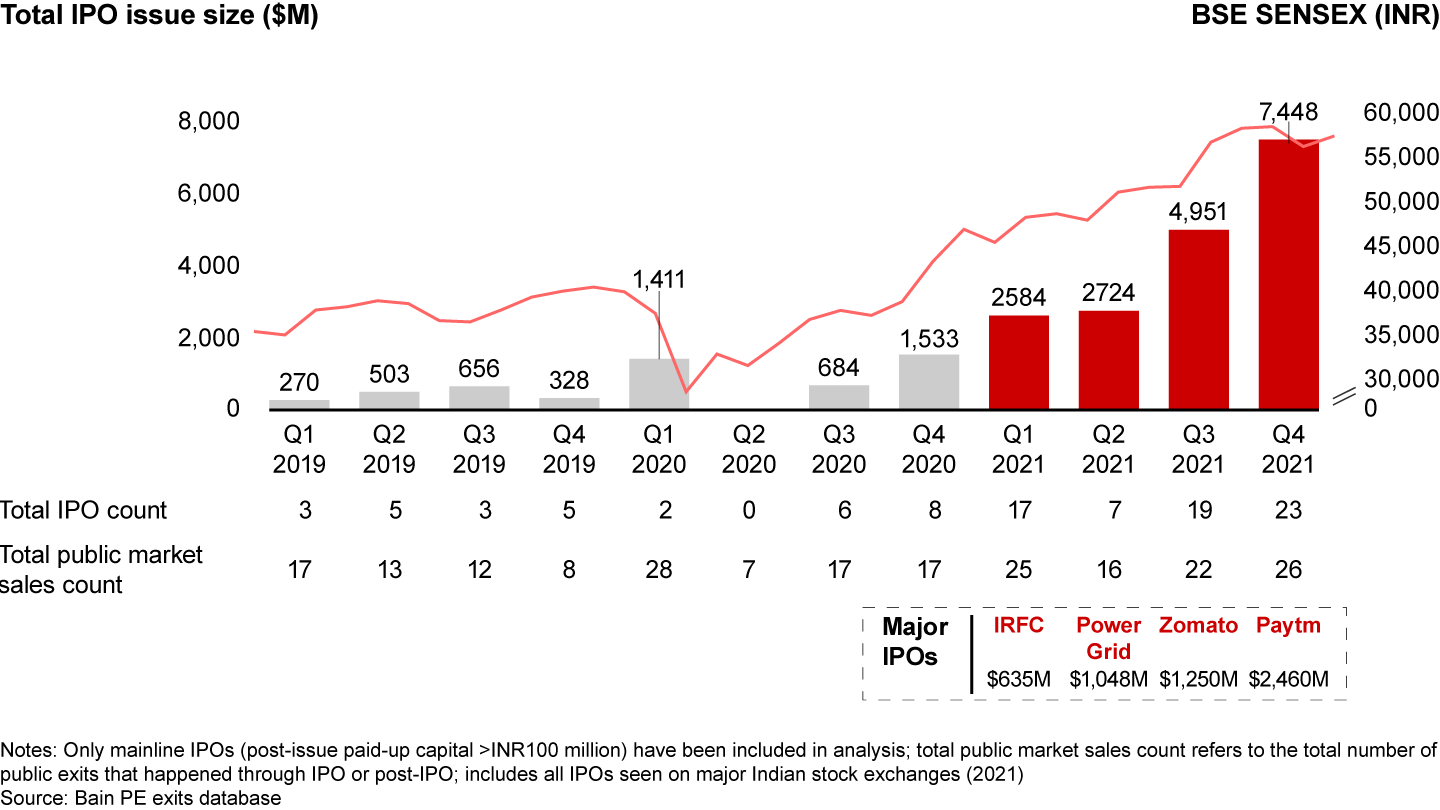
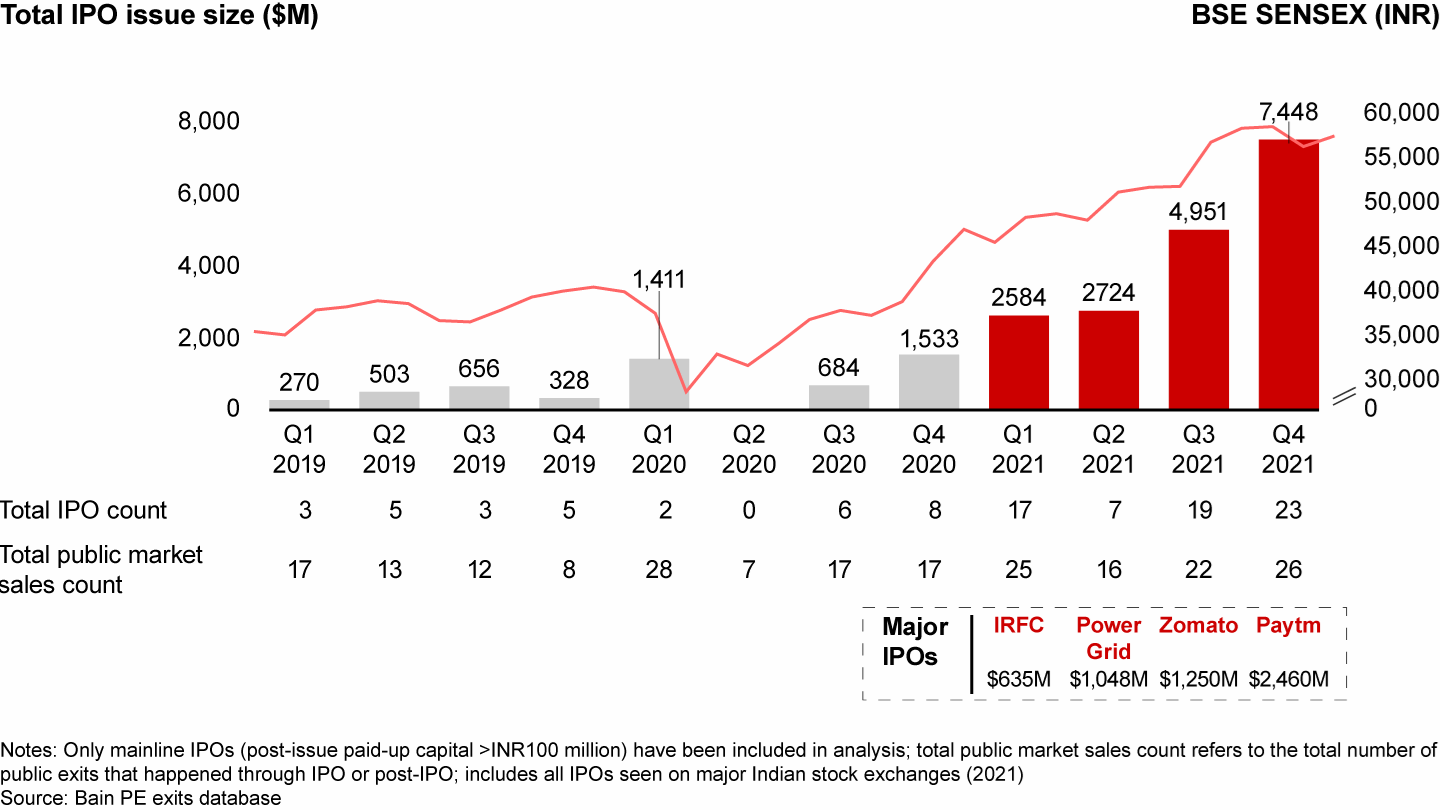
2021 saw a 1.2x increase in exit multiples, driven primarily by high returns from exits in healthcare, IT, and consumer tech
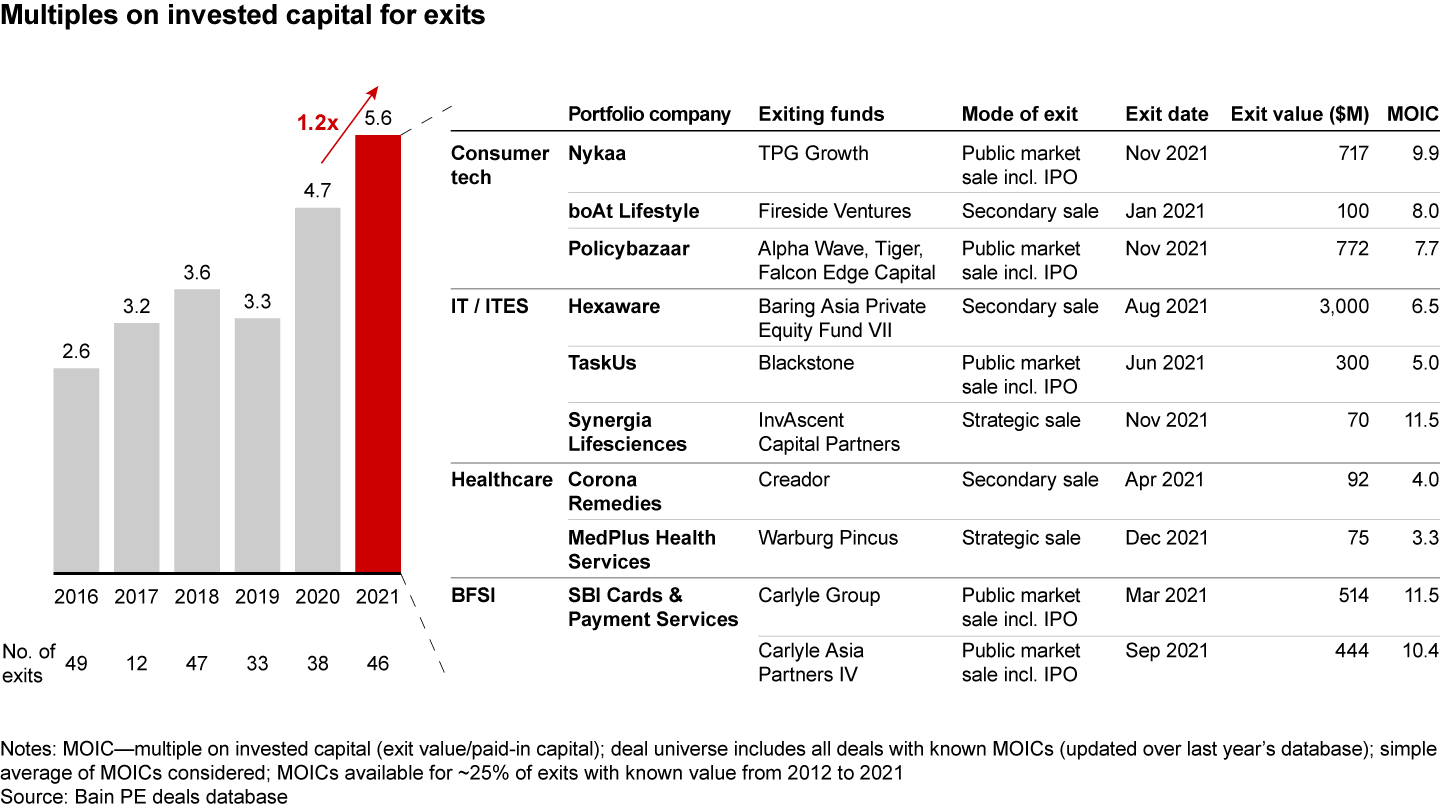
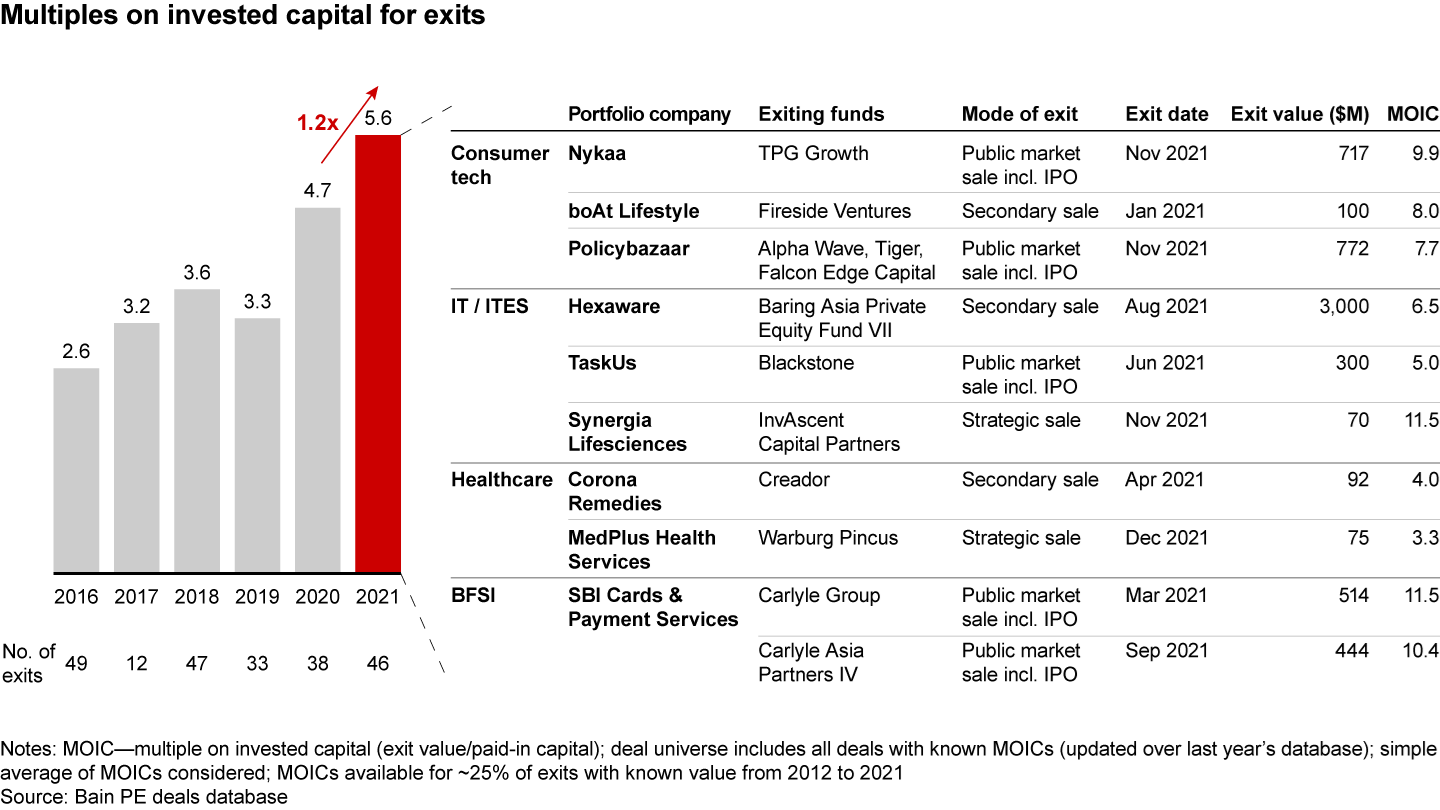
The ESG opportunity: Moving from compliance to value
- Funds increasingly view ESG criteria as a core consideration in investment decisions. The global acceleration toward ESG adoption has reached Indian shores, as many India-focused funds are increasingly looking for ways to embed ESG norms into their firms and portfolios.
- Research by Bain revealed that Indian funds expect ESG considerations over their PE AUM assets under consideration to grow to 90% over five years from now, up from only 39% five years ago, indicating a significant acceleration in ESG adoption across the sector.
- ESG is becoming increasingly relevant as it is used for mitigating future risks to portfolios, and LPs are advocating it as important criteria in fund strategy and value-creation plans.
- At 66%, India-focused funds view risk mitigation as a key driver for ESG adoption compared to peers in APAC, who view compliance as a more significant driver at 62%. India’s push on compliance as a key driver is significantly lower at 34%. At the same time, value-creation potential of ESG is increasingly gaining attention across both India and the rest of APAC.
- ESG is getting recognised as an opportunity for value creation and should be viewed as a differentiated driver of value across the full investing value chain. As funds explore how to raise better, invest better, own better, and exit better, they have an opportunity to emerge as leaders capturing outsized value from their initiatives. Firms have unlocked 3%–5% points of EBITDA from ESG levers, and this value is expected to grow.
- We examine emerging best practices of ESG leadership by studying the examples of two leading funds, an LP and a GP, in defining their own approach to embedding ESG in their funds and portfolios. To realise the full potential of ESG in value creation, these funds have articulated a core vision, set themselves up to ambitious targets, and integrated dedicated ESG teams. They embedded ESG across the investment lifecycle, supporting the funds’ and partner companies’ ESG goals

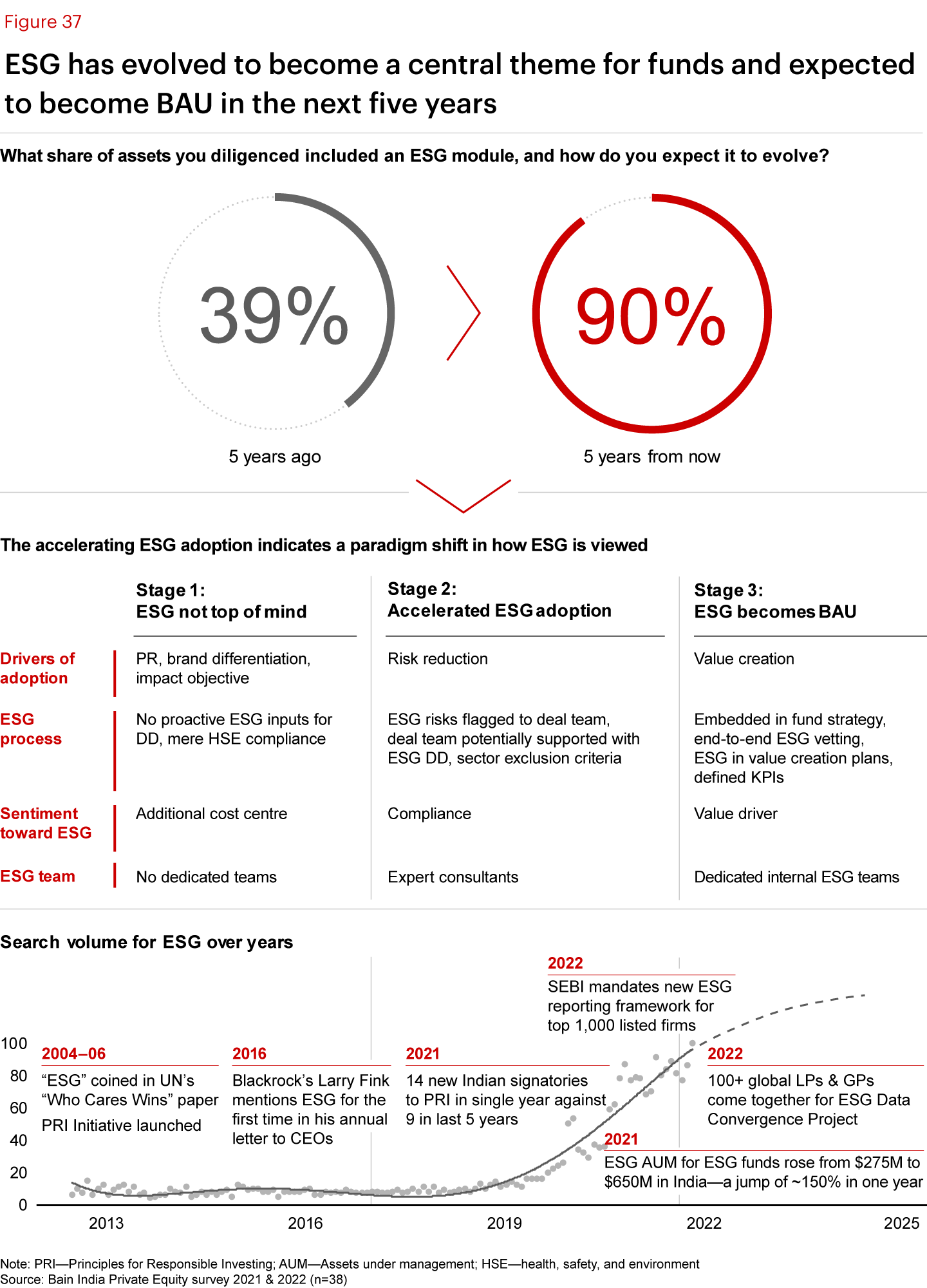
Indian funds are more inclined to pursue ESG to mitigate risk and face lower compliance pressures
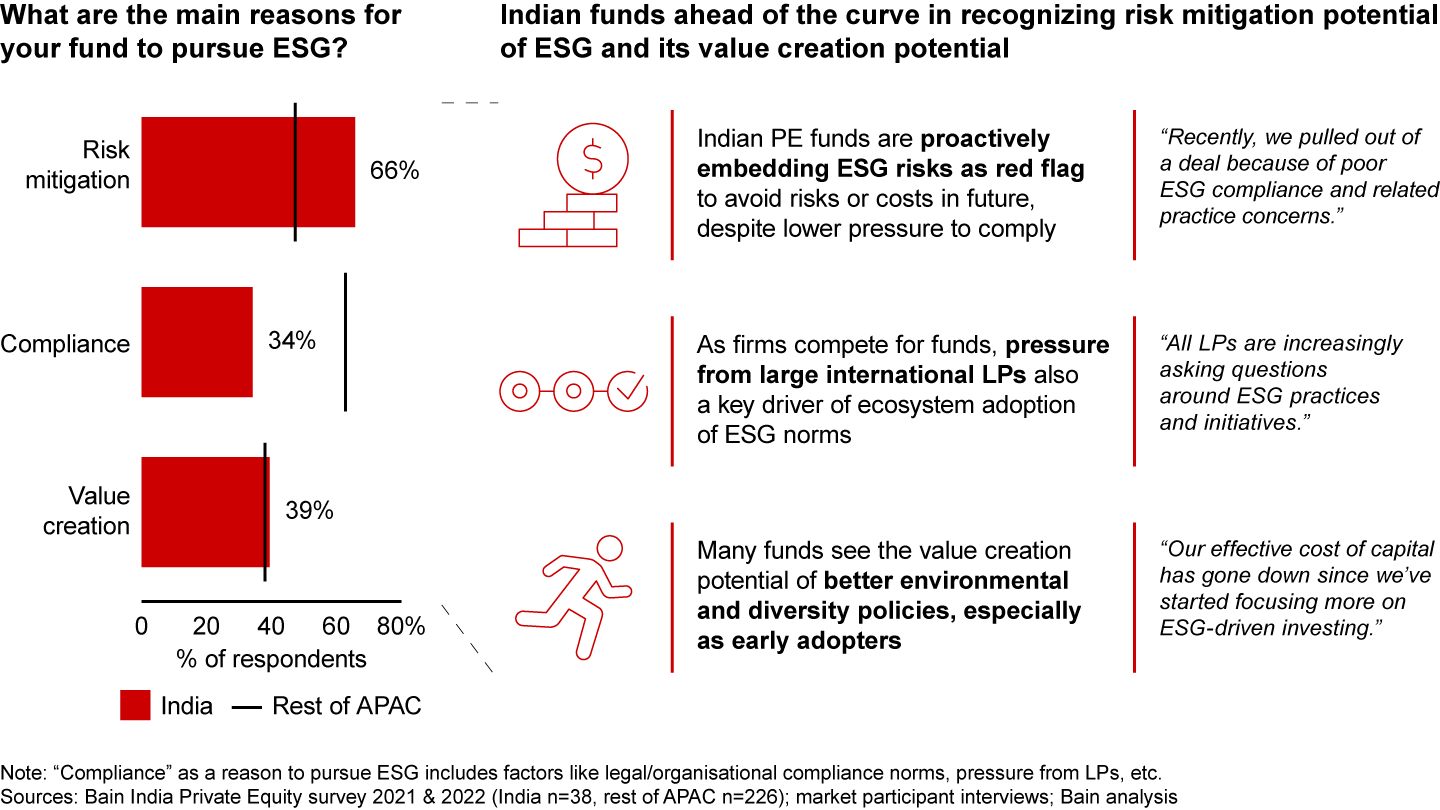
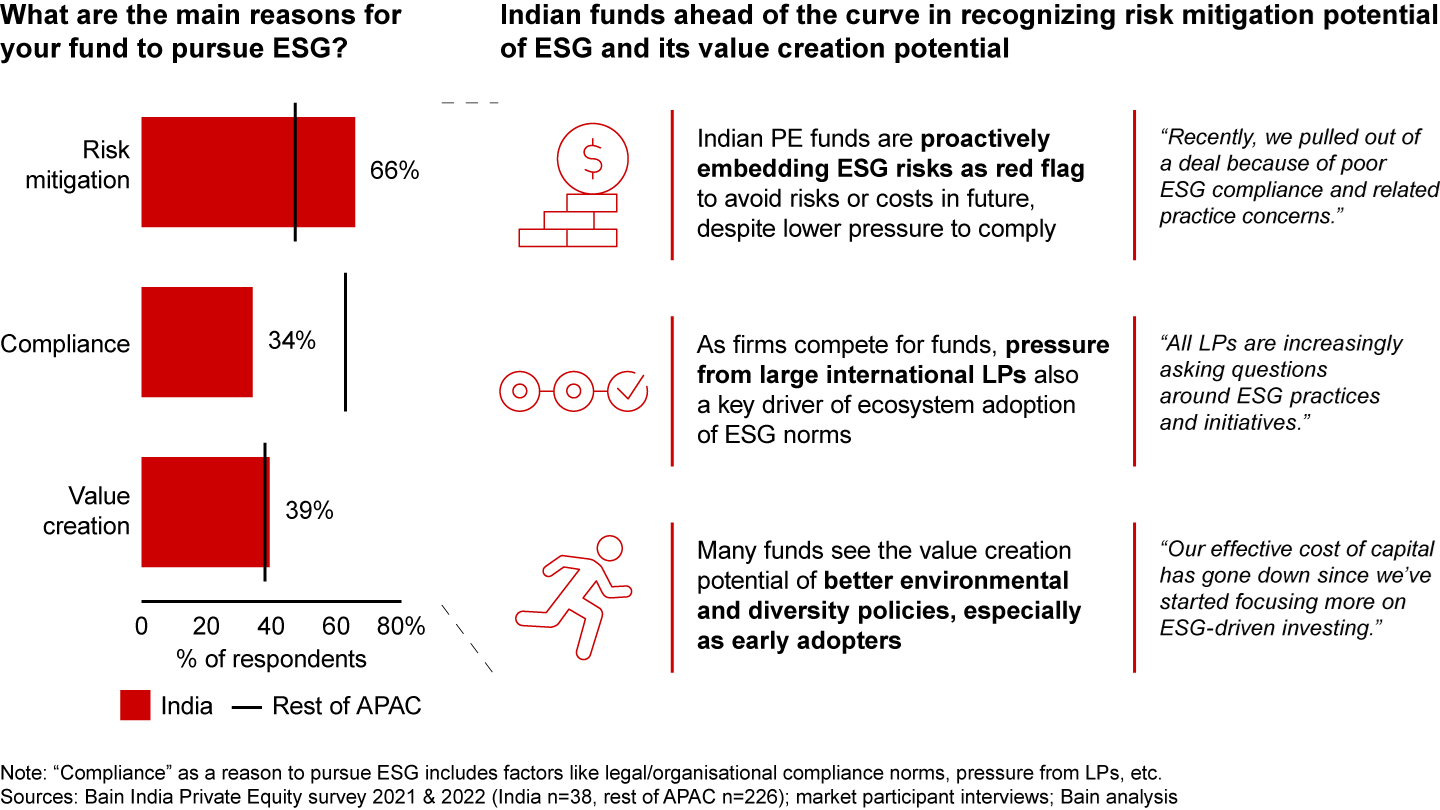
Funds need to look into their exposure to material environmental, social, and governance risks across sectors
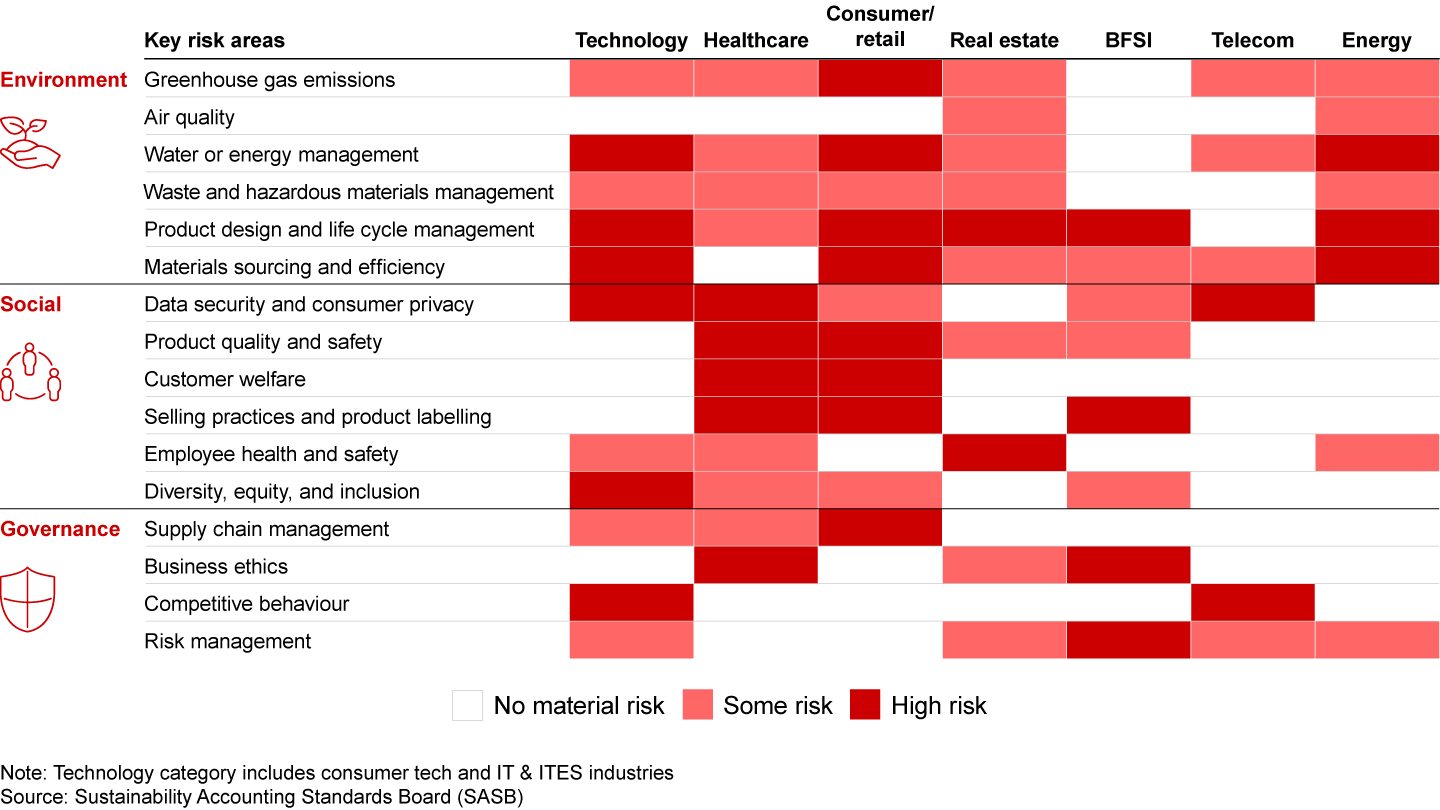
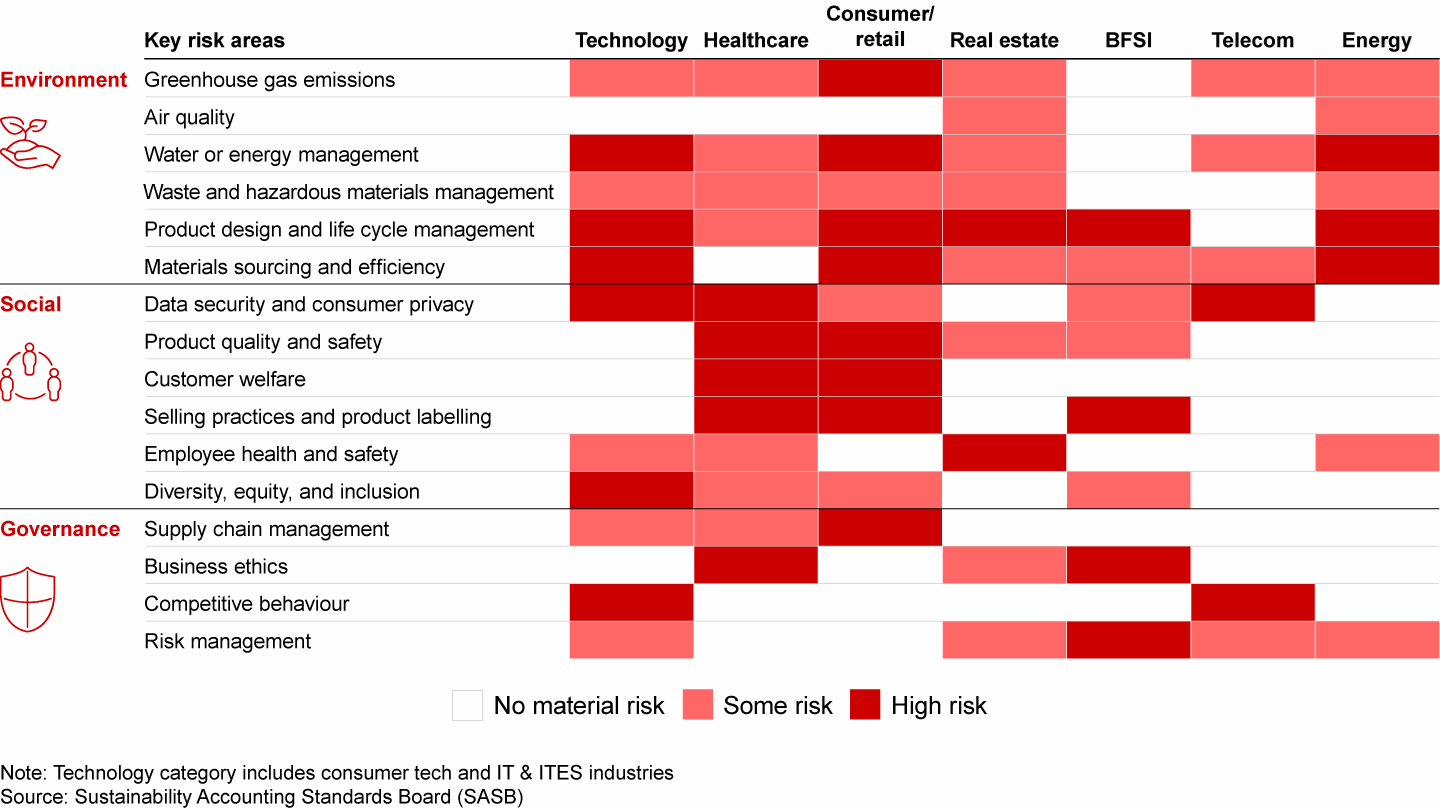
ESG is a differentiated driver of value across the full investing value chain
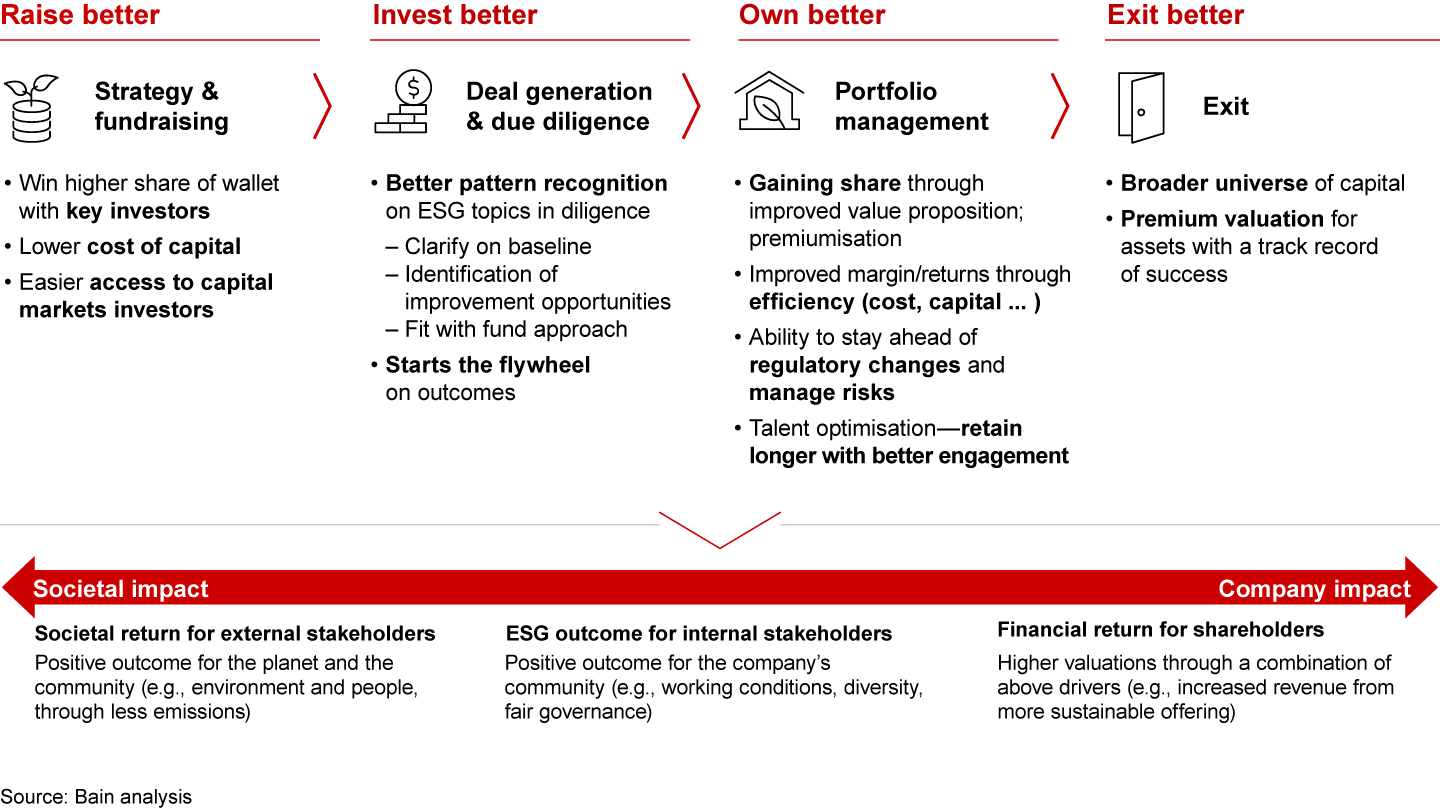
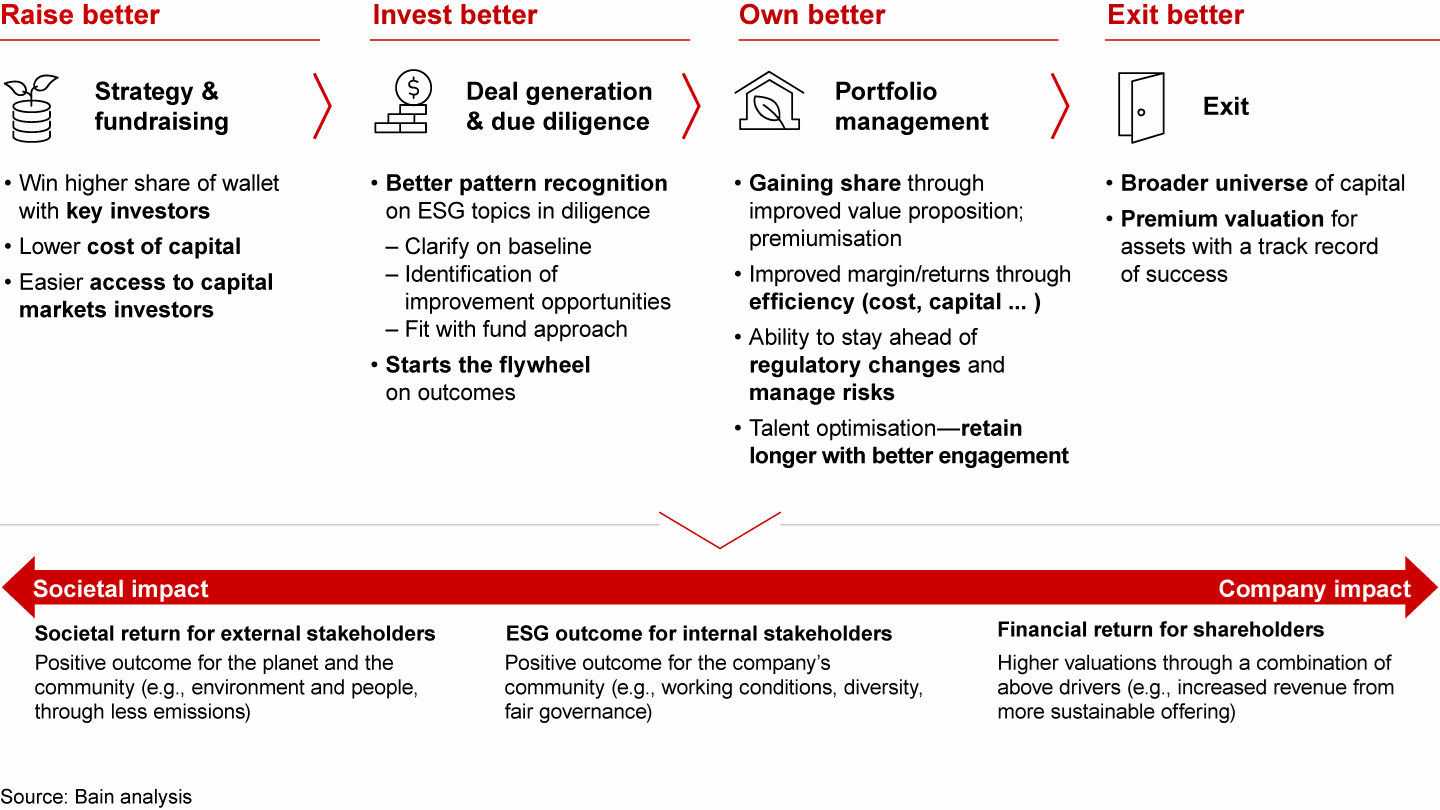
To create value, several funds are deploying ESG actions across their investment activities in India
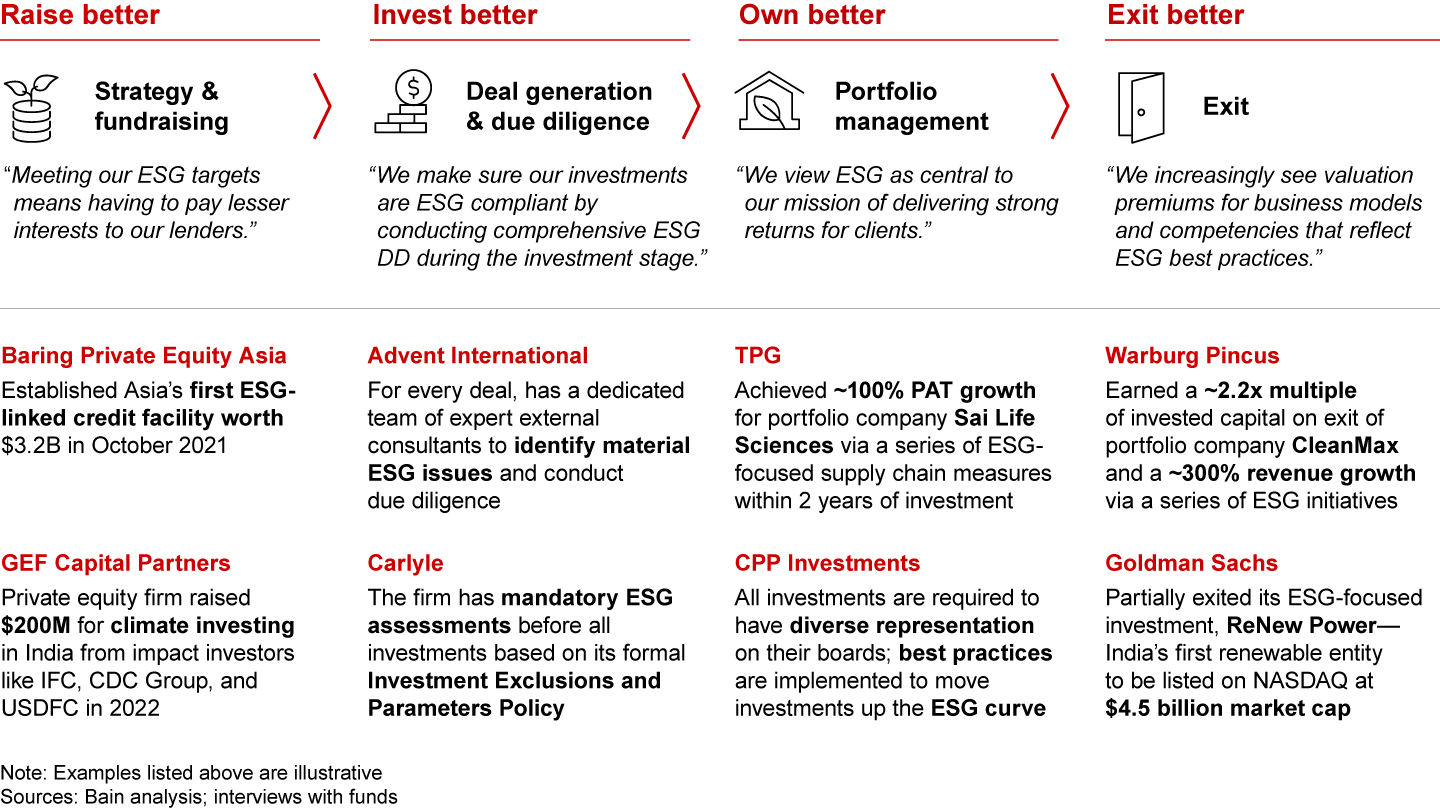
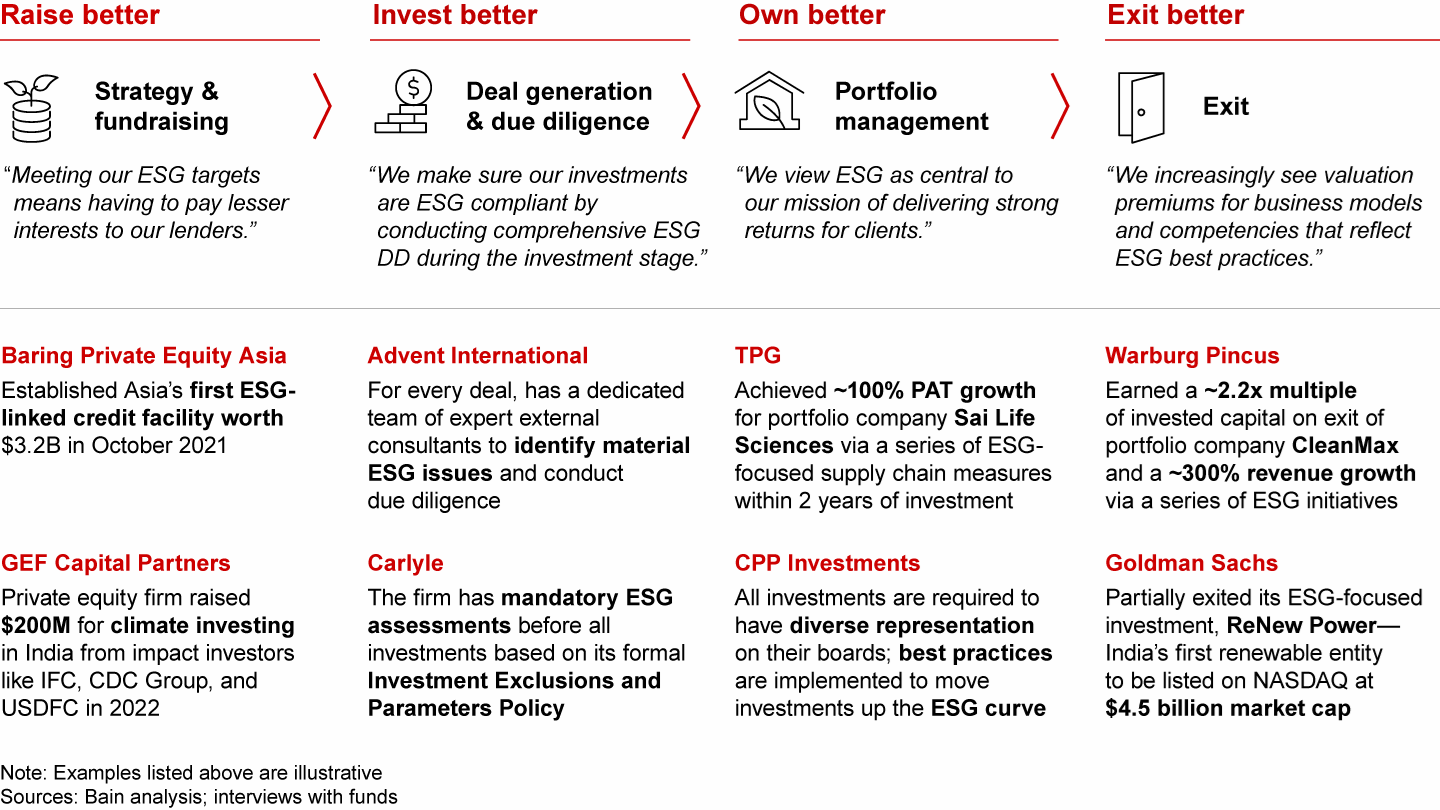
ESG levers hold potential to unlock ~3%–5% pts. EBITDA, a significant source of value creation for funds and portfolio companies
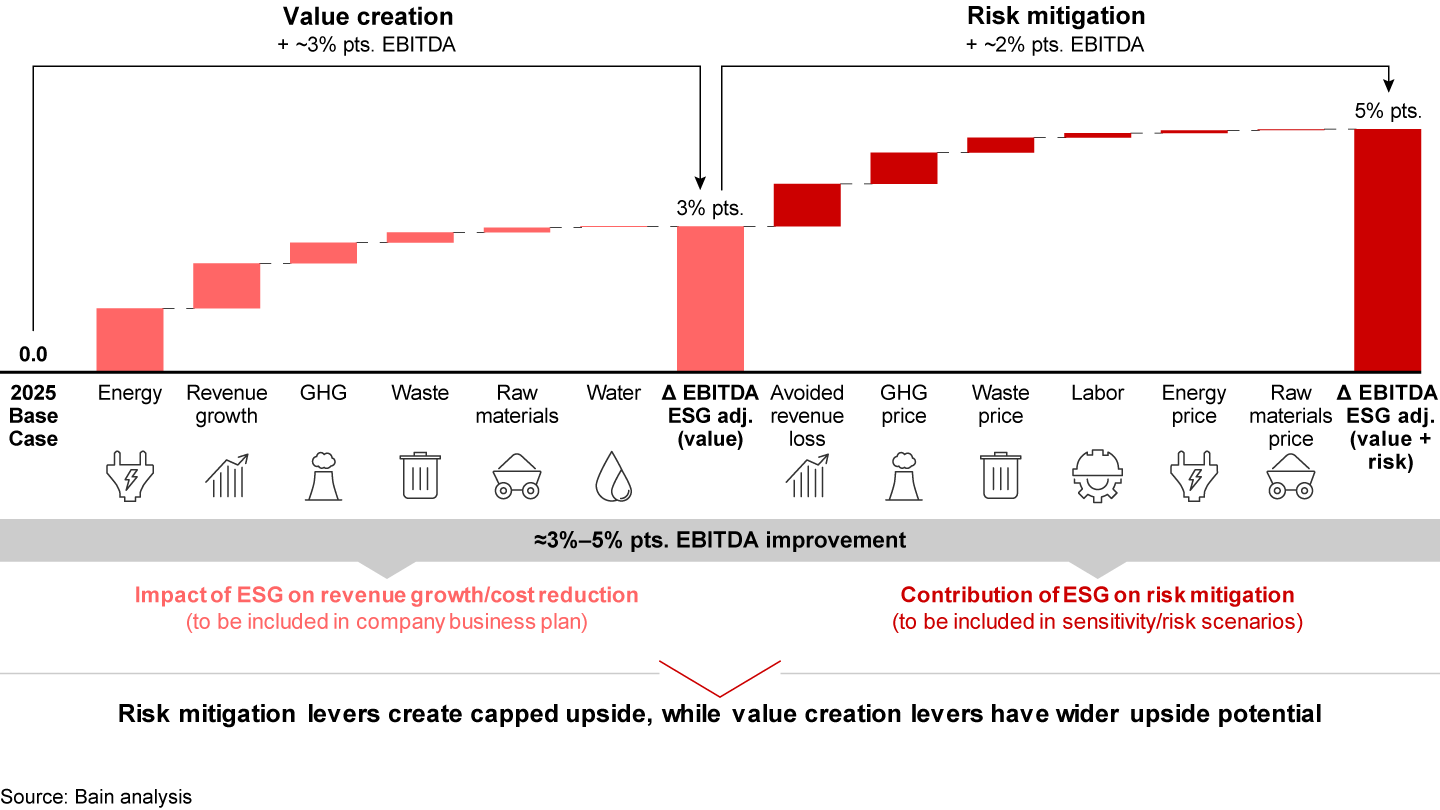
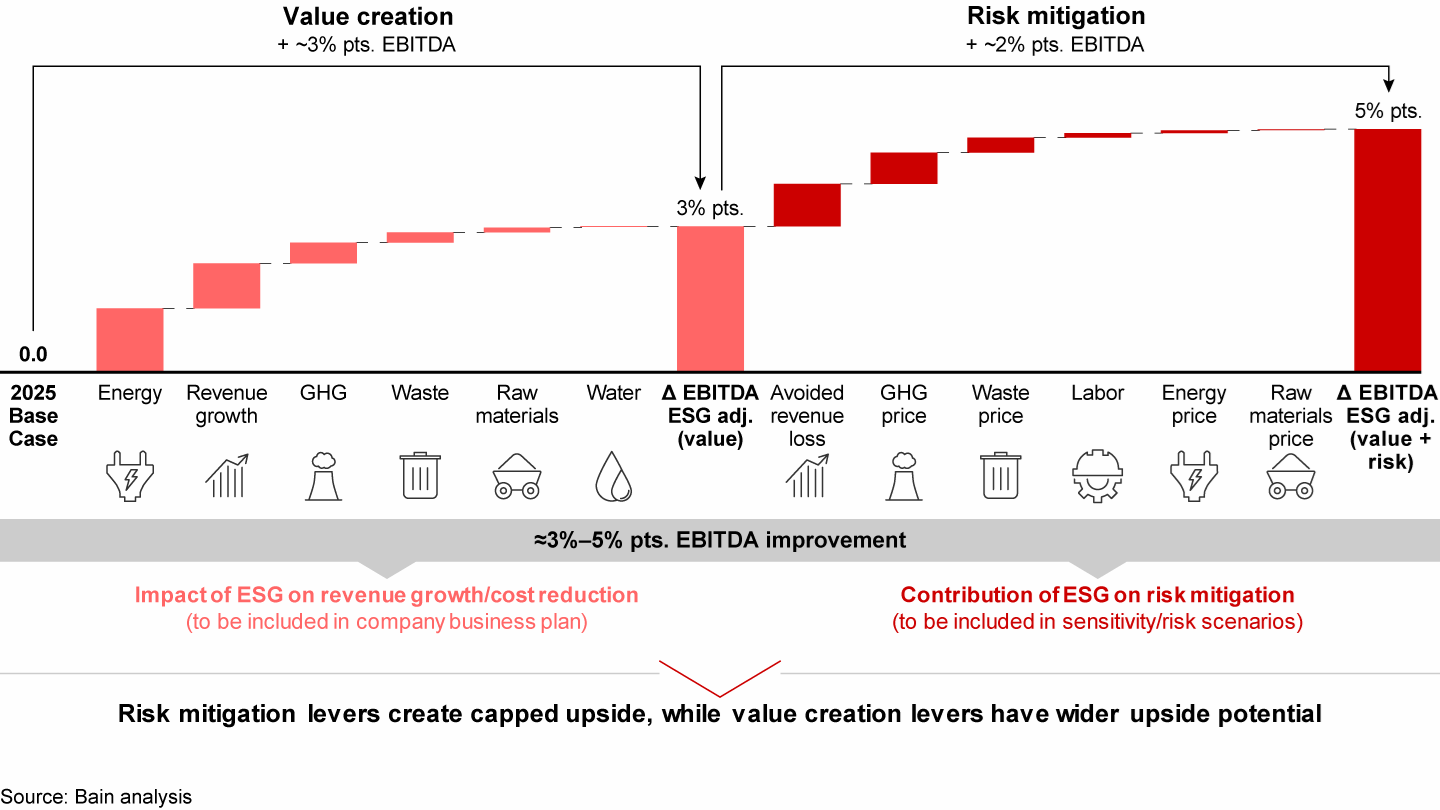
True North and CPPIB have exhibited strong ESG leadership through clear vision, targets, and governance model
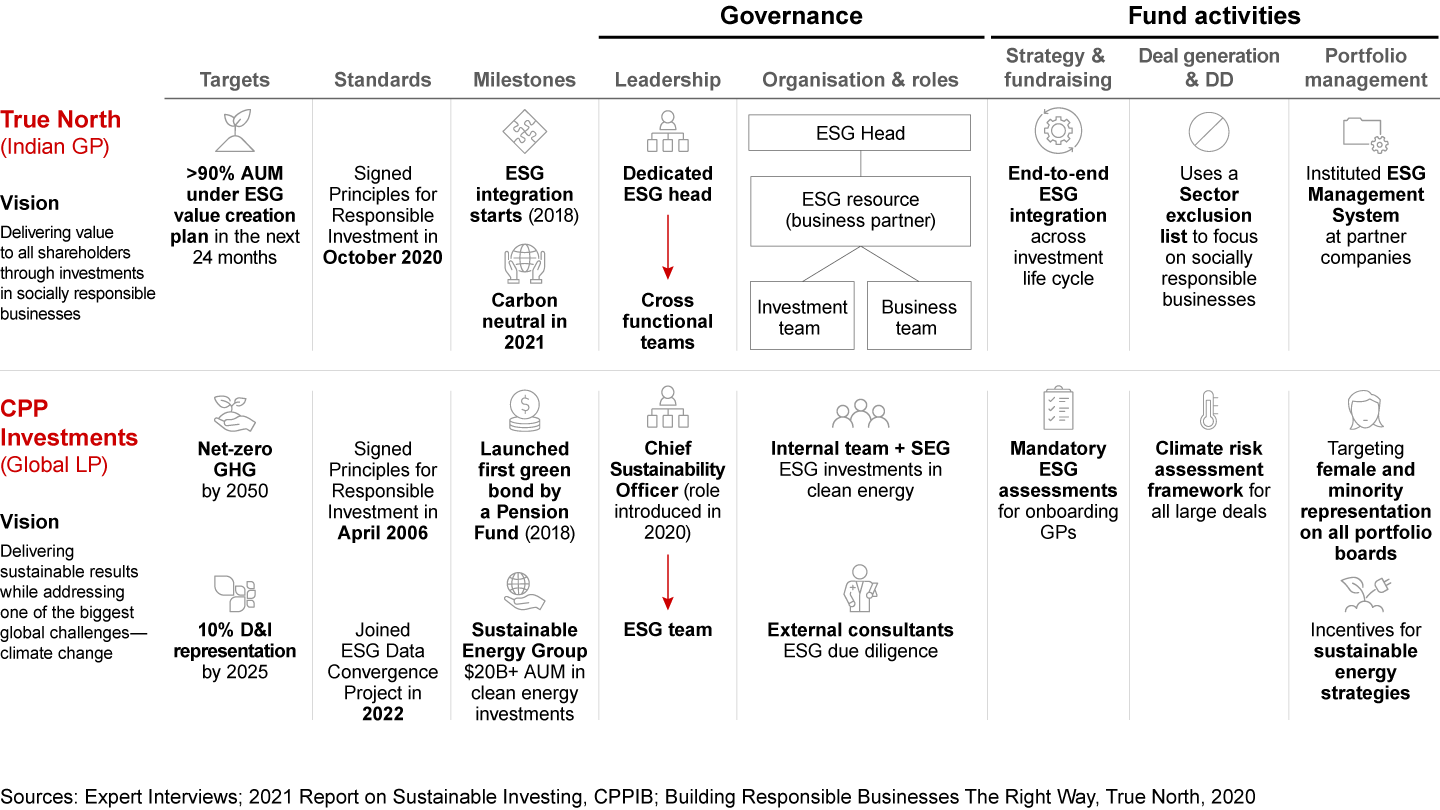
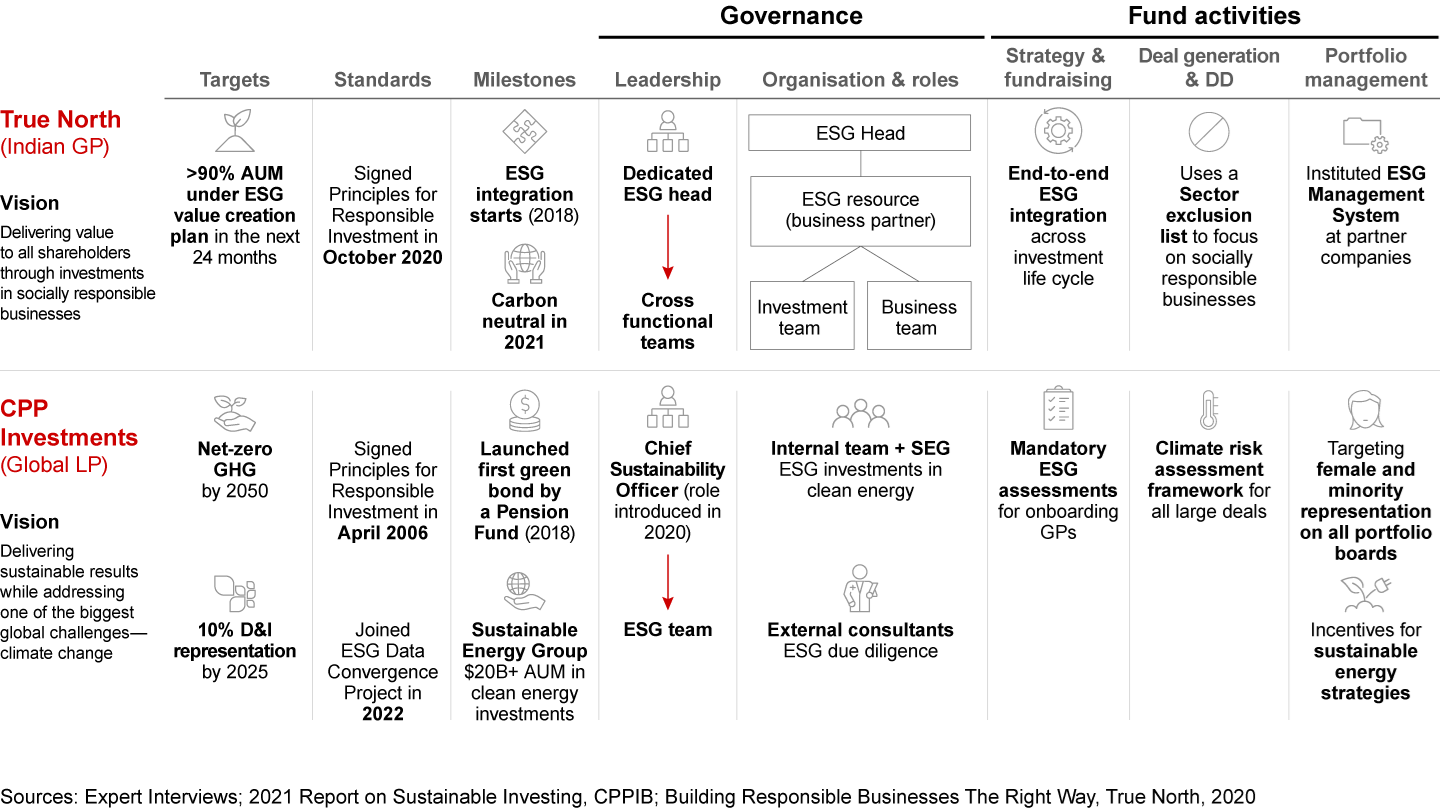
We see ESG as a value creation opportunity and a core differentiator for investors and their portfolio companies
